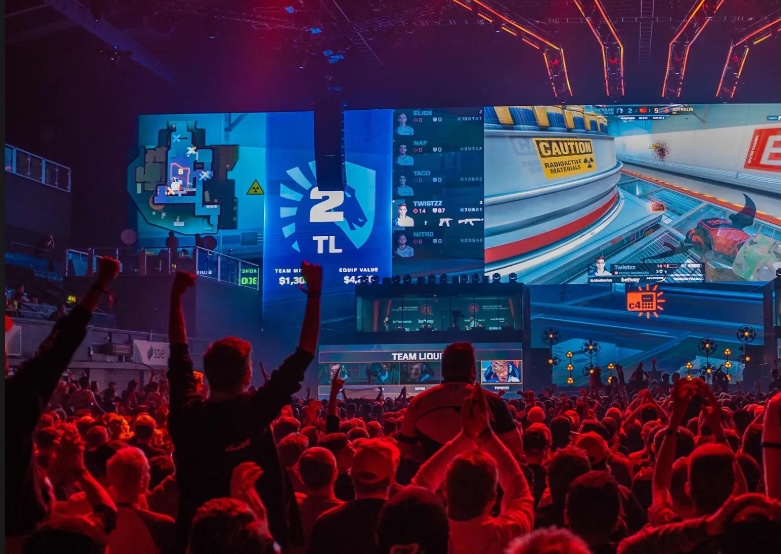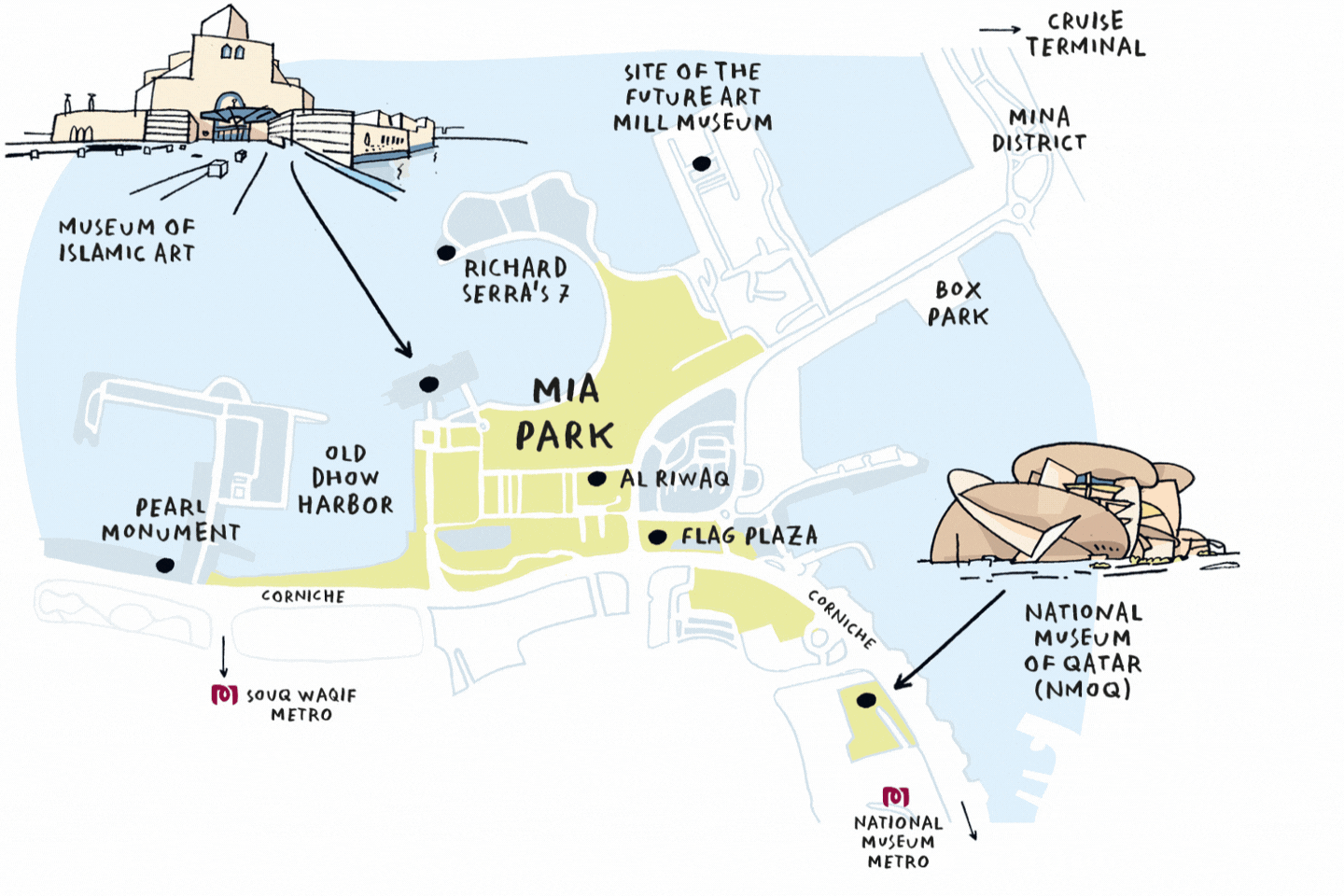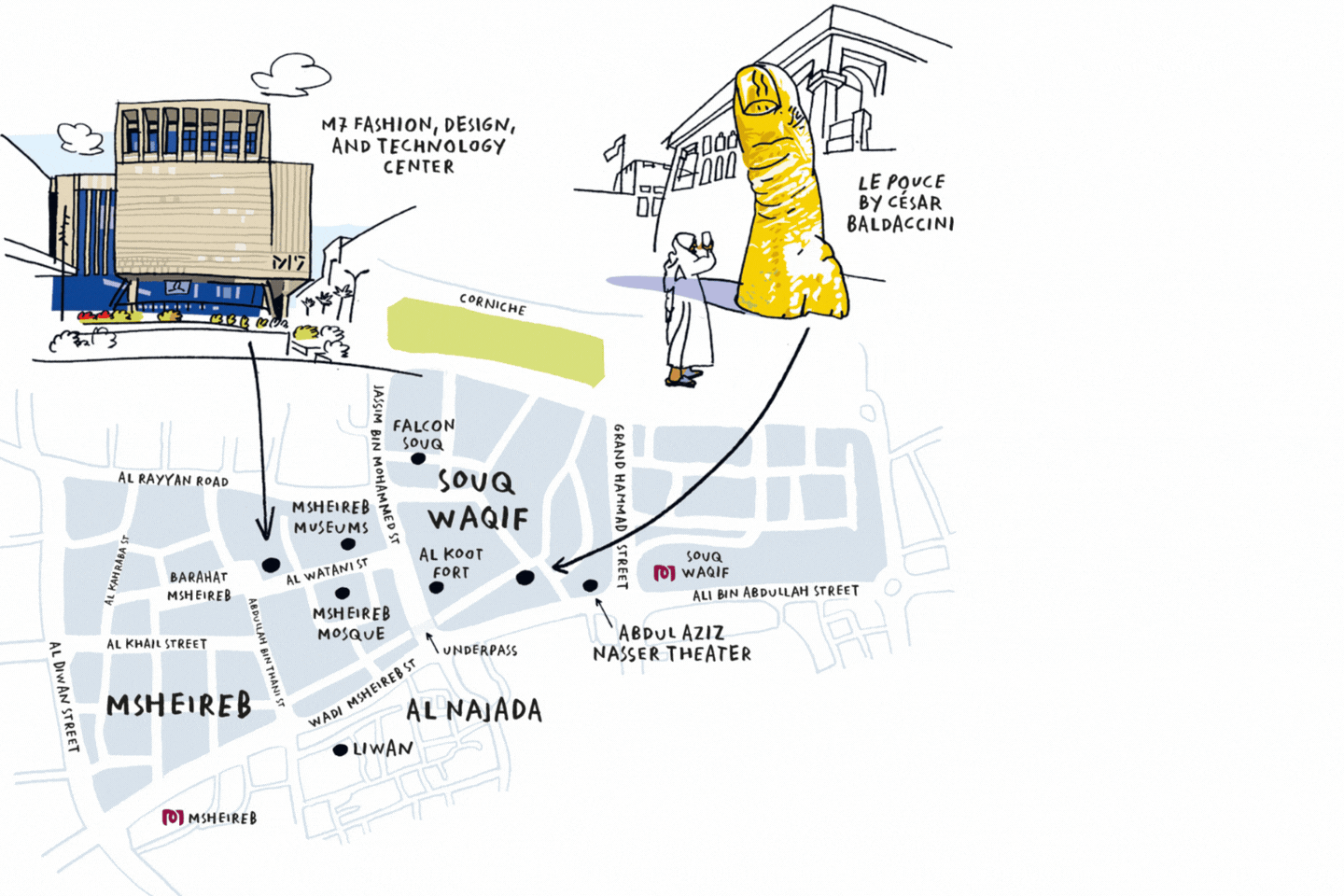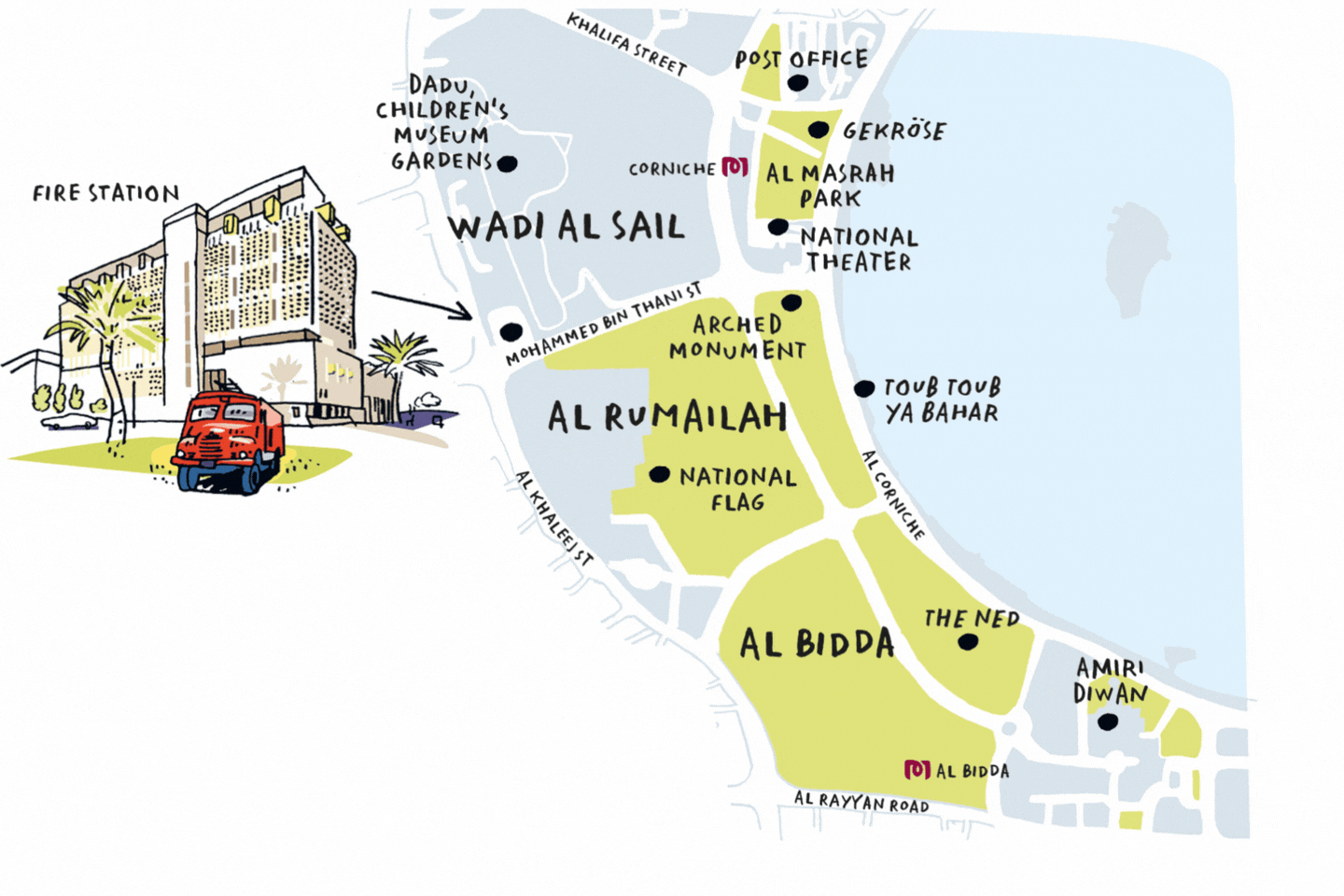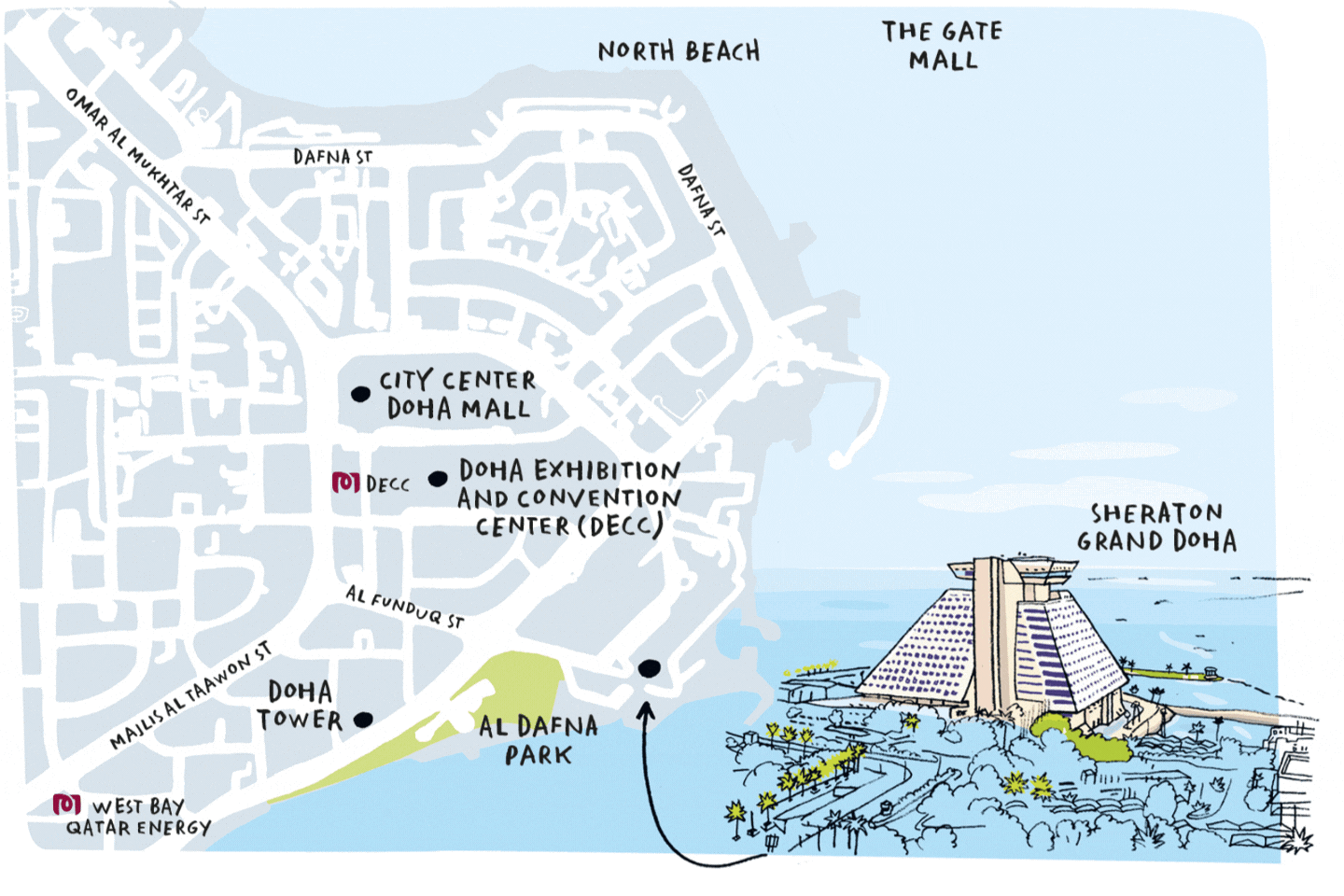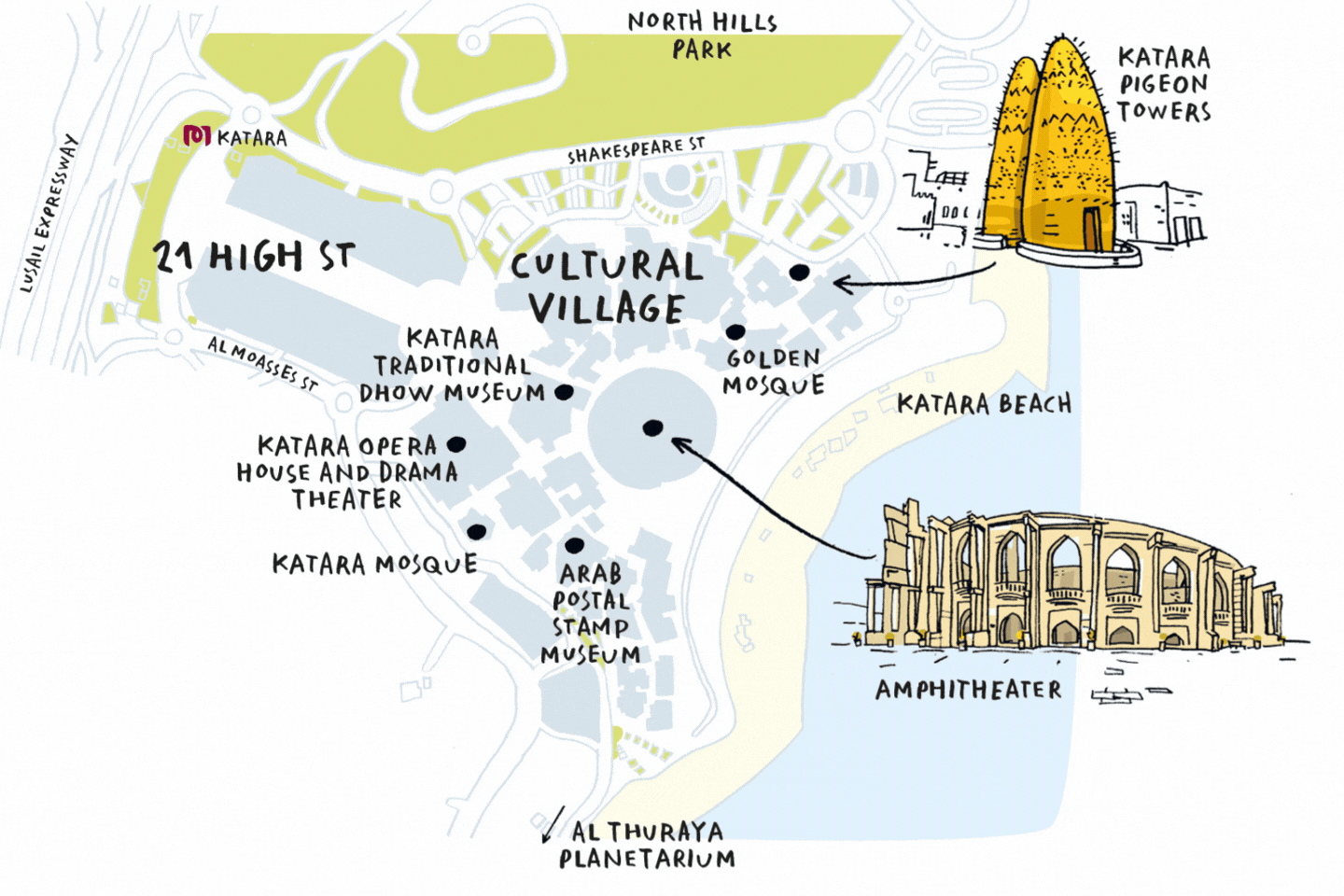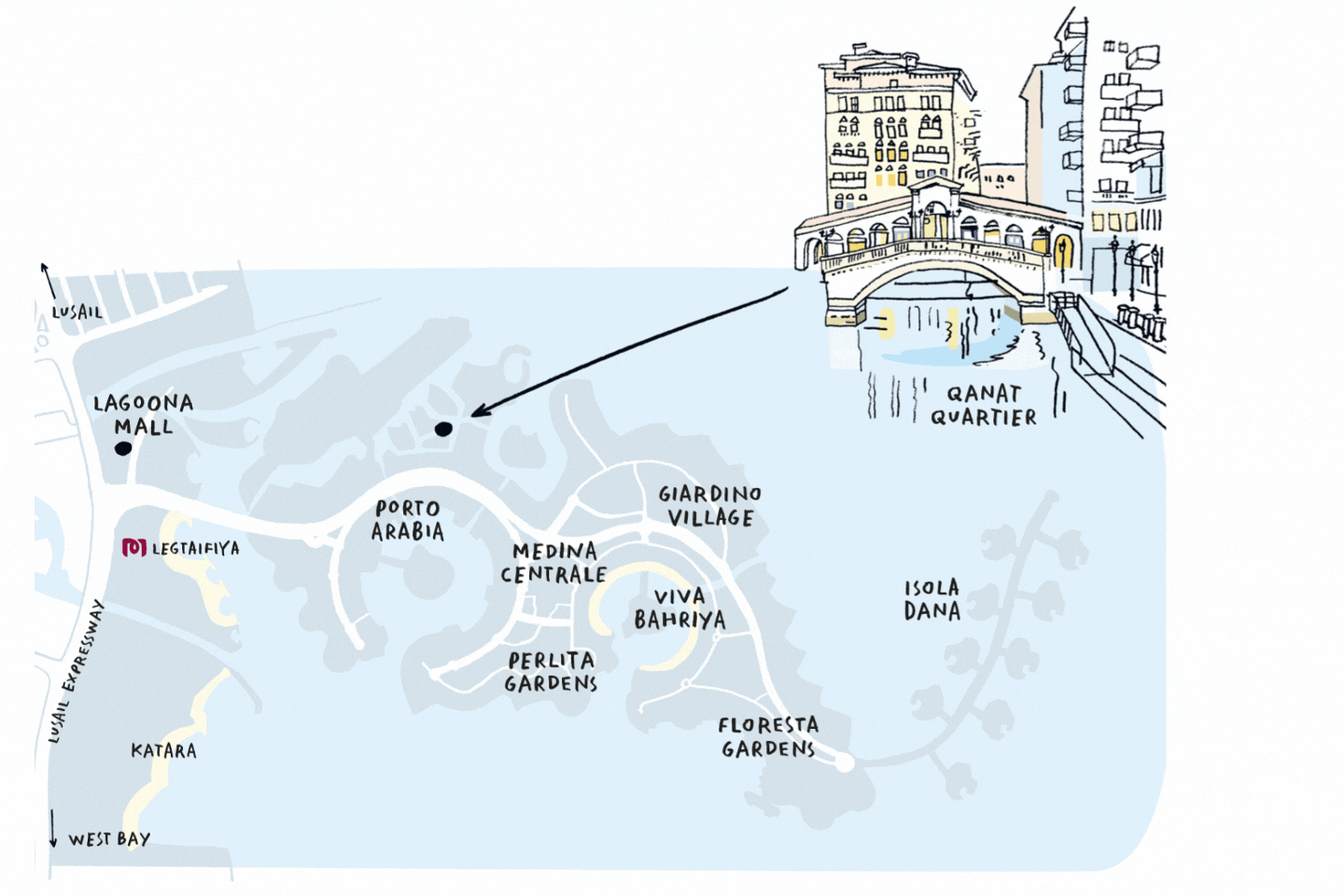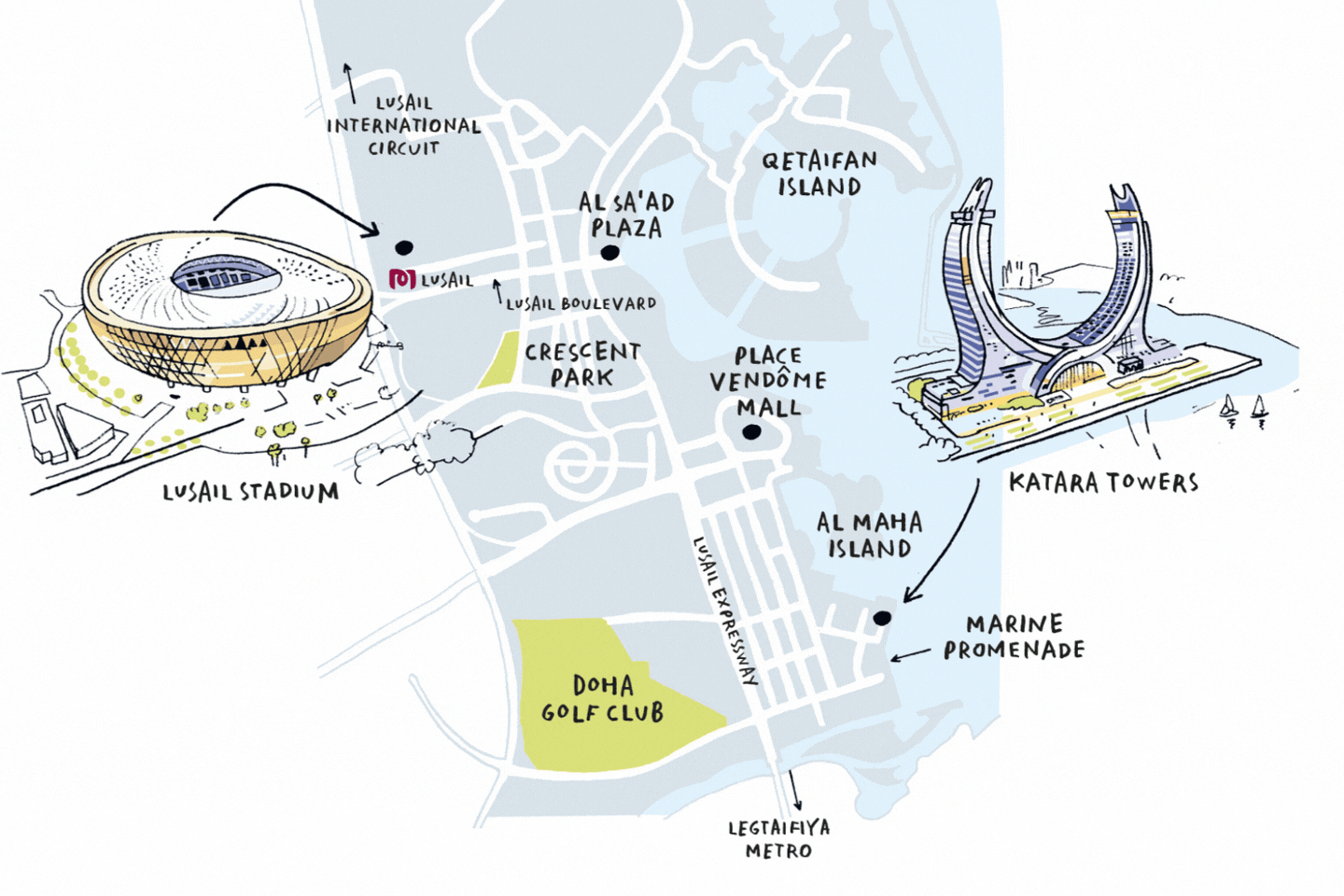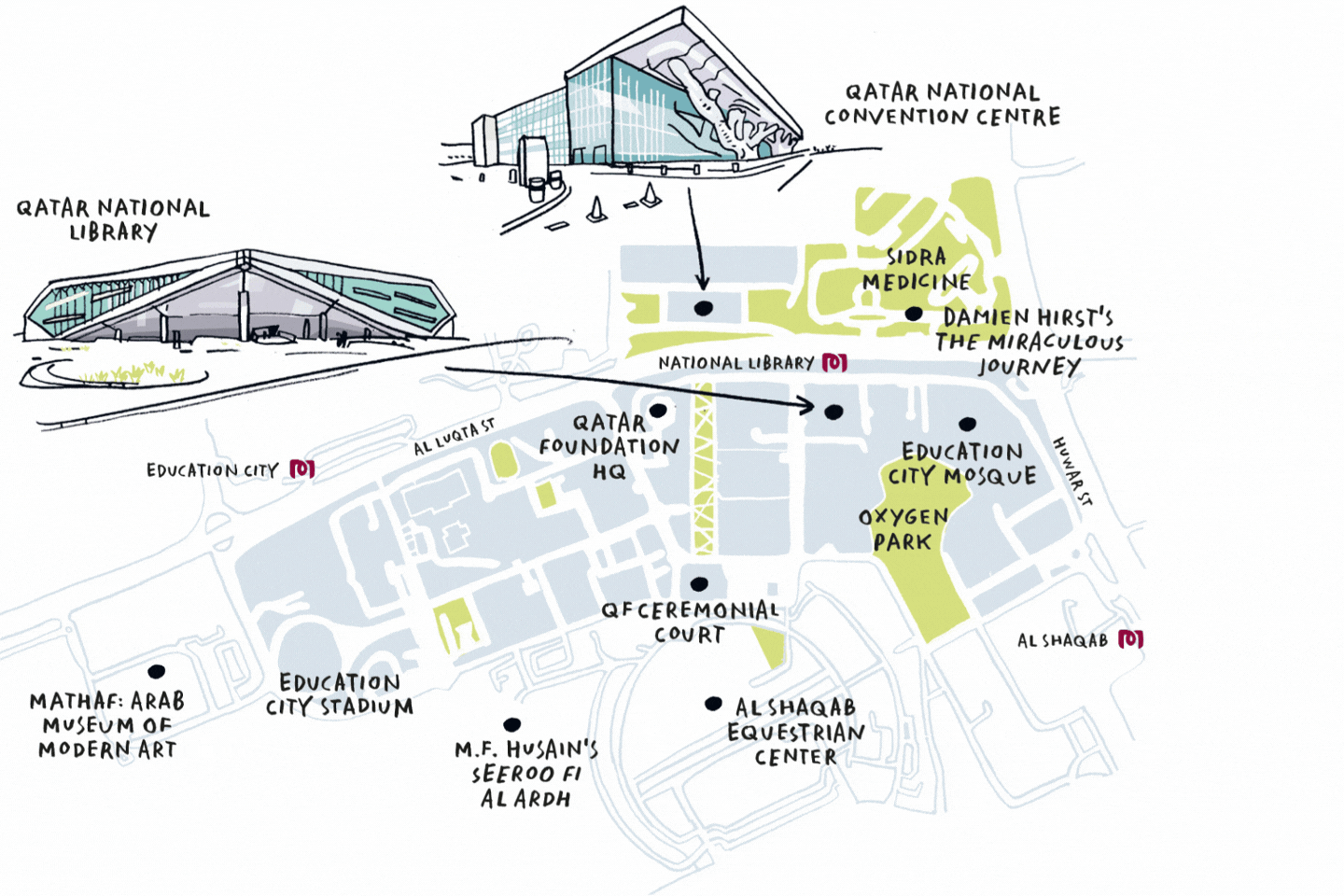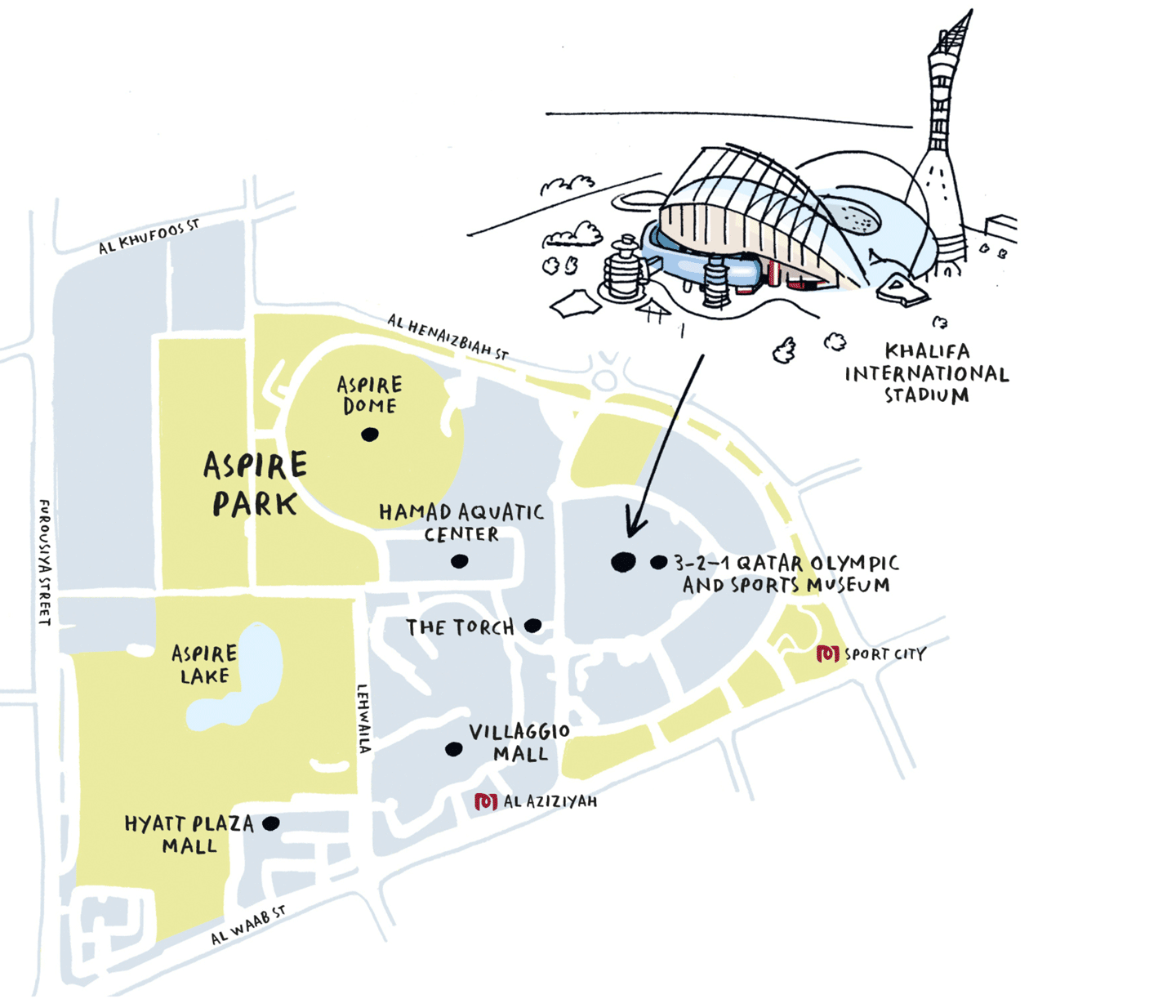
Qatar
Culture Guide
/Fall–Winter 2025–26
Hayakom fi Qatar!
Welcome to Qatar!
Whether it is your first time to our country or you are a regular visitor, I am happy that you are here. Qatar is a vibrant hub for arts, culture, design, architecture, and other creative industries, as you will soon see.
In this guide, I am pleased to share a snapshot of the culture, heritage, and countless attractions on offer across the country, and hope you will take the time to explore and experience as many of them as possible.
I truly believe that culture is the most powerful means of bringing people together, sparking the kind of dialogue that enables us to learn, grow, share ideas, and break down barriers. I hope you find this cultural guide helpful and enjoy all my country has to offer.
Al Mayassa bint Hamad bin Khalifa Al Thani

Contents
Neighbourhood Guides
Cultural Events Calendar
Exhibitions
Esports | A Game Changer
25 September–30 April 2026
Venue: 3-2-1 Qatar Olympic and Sports Museum
This exhibition tells the story of the fascinating global phenomenon of esports (short for electronic sports), a form of competition using video games that often takes the form of organised, multiplayer competitions. The exhibition covers the history of esports, socio-cultural challenges, and the future of the movement, as well as the logistical and financial aspects behind it. This exhibition is the first of its kind, a travelling show that experiments with digital kiosks and portals embedded in an inspiring design will include weekly retro esports competitions, featuring games such as Streetfighter II. Accompanying the exhibition will be an esports conference held in January in partnership with the Qatar Economic Forum, Doha Film Institute and Media City, an academic symposium on esports, along with educational workshops for the public and an esports education curriculum for schools.
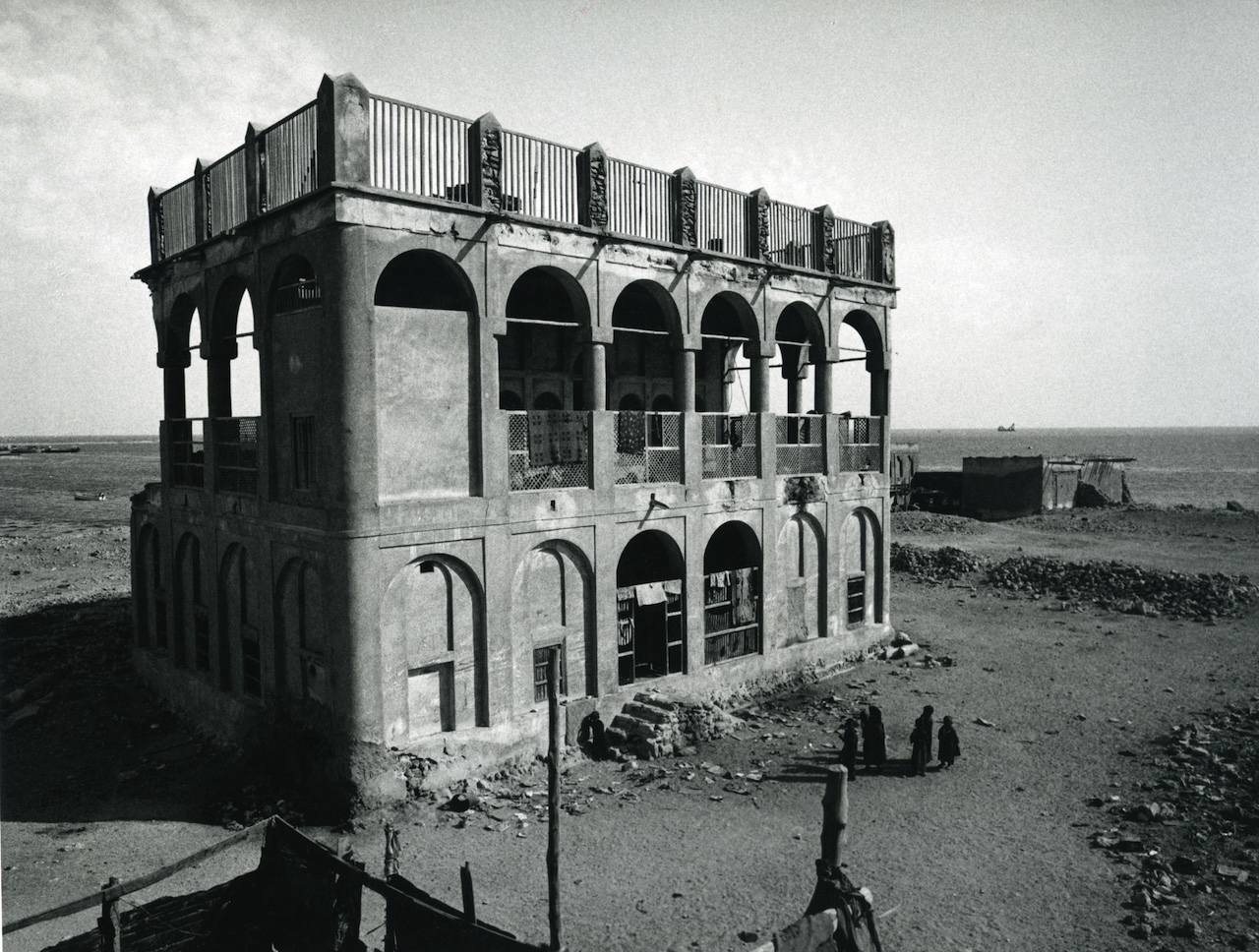
A Nation’s Legacy, A People’s Memory: Fifty Years Told
23 October–31 January 2026
Venue: National Museum of Qatar
Inaugurated in 1975 in a former royal palace, and later relaunched in a new building designed by renowned architect Jean Nouvel in 2019, the National Museum of Qatar is one of the country’s most prominent cultural landmarks. The museum is more than just a means of exploring the country’s cultural heritage, it is a physical embodiment of history, renewal and Qatari identity. In this 50th-anniversary exhibition visitors can learn about the origins of the museum in the early 1970s, when it was decided that a museum should be built that would capture the traditional Qatari way of life before it was irrevocably lost due to the rapid social and economic changes brought about by the exploitation of the country’s natural resources.
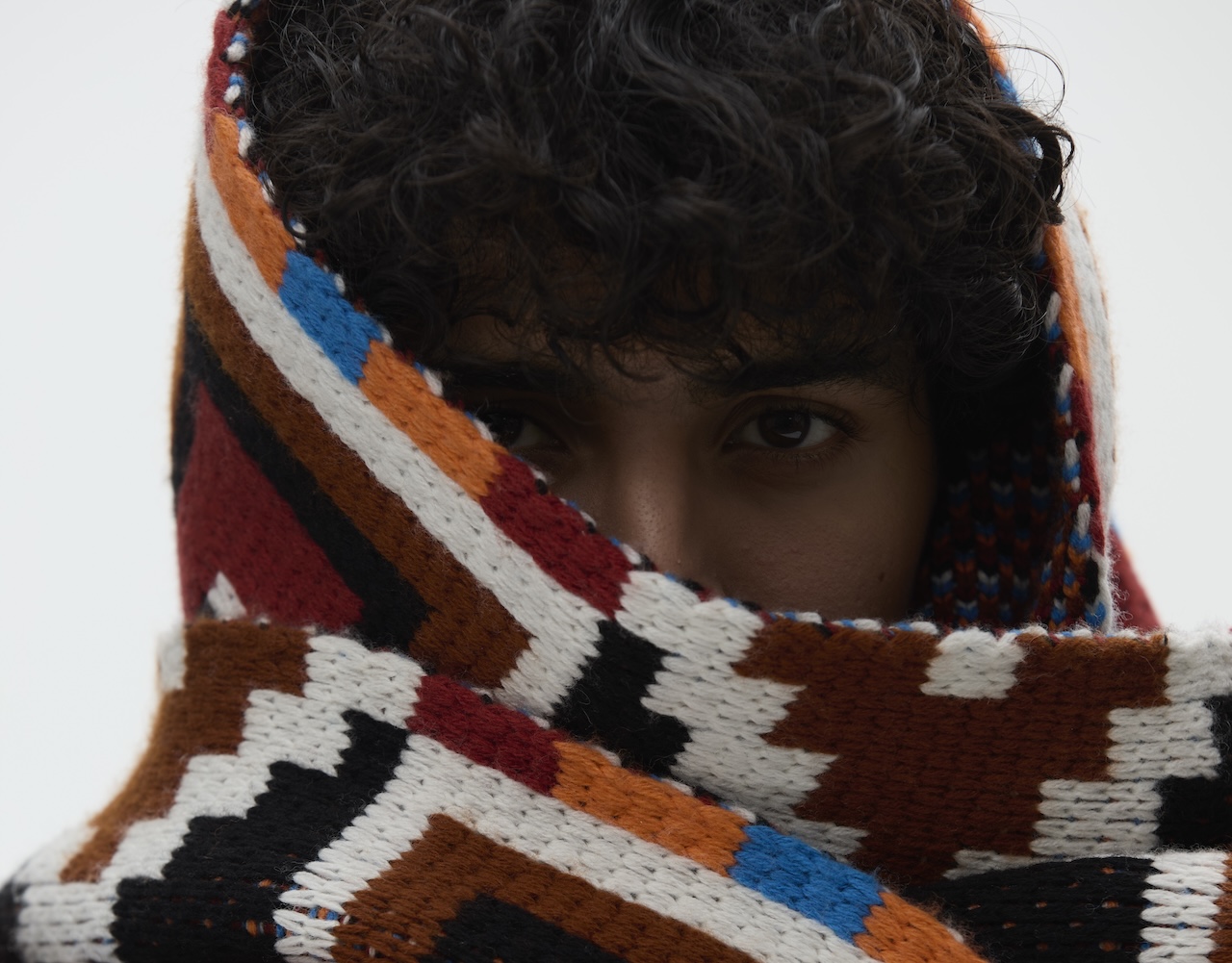
Threads of Impact: Celebrating Seven Years of Fashion Trust Arabia
26 October–3 January 2026
Venue: M7
This exhibition celebrates the transformative impact of Fashion Trust Arabia (FTA) and its bold vision for the future of fashion. It honours the profound influence FTA has had on its beneficiaries while charting a path toward a more sustainable and innovative fashion landscape. Inspired by the architectural elegance of Doha and the storytelling traditions of the Middle East and North Africa (MENA) region, the exhibition weaves a vibrant tapestry of culture, craftsmanship and creativity. The various sections document a conversation between tradition and innovation, artisanship and technology, sustainability and progress brought to life through the work of FTA.
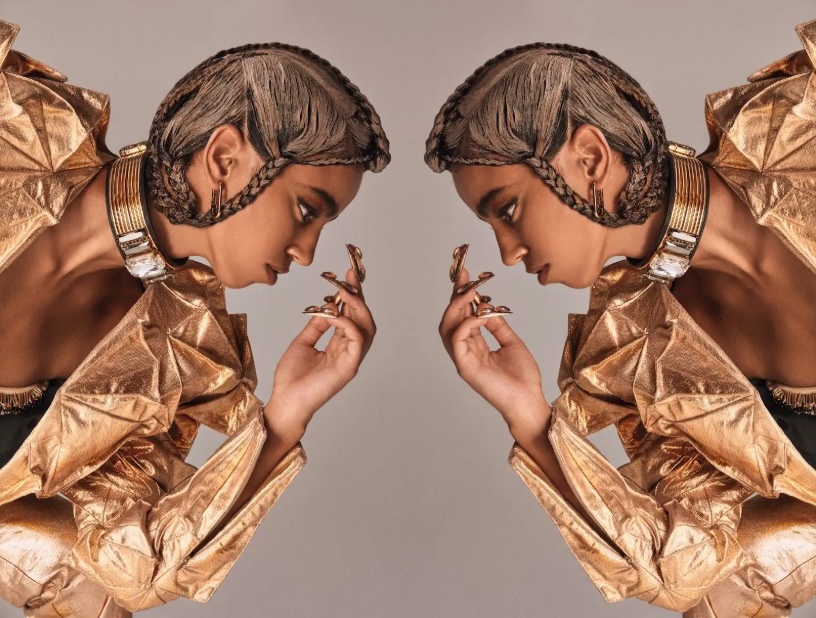
Amazigh Hair Couture
26 October–12 January 2026
Venue: M7
At the heart of Morocco’s vibrant culture lies an exquisite tapestry of hair heritage, a narrative rich in history, identity and artistry. This presentation weaves through time, unveiling the significance of traditional Moroccan Amazigh hairstyles, each braid and twist a testament to centuries of cultural intermingling and expression. It is a story in which hair is more than mere beauty: it’s a symbol of belonging, a marker of societal roles and a cherished link to ancestral roots. Moroccan hair heritage also emerges as a source of inspiration for the modern fashion world, and the exhibition showcases how the threads of history are fashioning the trends of today.
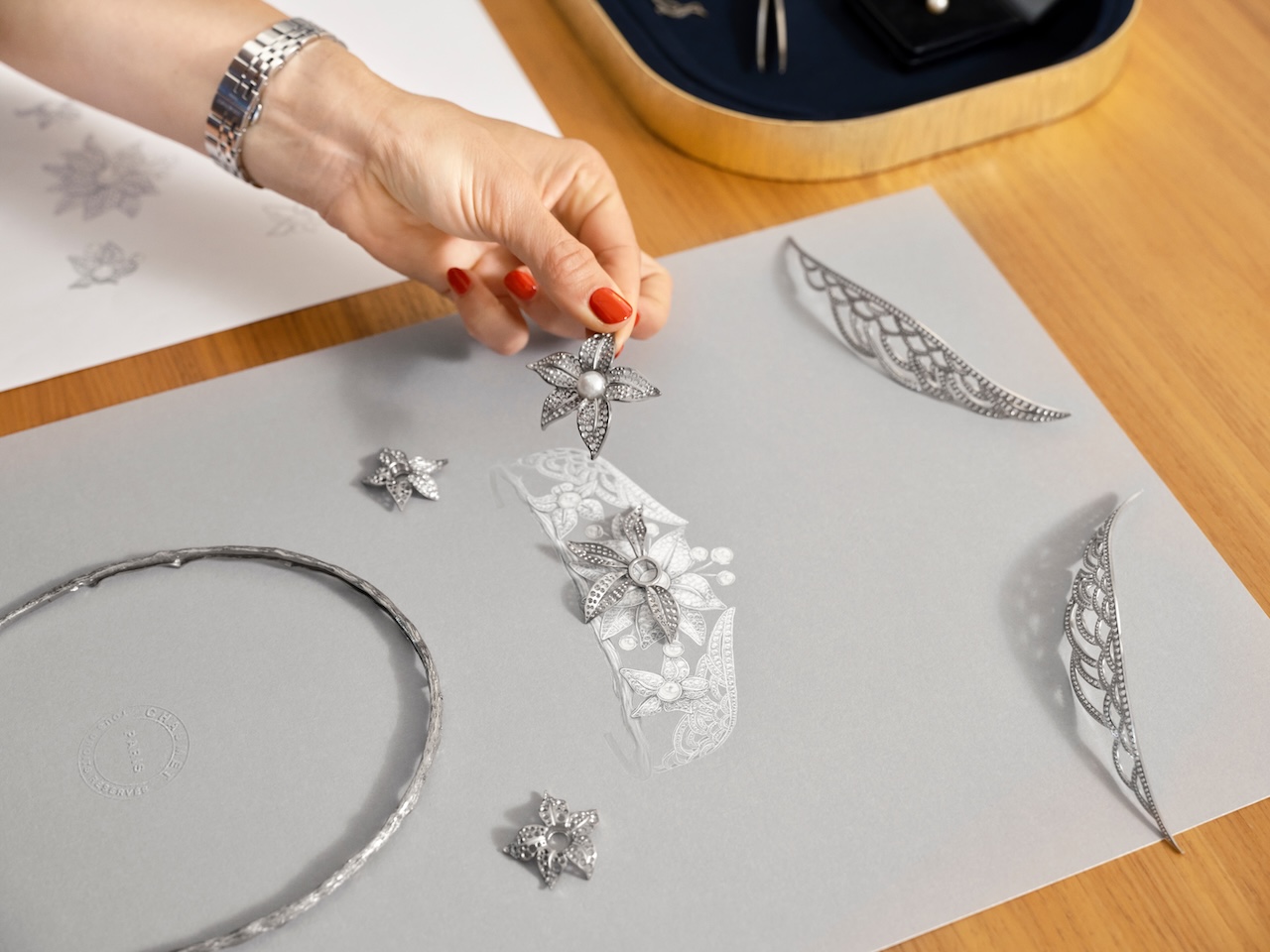
Houbara Haven: a Chaumet Tiara
26 October–17 January 2026
Venue: M7
Building on the legacy of the Chaumet & Nature exhibition held in Doha in 2024, Maison Chaumet, in collaboration with M7, extended a unique invitation to artists and designers from the MENA region to create a bespoke tiara that would harmonise cultural heritage with the natural world. The resulting design has been crafted by Chaumet and takes the form of a tiara featuring exceptional pearls from Alfardan Jewellery, the renowned Qatari company founded in 1954. It is a testament to personal storytelling and collaboration, and highlights the region’s extraordinary creative talent.
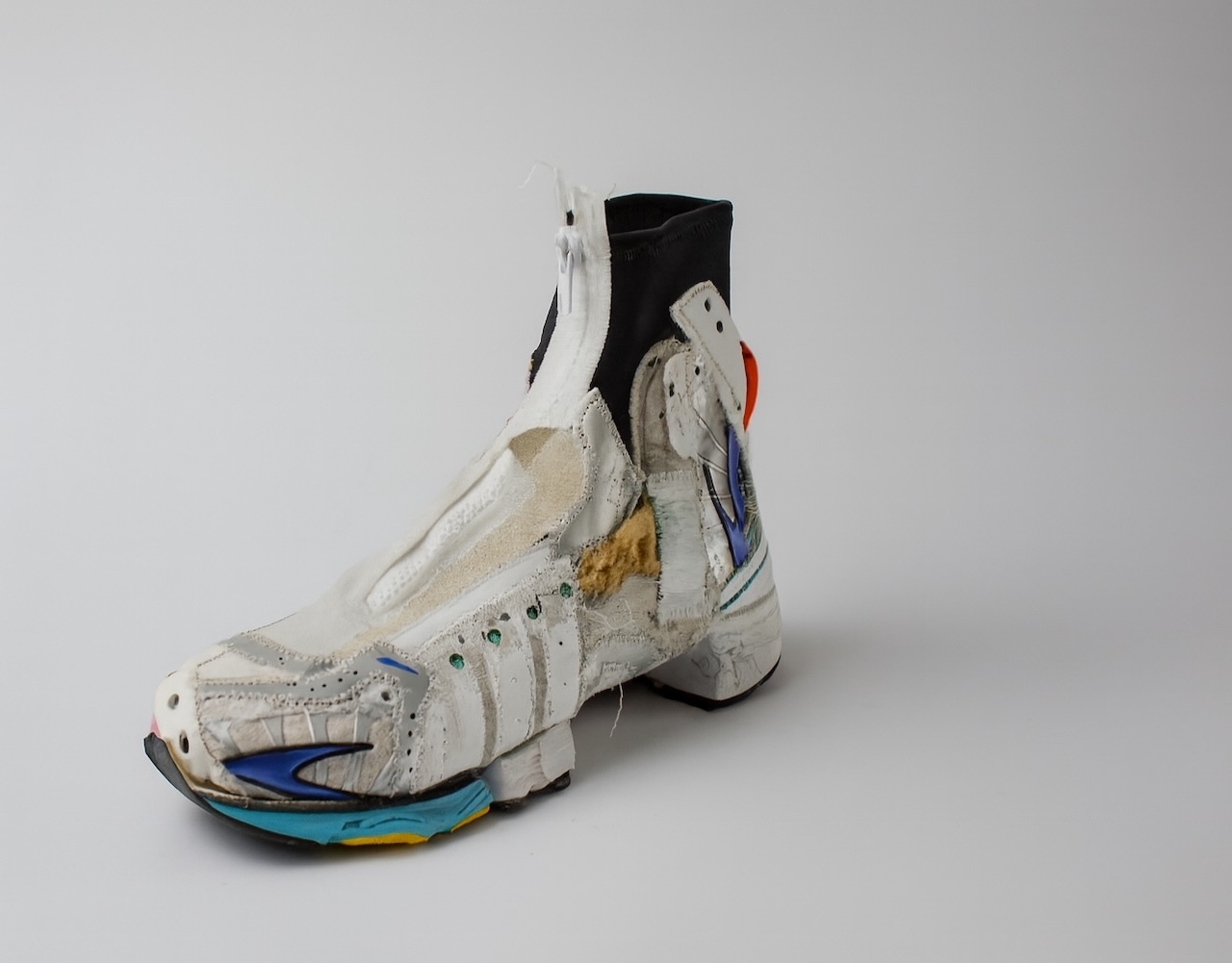
Sneakers Unboxed: Studio to Street
28 October–7 March 2026
Venue: 3-2-1 Qatar Olympic and Sports Museum
Sneakers Unboxed is a travelling exhibition that tells the story of one of the most universal of design objects, bought and worn by millions of people worldwide every day. Charting the design and cultural journey of sneakers, shoes originally designed for athletic activities, the exhibition explores how they have been adopted as essential signifiers of style, particularly by the young. The exhibition consists of around 500 objects, including more than 200 pairs of sneakers, plus dozens of contextual images, films and archival items.
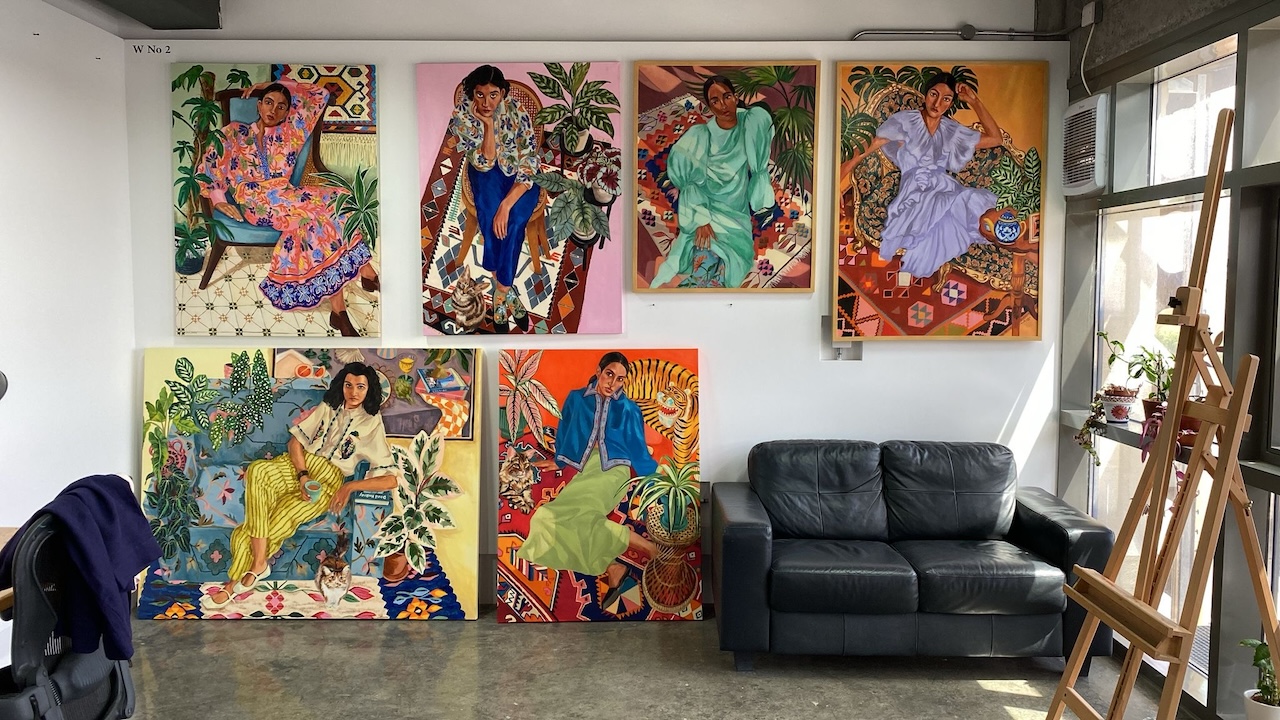
AIR 9: Portals in Flux
27 October–31 December
Venue: Fire Station
Created by 15 Qatar-based artists, the works in this exhibition, held as part of Fire Station’s artists-in-residence (AIR) programme, reflect a shared fascination with environments, both external and internal. Whether rooted in the desert, the cosmos, the rituals of daily life or the intimacy of home, each piece is anchored by a central element. Around this anchor layers of meaning unfold, shaped by sensory cues, symbolic gestures and spatial presence. These new works emerged from a nine-month process of research, experimentation and deep inquiry in which the artists were encouraged to challenge their practices by exploring unfamiliar materials, production techniques and conceptual directions. The result is a rich body of work that stirs the senses and opens the imagination: evoking sound, texture, scent and atmosphere.
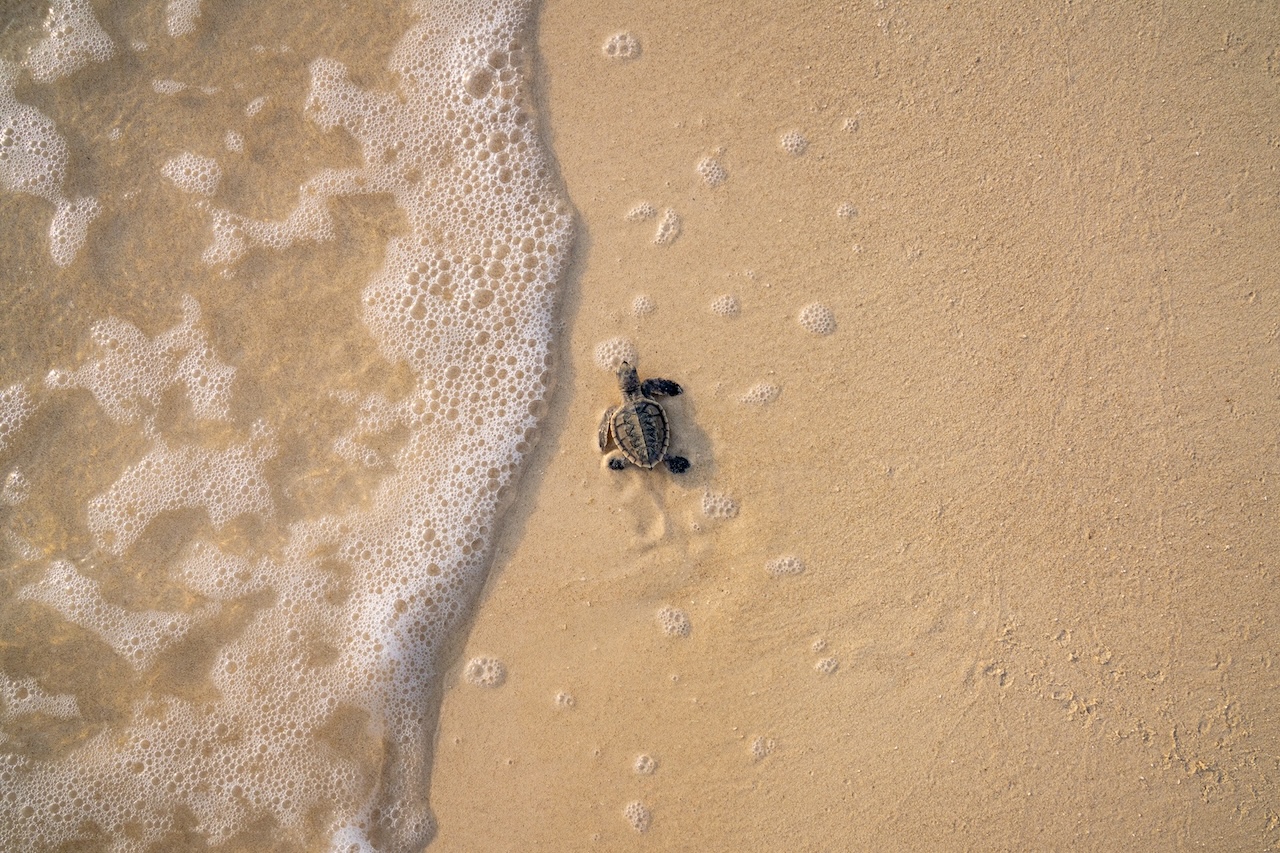
Lehmesa: Return by Moonlight
26 October–7 February 2026
Venue: National Museum of Qatar
Created by 15 Qatar-based artists, the works in this exhibition, held as part of Fire Station’s artists-in-residence (AIR) programme, reflect a shared fascination with environments, both external and internal. Whether rooted in the desert, the cosmos, the rituals of daily life or the intimacy of home, each piece is anchored by a central element. Around this anchor layers of meaning unfold, shaped by sensory cues, symbolic gestures and spatial presence. These new works emerged from a nine-month process of research, experimentation and deep inquiry in which the artists were encouraged to challenge their practices by exploring unfamiliar materials, production techniques and conceptual directions. The result is a rich body of work that stirs the senses and opens the imagination: evoking sound, texture, scent and atmosphere.
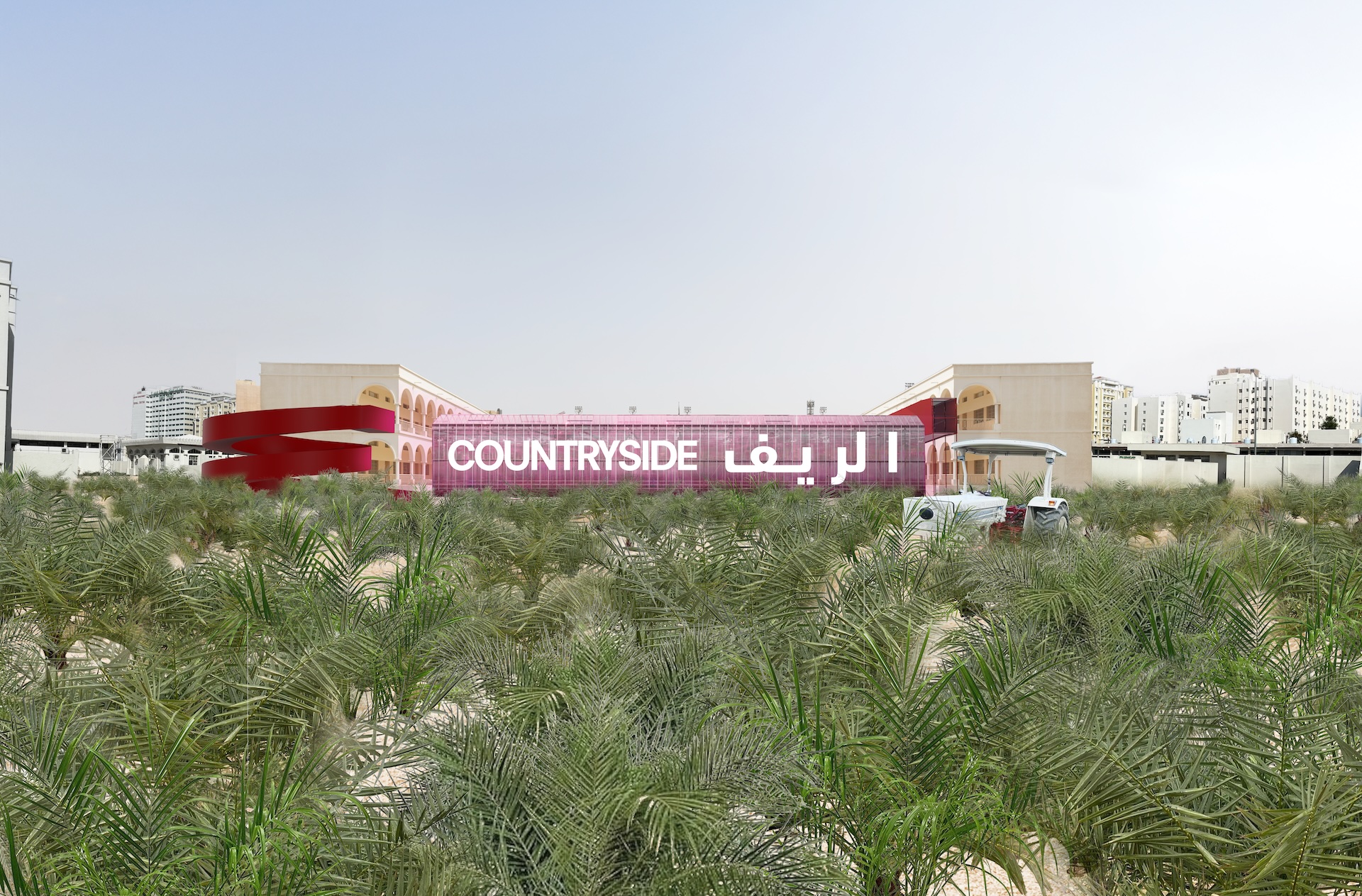
Countryside: A Place to Live, Not to Leave
28 October–29 April 2026
Venue: Qatar Preparatory School and National Museum of Qatar
In 2020 AMO, the research branch of architectural studio Office for Metropolitan Architecture (OMA), led by Samir Bantal and Rem Koolhaas, presented Countryside: The Future at the Guggenheim Museum in New York. Countryside: A Place to Live, Not to Leave builds on that show, exploring often overlooked global hinterlands of a geographical arc from Africa, through the Middle East and Central Asia, to Mongolia and China. This area is significant as it connects three continents that contain 80% of the world’s population. The exhibition argues that the countryside may now offer a more sustainable and humane alternative to urban life, which is increasingly unaffordable and ecologically harmful.
Countryside is a collaboration between AMO, Qatar Museums, Georgetown University and other organisations based in Qatar and beyond. It will establish a laboratory for imagining future rural lives and offer opportunities for engagement with diverse audiences on the exhibition’s themes, while also connecting to future vocational training set to take place at the historic Qatar Preparatory School.
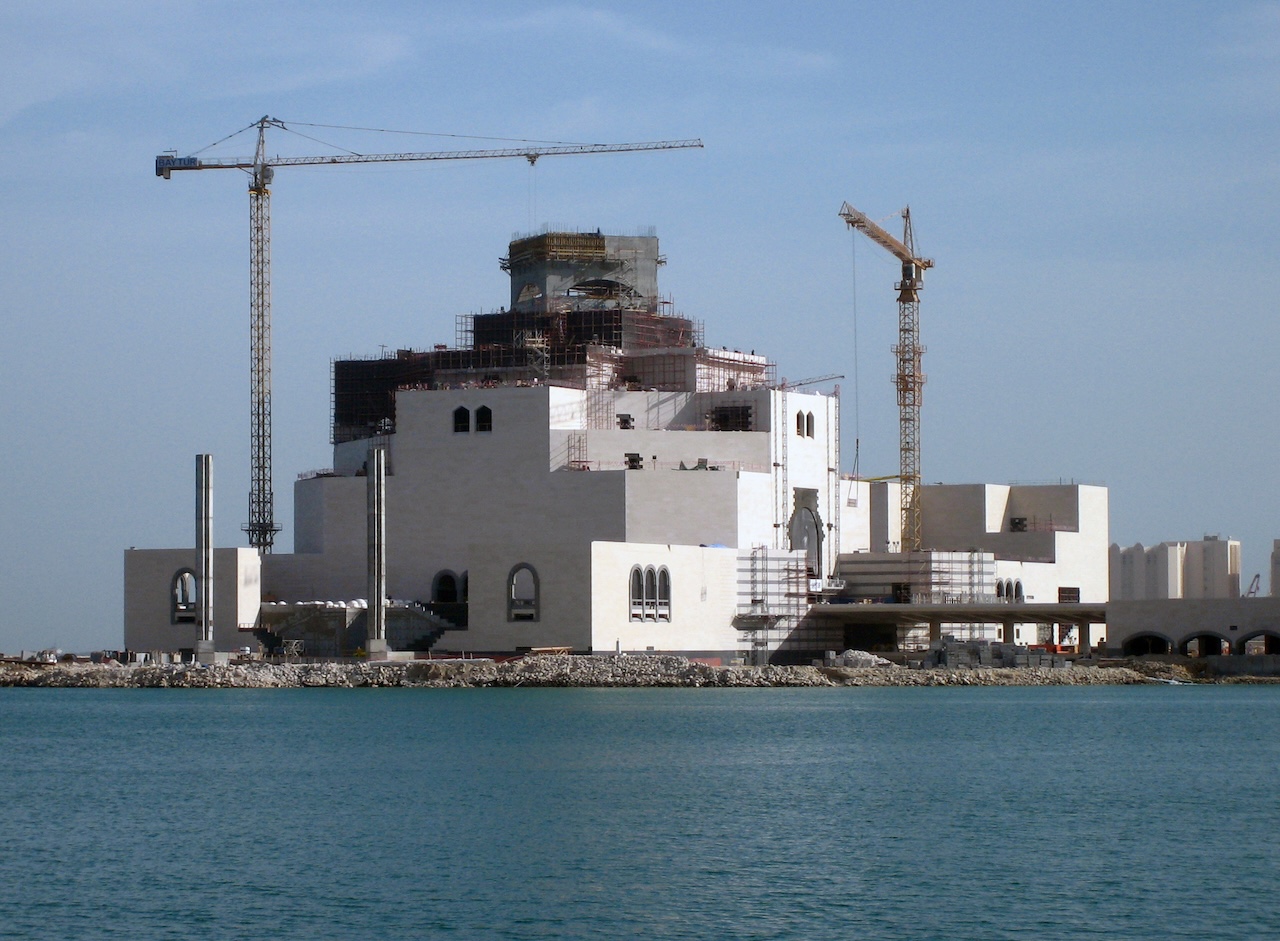
I.M. Pei and the Making of the Museum of Islamic Art: From Square to Octagon and Octagon to Circle
29 October–14 February 2026
Venue: Museum of Islamic Art
What is Islamic architecture? What is its essence? These are questions that were posed by the celebrated international architect Ieoh Ming Pei (1917-2019) when he was commissioned by the former Amir of Qatar, Sheikh Hamad bin Khalifa Al Thani, to build the Museum of Islamic Art (MIA) in Doha in 1999. This exhibition, a collaboration between the MIA and the new Art Mill Museum (due to open in 2030), seeks to trace the journey of the museum (which opened in 2008) from the planning stage to the completion of an architectural masterpiece. This is the building and the museum that announced and established Qatar’s presence on the artistic world stage.
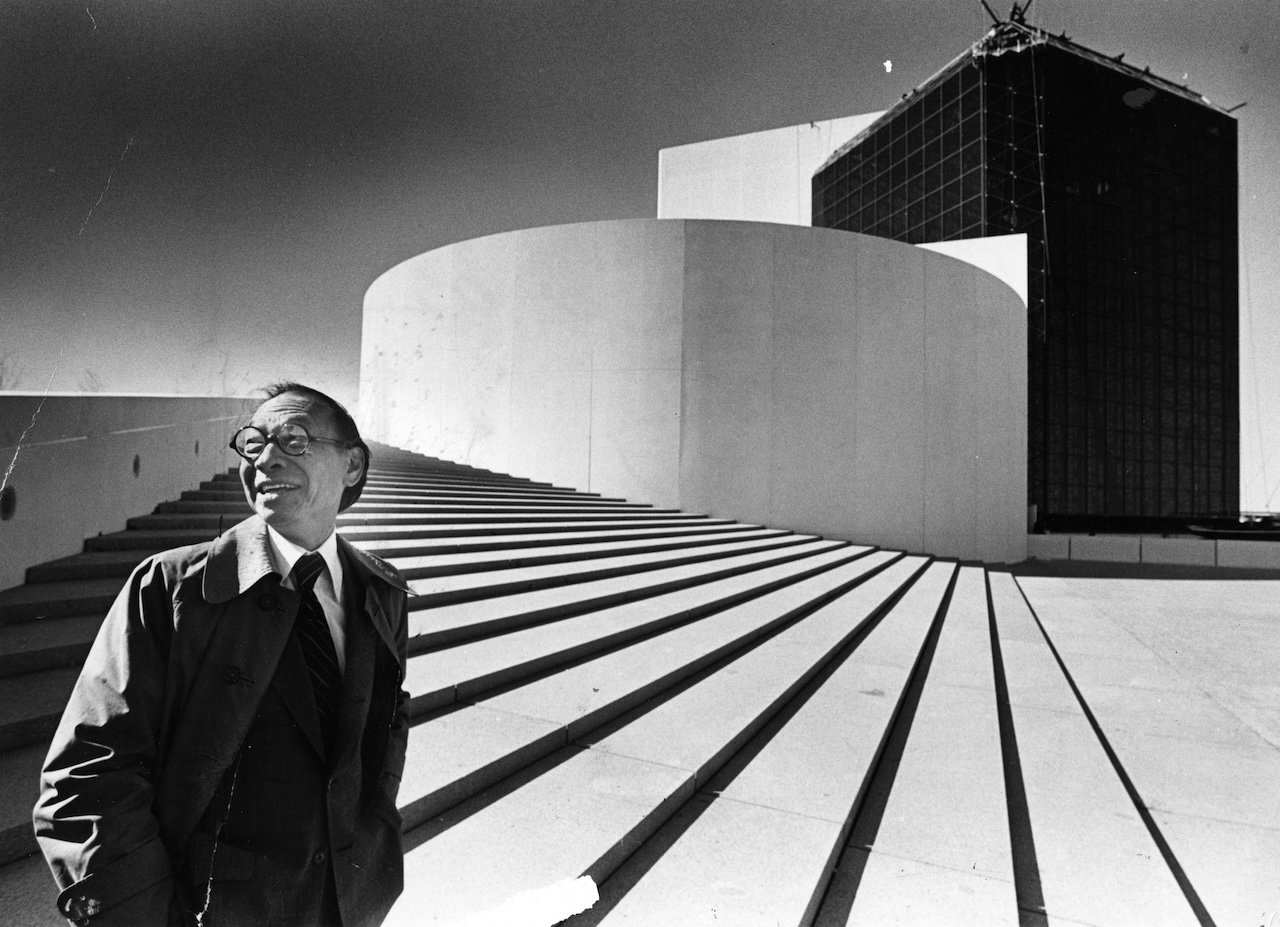
I. M. Pei: Life is Architecture
29 October–14 February 2026
Venue: Al Riwaq
The first full-scale retrospective of I. M. Pei appraises the work of one of the greatest architects of the 20th and 21st centuries. Pei’s high-profile projects were realised over seven decades with an exceptionally wide geographic reach, including the National Gallery of Art East Building in Washington, DC, the modernisation of the Louvre in Paris, the Bank of China Tower in Hong Kong and the Museum of Islamic Art in Doha. Projects such as these cemented Pei’s position not just in architectural history but in popular culture. The exhibition features a rich selection of drawings, sketches, videos, models, photographs and other archival documentation, much of it on view for the first time. To lend a contemporary lens to Pei’s work, newly commissioned photographs of his buildings by a new generation of photographers will also be on display.
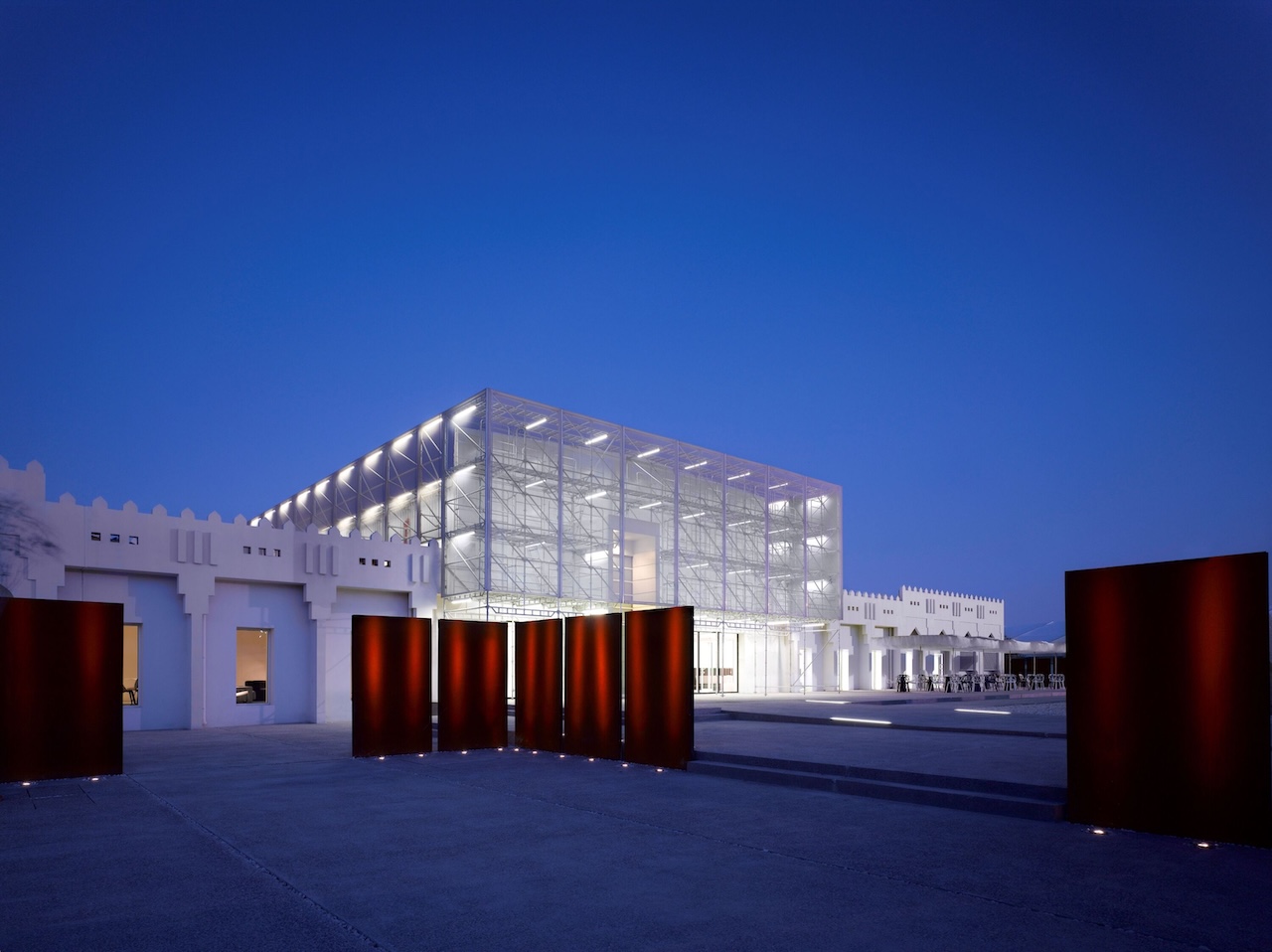
we refuse_d
30 October–9 February 2026
Venue: Mathaf: Arab Museum of Modern Art
For this exhibition Mathaf invited artists to explore the tensions between resilience and action and highlight positions that address the current context of mass migration. The title echoes the German philosopher Hannah Arendt’s essay We Refugees, written in 1943, in which she captures the disquiet, absurdity and delusional optimism engendered by exile, loss and trauma. It also refers to the Salon des Refusés, first held in Paris in 1863, not as a historical parallel but for its symbolism as an exhibition of controversial art and a space of freedom outside the mainstream discourse.
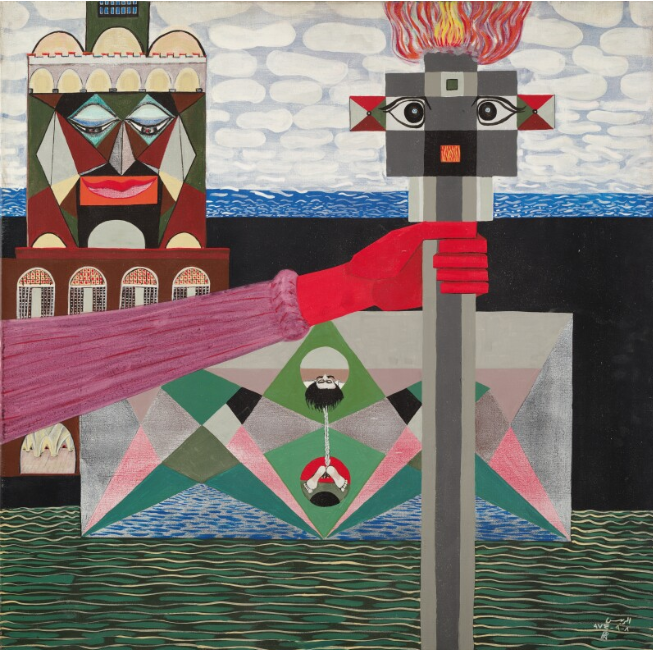
Resolutions: Celebrating 15 Years at Mathaf
30 October–8 August 2026
Venue: Mathaf: Arab Museum of Modern Art
To commemorate Mathaf’s 15th anniversary, Resolutions examines the museum’s evolution through four key areas: its origins as an artistic hub in Doha under Sheikh Hassan bin Mohammed Al Thani’s pioneering efforts; its role as a production site through commissions and exhibitions; its commitment to formal and informal art education across the Arab world; and its contribution to defining Arab identity through modernist representations, particularly in the post-independence era, when artists developed a shared visual language reflecting pan-Arab ideology and resistance to the occupation of Palestine.
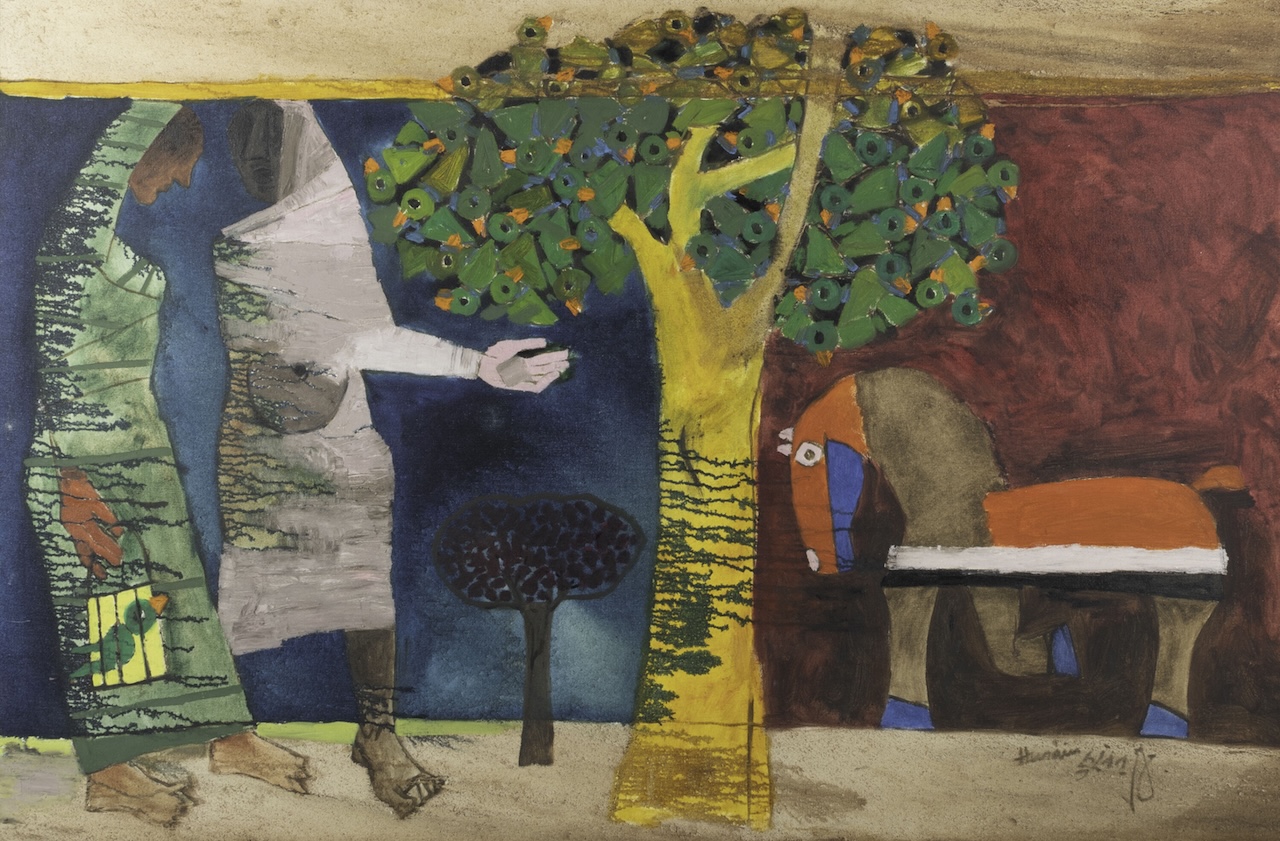
The Rooted Nomad: MF Husain
27 October–7 February 2026
Venue: QM Gallery Katara
Maqbool Fida Husain (1915-2011), one of the most famous contemporary Indian artists, continues to demand critical attention for his multi-dimensional practice, which embraced various media formats, defied artistic hierarchies and displaced the divide between high and popular art. The expressions “nomad” and “rooted” counter each other as opposing ideas, but in conjunction create an imaginary panorama in which to locate the complex figure of Husain. Much has been written about him walking barefoot across the nation, sensing the pulse of every day, painting amidst people, witnessing and fathoming the complex and layered land of India. The breadth of experiences he gathered and the evocation of multiple journeys into time and place bring together the ideas of mobility and migration. In a fragmented world marked by increasing displacement, Husain’s art and life have a pressing relevance.
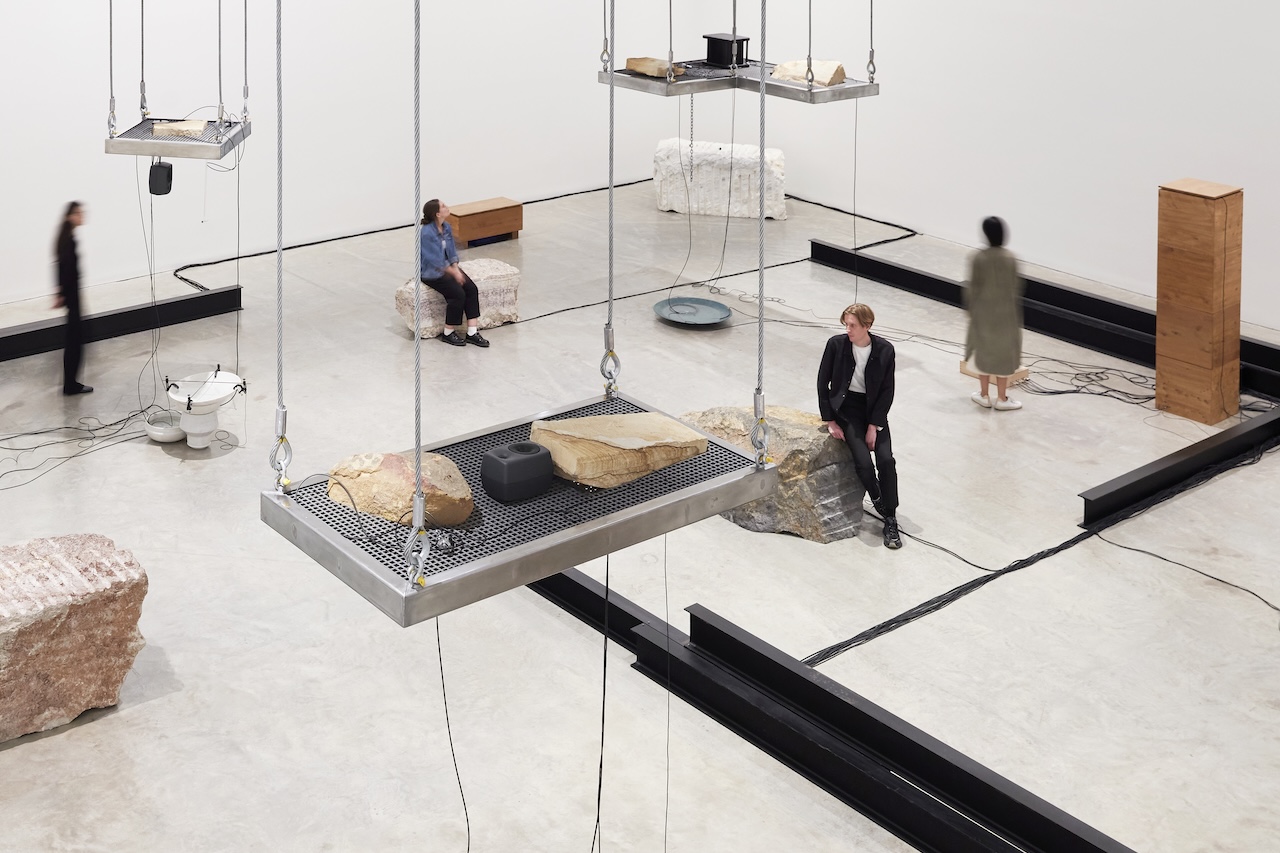
Waters’ Witness
31 October–30 May 2026
Venue: Mathaf: Modern Museum of Arab Art
Waters’ Witness is a sound research project focusing on the theme of water by Lebanese artist Tarek Atoui. The installation consists of sculptural and sonic elements, using different materials including marble, metal and ceramics. The work is based on studies and sound recordings carried out by the artist in collaboration with Eric La Casa and Chris Watson. Their aim was to document the human, ecological, historical and industrial contexts of various coastal cities, including Athens, Abu Dhabi, Beirut, Istanbul, Porto, Singapore and Sydney, places where the economic and social life is closely tied to their ports.
Public Art
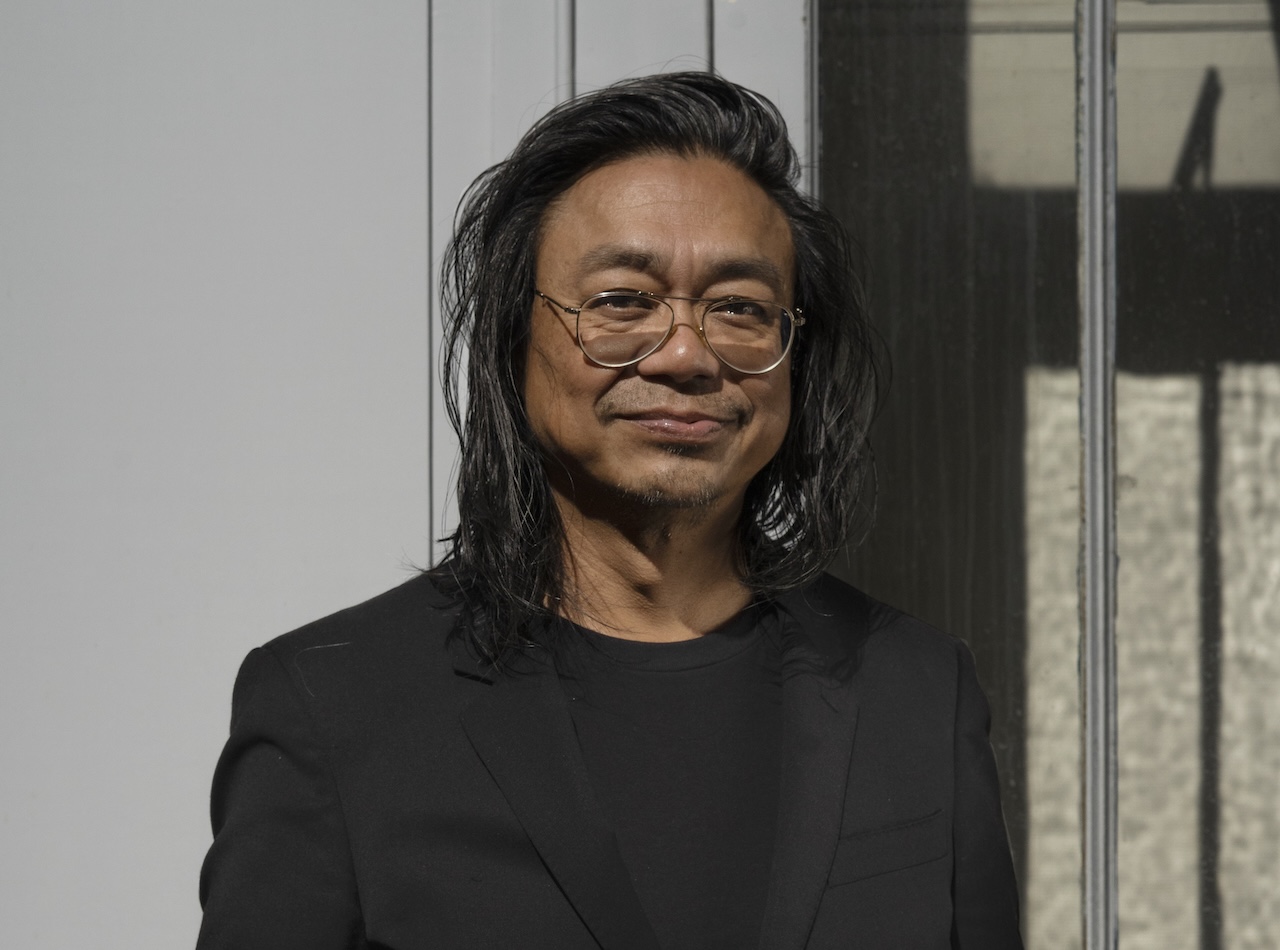
untitled 2025 (no bread no ashes)
29 October 2025–7 February 2026
Location: MIA Park
This project transforms MIA Park into an interactive installation centred on the ovens used by some of Qatar’s diverse communities. These ovens are not only functional tools for baking and cooking but also symbols of shared labour and cultural identity. Inspired by Argentinian artist Victor Grippo’s 1972 performance in Buenos Aires, where communal bread-making fostered engagement, the concept was revived by Rirkrit Tiravanija during Bienalsur 2021 in San Juan, Argentina. In Doha, the installation, which will sit in a circular shaded area between Al Riwaq gallery and the future Art Mill Museum, will invite visitors to gather, sit and bake every Friday. Local and international chefs and artists will be invited to use the ovens, enriching the dialogue around food and community.
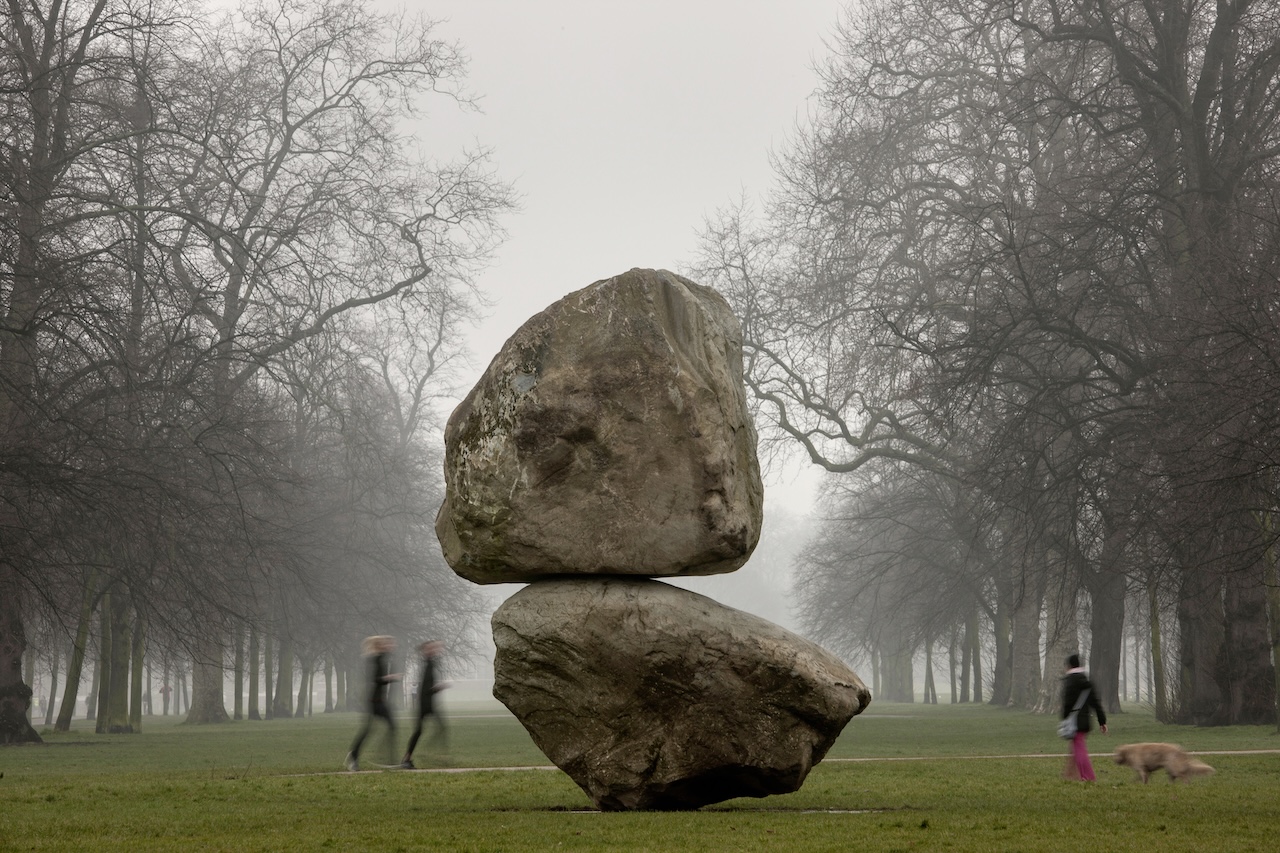
Rock on Top of Another Rock
Date of unveiling: 29 October
Location: MIA Park
Rock on Top of Another Rock by Peter Fischli & David Weiss comprises two large granite boulders balanced one on top of the other. Standing approximately 5.5 meters high, the deceptively simple work is incongruous and startling, oscillating between stability and instability, construction and destruction. It will be unveiled on 29 October 2025 at a site beside Al Riwaq gallery in MIA Park.

Autorretrao
18 December 2025
Location: Mathaf: Modern Museum of Arab Art
In celebration of the Year of Culture Argentina and Chile, this sculptural self-portrait by Argentinian artist Gabriel Chaile faces a hanging plough, looking like a comb or a mosquito, that threatens to enter the earthen sculpture, giving rise to a magical scene.
Neighbourhood Guides
MIA Park &
The National Museum
MIA (Museum of Islamic Art) Park is just north of Souq Waqif on the far side of the Corniche, Doha’s seafront highway. It is a beautiful and extensive landscaped green space beside the water, with terrific views across to West Bay. The park offers year-round attractions, including open-air film screenings, sports events, cafes, art workshops, markets, and exhibitions.
It is also at the heart of the city’s cultural scene. Within the park, on its own island, is the magnificent Museum of Islamic Art. A short distance to the southeast is the similarly architecturally breathtaking National Museum of Qatar (NMoQ). Both museums offer exceptional visitor experiences. Currently under construction, just north of the park, is what will become the Art Mill Museum of modern contemporary art when it opens in 2030.
Also within the park is Al Riwaq, a major exhibition venue with its own exciting events program, plus the Flag Plaza.
National Museum of Qatar
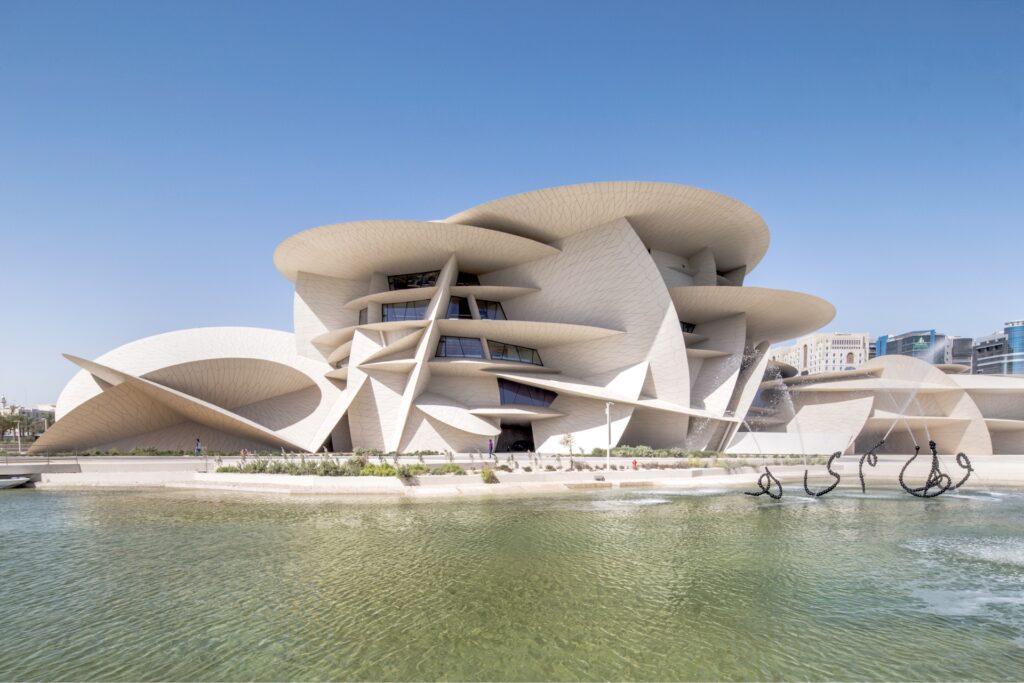
Opened in 2019 and housed within a stunning building designed by French architect Jean Nouvel, the National Museum tells the story of Qatar, both chronologically and thematically. The narrative begins more than 700 million years ago, as powerful geological forces shaped the peninsula.
The story progresses through displays that investigate the region’s developing natural history and include models of animals native to Qatar, from the smallest gerbil up to the oryx and a whale shark. There are galleries on the archaeology of Qatar and the nomadic peoples on the peninsula who moved between land and sea, herding and hunting, pearling and trading.
A highlight is the fabulous Baroda Carpet, decorated with more than 1.5 million marine pearls, as well as emeralds, sapphires, rubies, and diamonds. Later sections focus on Qatar in the modern era, and the rapid growth of the country following the oil wealth that flowed into the country in the 1970s.
As well as objects, the museum uses oral histories, films, and digital installations in the telling of Qatar’s national story. Uniquely, it embraces the restored Palace of Sheikh Abdullah bin Jassim Al Thani (1880–1957), a former Amir of Qatar. This historic compound, parts of which date back as far as 1880, includes a distinctive two-story Inner Majlis (a majlis is a meeting chamber), which at the time of its construction would have been the tallest building in Doha.
Other attractions include two gift shops, plenty of children’s activities (including three wonderful playgrounds), a restaurant and cafes, two shops, several public art installations, and temporary exhibition spaces.
Museum of Islamic Art
Recently reopened following a major reimagining of its galleries, the Museum of Islamic Art (MIA) was the last major project by the renowned Chinese-American architect I.M. Pei, who is best known for his glass pyramid at the Louvre in Paris.
MIA showcases Islamic art and culture from three continents, spanning 1,400 years. Through an unrivaled collection of artifacts, it explores the origins and spread of Islam, with galleries devoted to the Qur’an and its history, the ummah (Muslim community), learning and science, and the rapid political expansion of Islam across the globe.
It takes visitors through the Islamic world, from the Mediterranean in the west to the Indian Ocean in the east, and beyond. There are galleries on Islamic manuscripts, arms, and armor, and on Southeast Asia—the latter serves as a reminder that this is the region that is home to the world’s largest Muslim population.
The museum’s stunning interiors are inspired by historic architecture from around the Islamic world. There is a cafe and restaurant, and a well-stocked gift store. The museum also hosts temporary exhibitions.
Flag Plaza
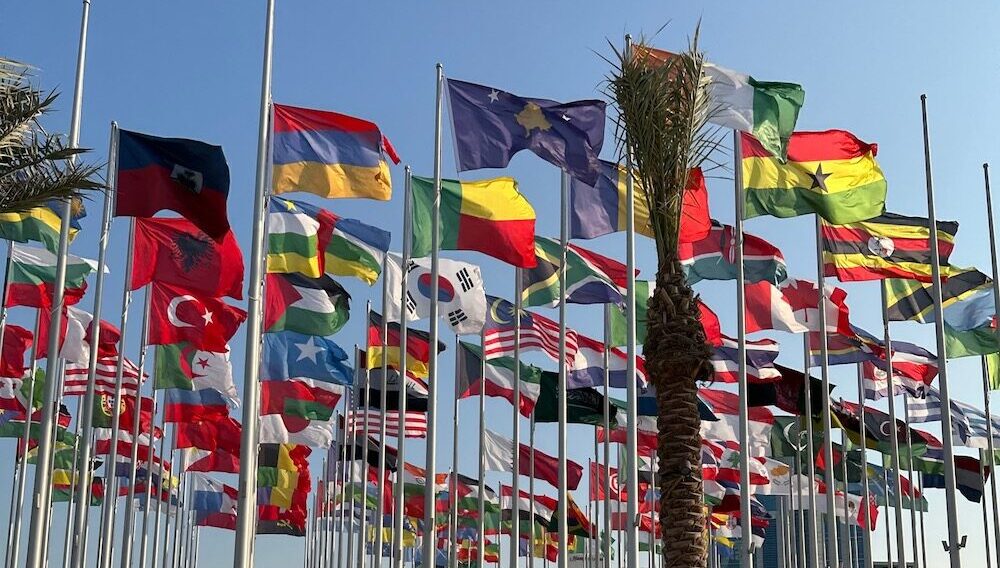
This public plaza at the edge of MIA Park flies 119 flags representing nations with diplomatic missions in Qatar, as well as the European flag, the United Nations flag, and the Gulf Cooperation Council (GCC) flag.
Mina District and Box Park
What used to be the old Doha Port was reinvented in 2022 as a marina for visiting cruise ships. At its heart is the Mina District: a carefully curated jumble of pastel-painted buildings housing cafes, restaurants, shops, and hotel accommodation, most of them set either on an undulating high street or along a lengthy waterfront boardwalk. It has the feel of a holiday resort. One of the largest buildings is an attractive fish market with an aquatic painted-glass ceiling.
Next to the Mina District is the Box Park, an area of repurposed shipping containers providing space for a variety of small businesses. Fittingly, the Box Park looks south across the water to Stadium 974, which was constructed using recycled shipping containers (974 in total) and hosted matches during the FIFA World Cup 2022™.
Public Art
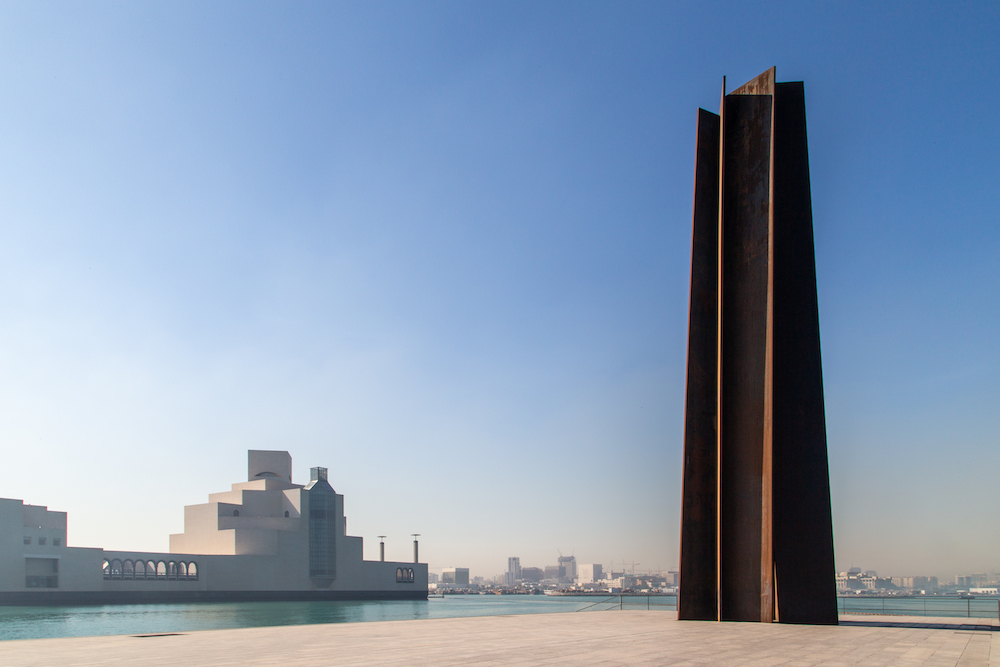
Standing at the end of the MIA Park pier is 7, a 24m-high steel artwork by American sculptor Richard Serra. Constructed from seven steel plates arranged in a heptagonal shape, the work celebrates the scientific and spiritual significance of the number seven in Islamic culture.
Other pieces of public art in the park include Liam Gillick’s Folded Extracted Personified, which is a series of “head-in-the-hole” panels, each of which features a work from the MIA collections. There is also Enchanted East by Iraqi artist Dia Al Azzawi, which is a carousel with 40 animal “seats” inspired by the MIA collections, and Saloua Raouda Choucair’s Bench.
There is also a sculptural bench at the center of the Flag Plaza: Us, Her, Him is the work of French-Lebanese artist Najla El Zein and is made from more than 270 meters of limestone. It serves as an abstract reflection on human interaction.
Family Attractions
MIA Park has a playground with three separate spaces for children of different ages (2–5, 5–12, and 12–16 year olds). There are bungee trampolines and bicycle rentals, while independent operators offer kayak tours of the nearby Dhow Harbor and stand-up paddle-board training.
The National Museum has no fewer than three children’s playgrounds. One represents the shipwreck of Erahmah Bin Jaber, a famous Arab corsair; another is a cave for children to play in, while the third, the Energy Playground, educates children about the development of Qatar’s energy industry.
Shopping
The Qatar Museum stores at the National Museum and MIA are excellent places to find unique gifts. Many of the items in the stores have been specially commissioned by local artists and designers. Also at the National Museum is WADHA, a boutique operated by Wadha Al Hajri, one of Qatar’s most celebrated fashion designers.
Places to Eat
On the fourth floor of the National Museum, Jiwan is an Alain Ducasse restaurant that marries spectacular design by architect Koichi Takada with elevated Qatari cuisine. On the ground floor, the Desert Rose cafe is operated by Nouf Al Marri, one of Qatar’s top chefs. Thalatheen, run by Ghanim Al Sulaiti, serves vegan cuisine and casual terrace eatery Café 875 was also designed by Koichi Takada Architects, with design elements by young Qatari artist Bouthayna Al Muftah.
MIA also has a Ducasse restaurant, IDAM, which serves French Mediterranean cuisine with an Arabic twist, as well as MIA Café in the atrium.
For more casual dining, a regularly changing rota of street food trucks serving burgers, coffee, and desserts line the route around the bay in MIA Park. MIA Park coffee shop has lounge chairs—or take your coffee and climb the hill, lay on the grass, and enjoy one of the best views in Doha.
A short walk south of the National Museum, east of the Corniche, is the excellent Bayt Al Sharq restaurant. It occupies the historic Al Khulaifi compound, which is a traditional quadrangle-style residence. Diners can opt for a table in the garden or for one of the small private dining rooms. The menu features Qatari classics, such as madrooba, a dish of rice and chicken with a porridge-like consistency, and locally caught safi fish fried in spiced breadcrumbs.
Msheireb and Souq Waqif
These two districts are the heart of Downtown Doha. Msheireb is the world’s first purpose-built smart and sustainable city district. Constructed between 2010–2021, it blends the best of Qatar’s architectural heritage with modern design. The central plaza, Barahat Msheireb, has a retractable roof to shade it from the sun, as well as an innovative cooling system. The district’s graceful, modern, white-stone Msheireb Mosque is the very first LEED Gold certified mosque in the world.
Msheireb is also one of the coolest of neighborhoods in terms of style, with numerous hip cafes, eateries, galleries, and boutique shops. It is home to Msheireb Museums, M7 fashion, design and technology center, and the Mandarin Oriental, Park Hyatt, and Al Wadi hotels.
The entire area is compact and walkable (many of the streets have shaded, pedestrian-friendly colonnades), but it’s also served by a hop on/hop off, free-to-ride, 2km tram loop.
Adjacent to Msheireb, Souq Waqif is a centuries-old market that was extensively and sensitively renovated in recent times. With its mud-daubed buildings, it feels like an anachronism against the backdrop of Doha’s dramatic modernist skyline but it remains a vibrant hub of activity. The souq’s labyrinthine alleys and covered passageways are full of small stores, selling everything from gold and spices to pets and falcons. The area is also home to restaurants and cafes offering a diverse variety of local and international flavors.
Visitors can check in to one of nine boutique hotels in heritage buildings. The souq is particularly busy in the evenings, when there is often entertainment in the form of musicians and dancers. Souq Waqif is one of the most culturally rich places in Doha and an important piece of Qatari history.
M7
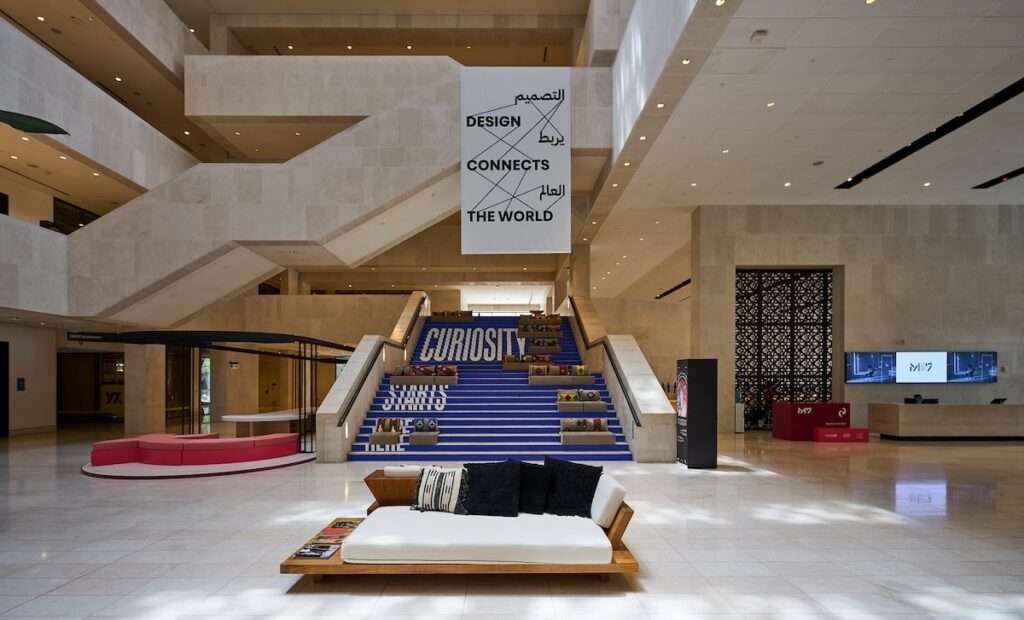
Opened in late 2021, M7 is a creative hub and incubator for design, fashion, and tech start-ups. Its upper floors hold co-working spaces, meeting rooms, a materials library, and valuable infrastructure, such as 3D-printing facilities. The ground floor is more public-facing with large exhibition spaces used for fashion and design shows (including several Design Doha shows in 2024), as well as the excellent Profiles cafe and restaurant, and concept design store Studio 7.
Msheireb Museums
These are four recently renovated classic Arab courtyard houses, each dedicated to a different aspect of history: Bin Jelmood House reflects on the story of slavery in the Indian Ocean; Company House explores the history of oil; Mohammed Bin Jassim House surveys Msheireb itself; and Radwani House looks at family life in Doha through the decades. All the exhibits are excellent, and there are regular temporary exhibitions, but it is worth visiting the museums just to experience what Qatari houses in this neighborhood were once like.
Souq Waqif
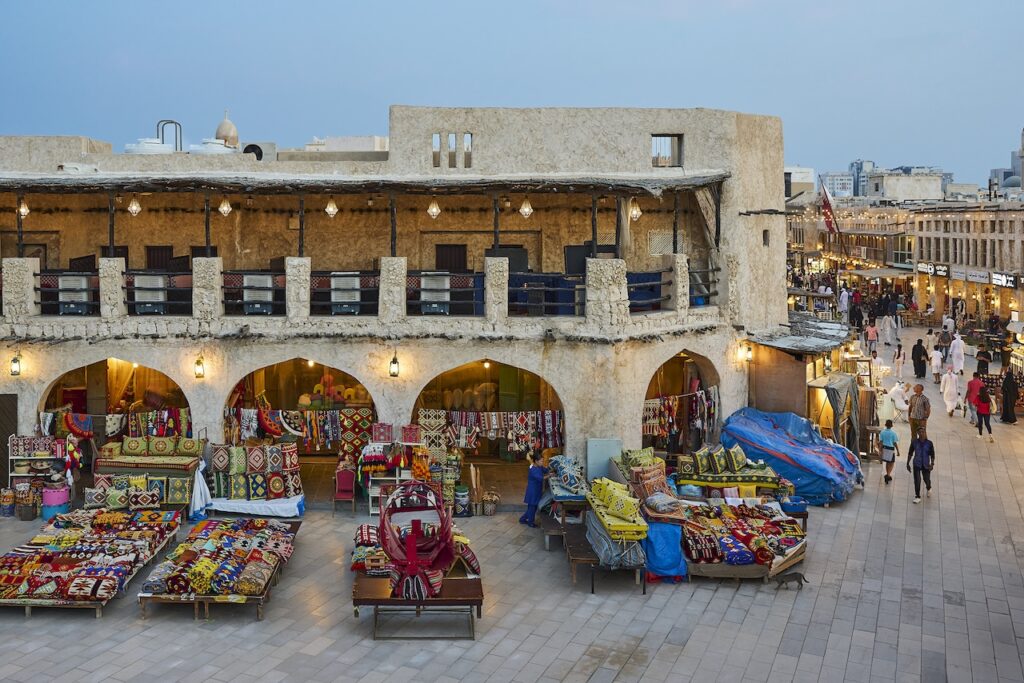
Souq Waqif wraps around three sides of a vast open plaza. On the south side, between César Baldaccini’s golden thumb and the underpass to Msheireb, are mainly restaurants and cafes, plus the Souq Waqif Arts Center and Al Koot Fort, built in 1927 to provide protection for the traders.
East of the plaza is a labyrinth of small alleys filled with shops and stalls. Different sections are dedicated to particular goods; these include the pet market, the spice market, the perfume market, an area dedicated to clothing and fabrics, and shops selling kitchenware and tools of various uses. It is common to see local women and families trailed by a hamali (porter) pushing a wheelbarrow full of purchases. For a first-time visitor to the Souq, the only way to experience it is to dive in and get lost—you’ll find your way out eventually.
The northern section of Souq Waqif is the Falcon Souq, a lofty arcaded market with more than a dozen shops selling falcons and falconry accessories, from hoods for the bird and gauntlets for its handler, to altimeters, trackers and reward tags for if the tracker fails. The hooded birds are displayed on perches for potential customers. Prices start from QAR2,500 ($687) and can go up to a few hundred thousand riyals, depending on the type and breed. There is also a Falcon Hospital here, with clinical facilities to treat 130–150 birds at a time during peak season.
Beside the Falcon Souq, on Jassim Bin Mohammed Street, is a camel compound, next door to the Emiri Stables, where the beautiful Arabian horses are kept that are ridden by the heritage police on their daily rounds of the Souq.
Public Art
Souq Waqif has the highly Instagrammable Le Pouce, a giant golden thumb by French artist César Baldaccini. Msheireb has the giant bent straw that is Turquoise City by Mark Handforth (find it around the corner from Baharat Msheireb) and Tawazun by Qatari artist Shua’a Ali, which is a balanced assemblage of sandstone and limestone shapes in the alley that leads to the underpass. Inside M7 are Indian artist Subodh Gupta’s Spooning (two giant teaspoons, one nestled inside the other) and German artist Isa Genzken’s Rose III, an eight-meter-tall flower in the building’s atrium.
Al Najada
On the south side of Wadi Msheireb Street is the heritage area of Al Najada, where several old houses have been restored and are now used for exhibitions. Liwan is a former girls’ school that is now an incubator for creative entrepreneurs. There is a vegan cafe in the courtyard.
Family Attractions
A few minutes’ walk west of Msheireb, Doha Quest is an indoor theme park. It is home to the world’s tallest indoor rollercoaster, known as the EpiQ Coaster, and also the world’s tallest indoor shot and drop tower, the Magma Blast. Novo Cinemas has multi-screen complexes at the Galleria in Msheireb and near Al Koot Fort in Souq Waqif.
Shopping
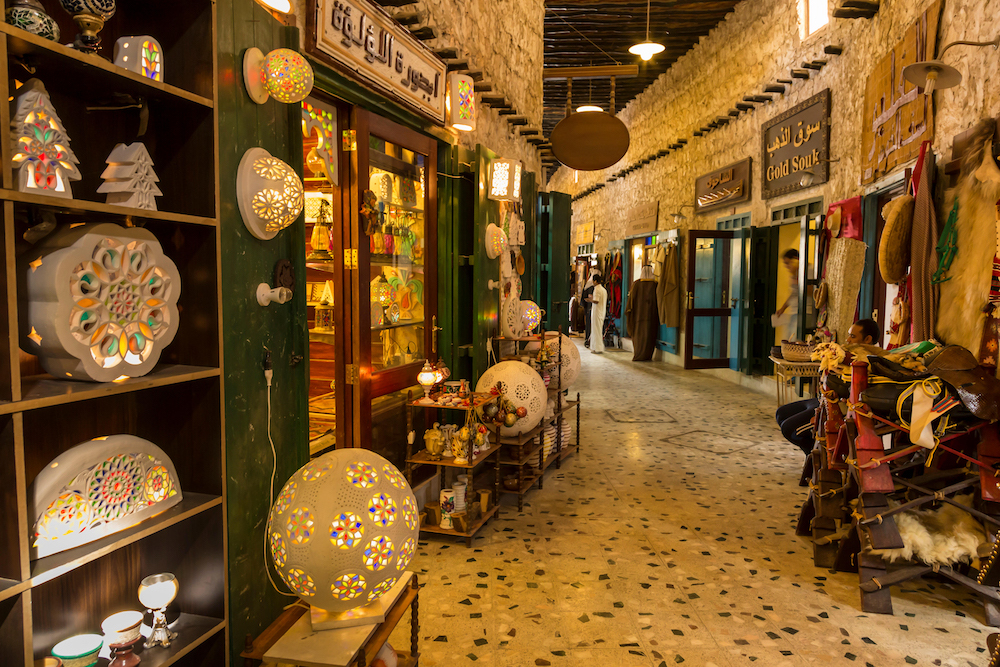
In Souq Waqif, special items to look out for include Bedouin textiles, carpets, abayas (the head-to-toe gowns worn by Qatari women), thobes (the men’s robe), embroidered garments, shisha pipes, incense, and pottery. There is a separate, large gold souq across the road in Al Najada, where you can find stunning jewelry—the bridal sets are especially spectacular. Elsewhere, The Galleria in Msheireb is home to 30 stores, plus eateries. Across the street, Doha Design District is a collection of design shops, plus the Atlas Bookstore, specializing in volumes referencing the architecture and urbanism of the Middle East and North Africa. Concept store Studio 7 at M7 sells fashion, jewelry, and home accessories from local and regional designers.
Places to Eat
For a refined but hearty take on traditional Qatari cuisine, try Saasna, which is on Baharat Msheireb. Nearby Nourlaya is a very good and popular Sri Lankan restaurant. Profiles, at M7, does globally styled breakfasts and lunches. In line with M7’s mission to champion great design, Mariam Al-Abdulla, a talented local architect has designed the central island, the hub of the space.
Souq Waqif offers more traditional dining options. For a truly Qatari experience visit Shay Al Shoomos, the first business in Souq Waqif to be owned and operated by a Qatari woman. It is popular for breakfast; find it below Al Bidda Boutique Hotel.
Hidden deep in the souq are two kebab restaurants that are little more than tables in passageways; the meat comes on the skewer, served with large discs of flatbread and optional salads and dips. Kabab Al Tayeb is near the golden thumb—head down an alley next to Kulud Pharmacy and take the alley beside it—while Shujaa is down the alley opposite Al Bidda Boutique Hotel.
For an equally memorable dining experience, Parisa is a Persian restaurant serving kebabs and stews, with an interior that feels like a fairy tale.
Far more humble, Ali Al Naama Cafe is a hole-in-the-wall place run by a Yemeni who has lived in Qatar for decades. It serves good filled chapatis; find it on the corner of an alley beside the mosque.
For dessert, Al Aker is a pastry shop by the golden thumb that does exquisite kunafa (cream cheese with vermicelli pastry).
Al Bidda Park
Stretching between Downtown and West Bay, just inland of the Corniche, Al Bidda Park provides a great swathe of greenery in the heart of Doha. The park is made up of three areas, each with its own character: secluded lawns with naturalistic landscaping in Al Bidda; wide, open spaces in Wadi Al Sail (which includes a protected reserve); and formal gardens in Al Rumailah. Spread over its three parts, the park offers nature, heritage, and public art, as well as ample sports, play and recreation opportunities. Around the edge of the park are some of the city’s landmark institutions, including the Amiri Diwan, the Qatari government’s seat of power, the post office, Qatar National Theater, Fire Station arts center, and former Ministry of Interior, which is now The Ned, a hotel and private members’ club. The park is also the location for the forthcoming Dadu, Children’s Museum.
Fire Station
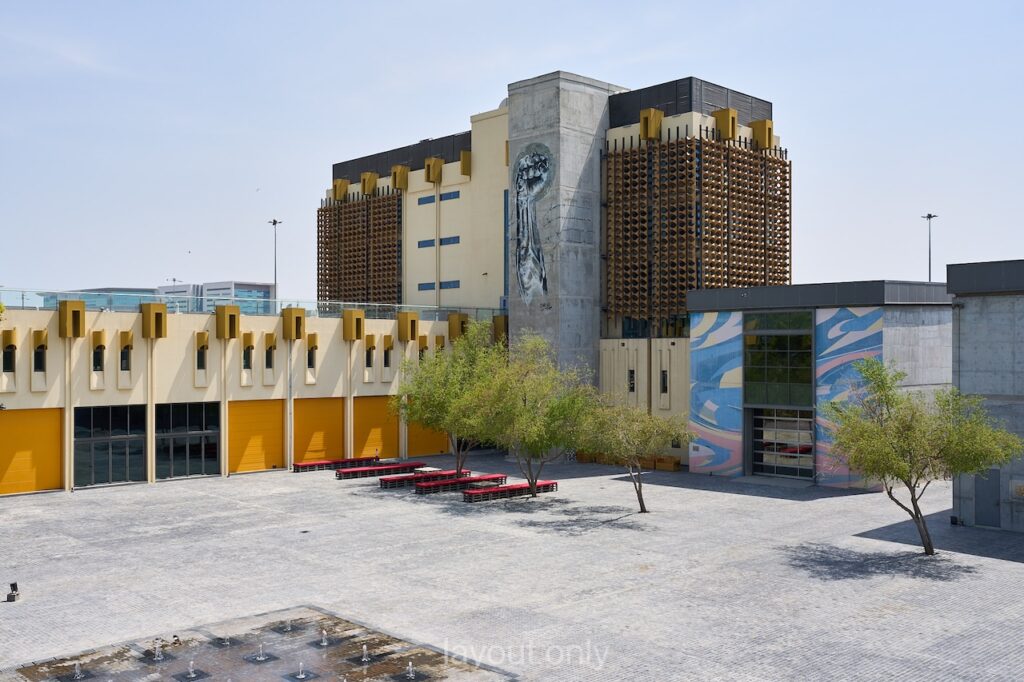
Until 2012, this was a working fire station. Then it was handed over to Qatar Museums, which kept the building’s honeycomb facade intact but converted the five floors of the interior into studio spaces and began an artists-in-residency program. Fire Station has since become the leading contemporary art space in town. For visitors, there is the Fire Station Cinema, Café #999 Italian bistro, a supply shop, and gallery spaces that have hosted high-profile shows by the likes of Ai Weiwei, KAWS, and Virgil Abloh.
Dadu, Children’s Museum and Gardens
Opened in late 2021, M7 is a creative hub and incubator for design, fashion, and tech start-ups. Its upper floors hold co-working spaces, meeting rooms, a materials library, and valuable infrastructure, such as It won’t be ready until 2026, but planning is already advanced on the forthcoming Dadu, Children’s Museum of Qatar, on a site in the Wadi Al Sail section of the park. In the meantime, the museum gardens are already open to the public: they include an Edible Garden, where children and families are invited to be gardeners and tend to plants, and a Garden Atelier, which is an indoor/outdoor kitchen space with workshops for adults, families and children. Visitors can select ingredients locally grown from the garden and use them to create their dishes.
Public Art
Gekröse (2011) is a giant pink sculpture by Austrian artist Franz West (b.1947). The title translates to “intestines”, which is exactly what the enormous welded aluminum sculpture resembles. The structure manages to appear intimidating, yet at the same time playful and whimsical, both attracting and repulsing the viewer. Close by, in Al Masrah Park, is the Doha Modern Playground (2022) by UK artist Shezad Dawood. It is a children’s playground where the play structures are inspired by four key modernist buildings in Doha, including the neighboring National Theater and Qatar Post Office. Both these buildings have their own public art installations: in front of the post office is local artist Mohammad Al Ateeq’s Acacia-Tree Seed (2022), while the National Theater has Clay Court (2022) by UK artist Faye Toogood, which is 17 giant sculptures presented as seats, benches and arches, as well as Two Orchids (2015), a pair of monumental white blossoms by German artist Isa Genzken.
On the Corniche opposite
Al Rumailah Park is Toub Toub Ya Bahar (2022), a stainless steel sculpture by Qatari artist Salman Al-Malek inspired by an old song sung by women waiting for the return of their sailor husbands and sons. The facade of the Fire Station displays a work in neon lettering by local artist Ghada Al Khater, entitled A Blessing in Disguise (2018).
Amiri Diwan
Just east of the park is the seat of the government of Qatar, the Amiri Diwan. It is a 1980s building, sited next to the old palace and fort. In 2022, the Qasr Al Hukum (Justice Palace), which is part of the Diwan, was inaugurated as a semi-public space for visitors to learn about the history of Qatar’s rulers and the nation’s cultural diplomacy. The Qasr has been beautifully restored and is a celebration of Islamic culture and design. It is possible to visit by booking a tour, which also takes in other significant historical monuments, including Al Shioukh Mosque, Al Bidda fort and the Clock Tower. Visits must be booked in advance and numbers are limited.
Family Attractions
The entire park is one giant play area for children. There are two mazes to explore in Al Rumailah, close to the National Flag. Elsewhere, an extensive network of cycle lanes can be used for cycling, rollerblading, and skateboarding.
There are eight well-equipped playgrounds across Al Bidda Park (albiddapark.com), with everything from sandpits and climbing frames to swings and zip lines. A variety of sports can be played, such as tennis, volleyball, and basketball, with an excellent range of facilities, including an artificial grass football pitch. Purpose-built barbecue stations and gazebos are located throughout the three park zones. These are all available for use during park opening hours on a reservation basis using the Al Bidda Park website or mobile app.
Places to Eat
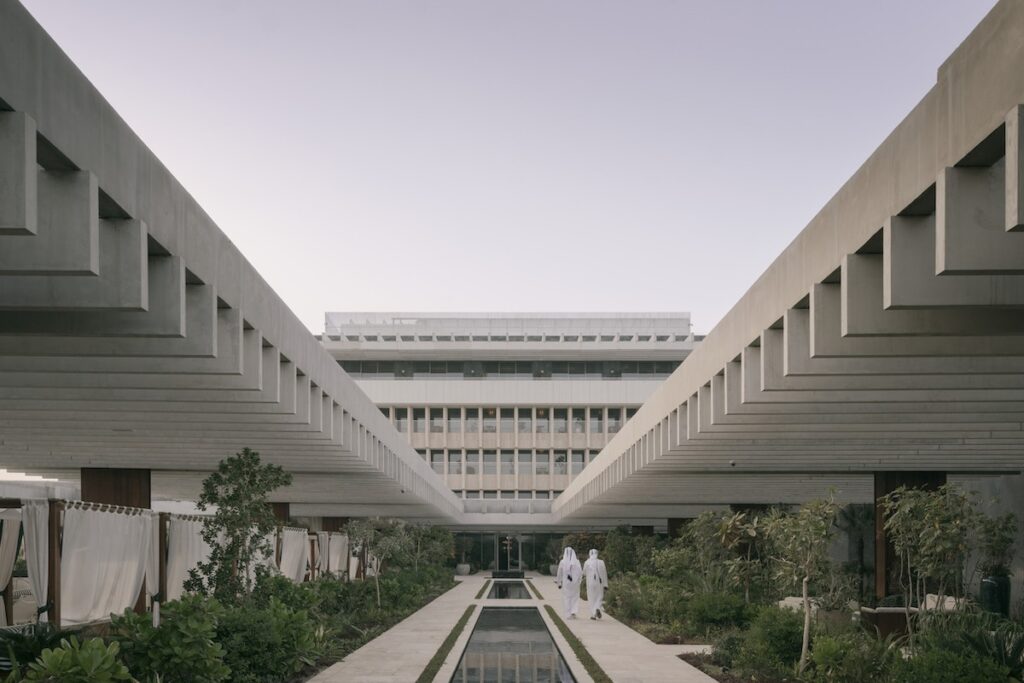
Merging the world of food and art, Café #999 at the Fire Station has a kitchen overseen by Alain Ducasse and a dining space designed by artists and creatives. The menu is Italian-inspired: hammour fish alla romana, with a deep tomatoey/olivey sauce; a lamb chop with grilled zucchini; and the pizzas are excellent.
The Ned has no less than seven restaurants, including Malibu Kitchen, an on-trend, healthy outdoor eatery beside the hotel’s California Dreaming-style pool. There is also a branch of famed Italian Cecconi’s, an American diner, and a Levantine garden restaurant.
West Bay
West Bay is Doha’s high-rise business and diplomatic district. It is home to one of the city’s first shopping malls and its first international hotel, the ziggurat-like Sheraton Grand Doha. When the Sheraton was built in 1982, it was the first structure completed in West Bay. As well as being a hotel, the building was also an important venue for conferences and international seminars, a role that has since been taken on by the huge Doha Exhibition and Convention Center (DECC), which is another West Bay landmark.
However, the most iconic element of the neighborhood is the cluster of skyscrapers along the Corniche. Chief among these is the Doha Tower, also known as the Burj Qatar, by French architect Jean Nouvel (also responsible for the National Museum of Qatar). It is designed to look like a super-sized version of the traditional Qatari pigeon towers. The outer skin of the building is a brise-soleil that shields the interior from the sun while invoking the traditional wooden mashrabiya screens of the region. There is also the so-called Tornado Tower, which tapers inward in the middle before flaring out again at the top.
West Bay is a prime dining and nightlife area because of its many hotels. Another draw is the Corniche itself, great for leisurely strolls beside the Arabian Gulf.
Museum of Illusions
This is not so much a museum as a visual playground featuring holograms and optical art installations. Along with the games, there are lessons in science, maths, and the workings of the human brain. Situated in the Gate Mall, it is an intriguing and fun experience for all ages, ideal for family and group visits, with multilingual guides on hand to help show visitors around.
Public Art
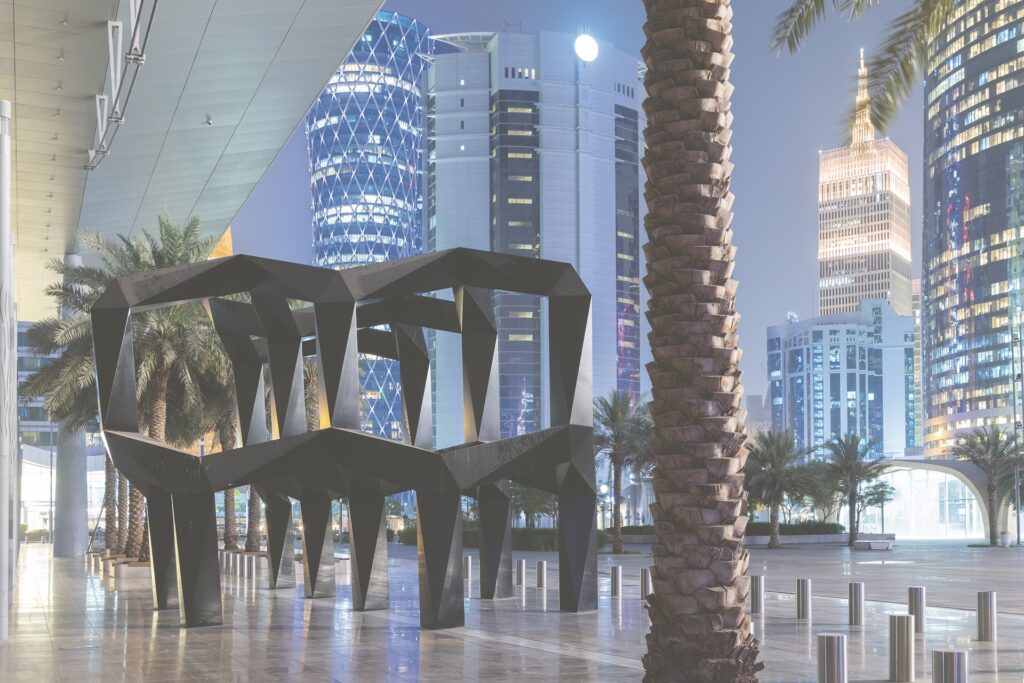
In front of the DECC is the giant geometric sculpture Smoke (1967) by American artist Tony Smith, which is inspired by the morphology of organic shapes, such as crystals. The facade of the convention center at the Sheraton bears the reassuring message “Everything is Going to Be Alright” in large neon lettering; a work called 1361 (2019) by UK artist Martin Creed. Inside the hotel atrium is Hahn (2013), a giant fiberglass powder-blue cockerel by German artist Katharina Fritsch that previously spent 18 months standing on a plinth in London’s Trafalgar Square. In Al Dafna Park, which is close by the Sheraton, is Here We Hear (2022) by South Korean artist Suki Seokyeong Kang, which is a series of steel sculptures intended to create a forum where people can gather and swap stories. North Beach has Zephyr (2022) by Dakar-born Kuwaiti artist Monira Al Qadiri, which is a large-scale recreation of a microscopic organism seen in fossilized marine algae found in the Arabian Peninsula, illuminated to mimic their bioluminescence.
Family Attractions
The Museum of Illusions (see Highlights) is a big hit with children of all ages. West Bay has an excellent public beach (at North Beach), as well as many beaches accessible for a fee, where plenty of watersports are available. Along the Corniche, dhow boat operators offer rides around the harbor. Al Dafna Park offers a welcome slice of greenery, plus a children’s play area, and superb views of the striking West Bay skyline.
Shopping
The long-established City Center Mall has more than 200 brands and services over five floors. It also has a putting green, children’s play area, and 14-screen cinema complex. The Gate Mall offers more boutique shopping, with some interesting specialist outlets, including Store 974, Qatar’s first PC gaming outlet, the home-grown Botany Lab spa for men and women, and an upmarket butcher selling marbled Wagyu beef imported from Australia and Japan.
Places to Eat
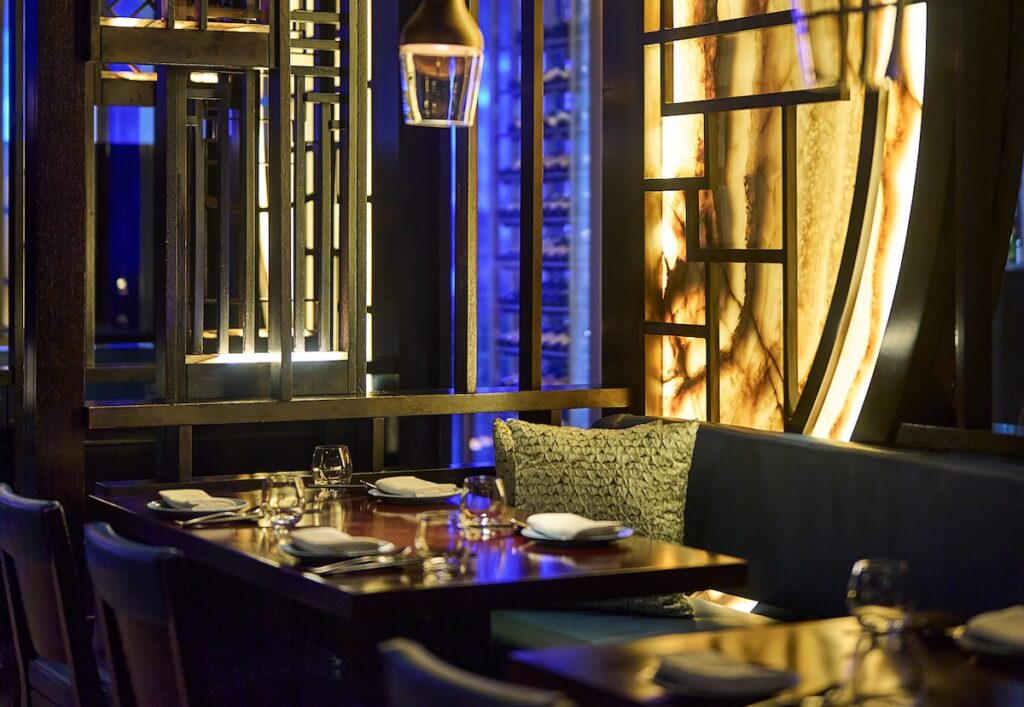
Some of Qatar’s finest dining is found in West Bay, including the world’s largest Nobu, housed in a freestanding shell-like building on its own pier at the Four Seasons Hotel Doha. For world-class Chinese, there is Hakkasan Doha at the St. Regis Doha, which is just across the bay to the north.
The outstanding Jamavar draws from the best of culinary traditions from across India; it’s at the Sheraton Grand. Gaia offers a modern take on the Greek taverna—by way of Nigerian-born, London-raised, French-trained, Dubai-based celebrity chef Izu Ani. The understated dining room is among the prettiest in the city; find it at Building 138, Street 801.
For breakfast, brunch or just a coffee there is Flat White. When it launched in 2012, it was Qatar’s first homegrown, artisan coffee shop. It now has six branches, including one in the Gate Mall. This is also where you will find Evergreen Organics, a homegrown 100% vegan cafe serving breakfast, lunch, and dinner.
Katara
Katara (an ancient name for Qatar) is a purpose-built cultural village that opened in 2010. It’s set between landscaped hills and overlooks a beautiful arc of sandy beach, as well as offering culture and leisure activities, and is one of Doha’s go-to destinations for dining and high-end shopping.
The village’s design takes its cue from traditional Qatari architecture, with narrow, shaded alleys, courtyards, and windcatchers to channel cooling breezes. The centerpiece is the large, circular Amphitheater, while around it are numerous cultural institutions, including the Drama Theater and the Opera House, which is home to the Qatar Philharmonic Orchestra. There are several major galleries showcasing local
and international artists, notably the Qatar Museums Gallery, and the independently run Katara Art Center (KAC), which is dedicated to contemporary art.
Other noteworthy sights include the Golden Mosque, so named because it is covered with small golden chips; the Katara Mosque, inspired by the tiled majesty of the Dolmabahçe Palace in Istanbul, and which was designed by renowned female Turkish architect Zeynep Fadıllıoğlu; and two sets of giant pigeon towers that actually do shelter hundreds of birds.
Katara Amphitheater
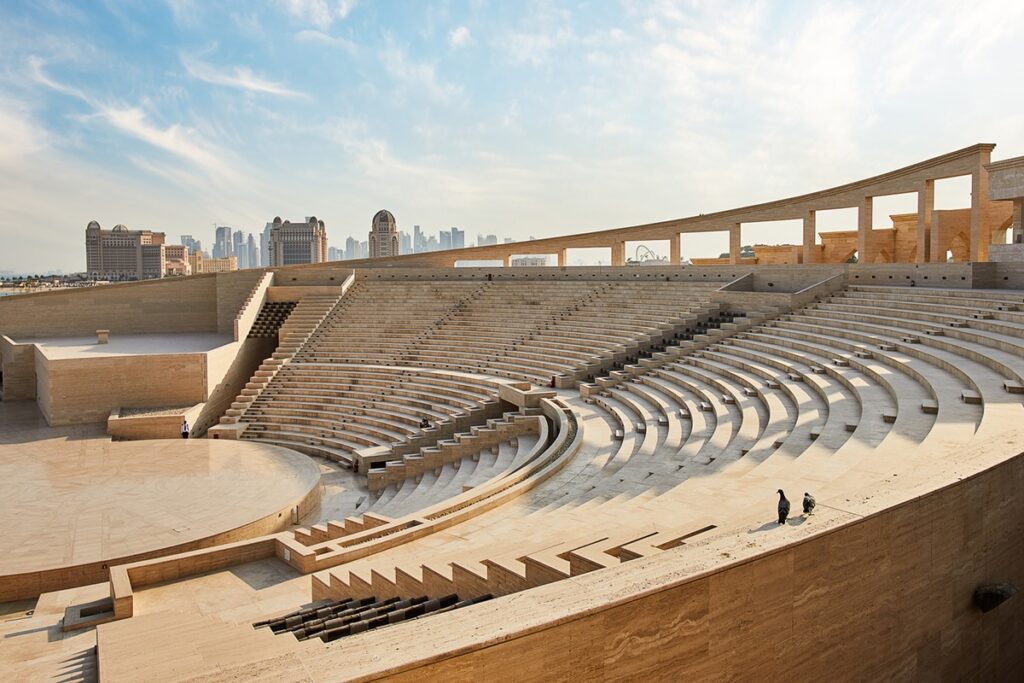
The heart of the Cultural Village is the Katara Amphitheater, a modern, open-air auditorium that was inspired by the ancient theaters of Greece. Completed in 2008 and officially opened in December 2011, it has around 30 rows of seats, accommodating 5,000 people, all facing a large circular stage with a sea-view backdrop. When there are no events taking place, visitors are welcome to explore the Amphitheater free of charge.
Katara Traditional Dhow Museum
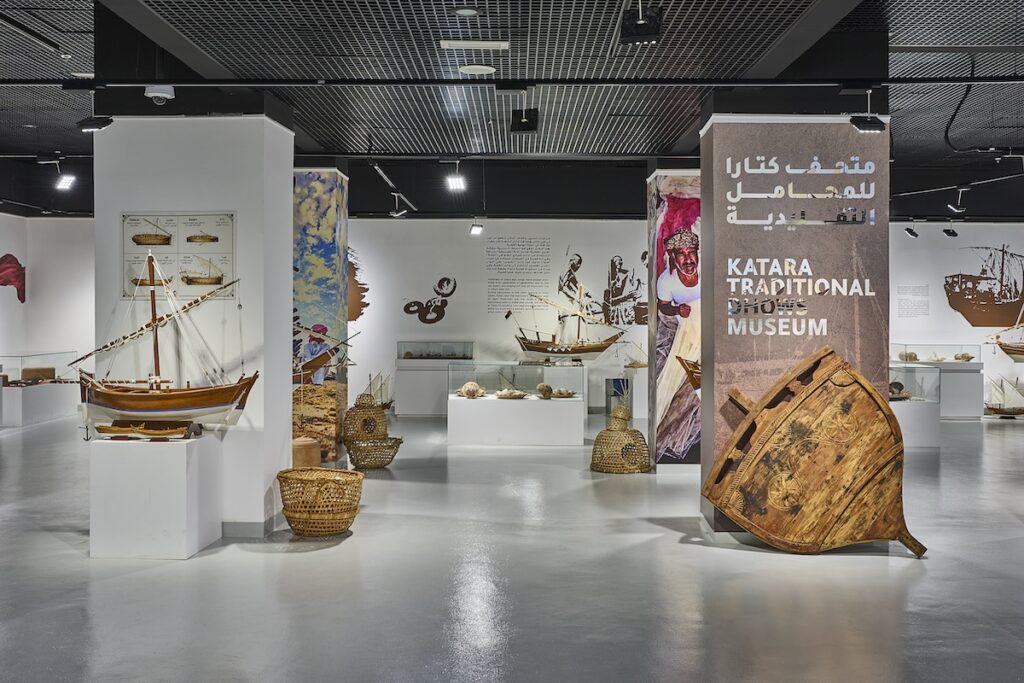
This small but densely packed museum is devoted to the dhows and other vessels traditionally sailed by Qatari seafarers, and to the seafaring way of life. Several displays, including arrays of woodworking tools, relate to the crafting of wooden boats and there is a sobering display of hajar, the large cylindrical stones that were used by pearl divers to help sink them down to the sea bed. Another highlight is the collection of intricate models of dhows of various types, such as the hoori (used for fishing), the bateel (used by coastguards) and the markabi (used by pirates).
Arab Postal Stamp Museum
Founded in 2010, the Stamp Museum holds a multi-themed stamp collection that covers 22 Arab countries, all in a single hall. As well as paying homage to the intricate designs and artistry of stamps, the collection offers an insight into Arabian culture, history, and civilization.
Al Thuraya Planetarium
The small planetarium offers a full-dome digital 2D and 3D experience, during which visitors learn about the cosmos and the contributions of historic Arab astrologers. Shows take place in English and Arabic, and there are free shows on certain nights of the week. There is also a museum within the Planetarium with models of the solar system in various sizes, plus models of space shuttles and astronauts’ suits.
Public Art
Just outside the Amphitheater, Gandhi’s Three Monkeys (2012), by Indian artist Subodh Gupta, consists of three heads: one in a gas mask, one in a soldier’s helmet and the other in a terrorist hood. Together, they recall Gandhi’s famous metaphor of the three wise monkeys that “see no evil, hear no evil, speak no evil”.
Between the Amphitheater and the beach is The Force of Nature II by Italian artist Lorenzo Quinn, depicting Mother Nature with a sling, in which she is whirling around the planet Earth. Throughout the Cultural Village are pieces of wall art, including giant painted murals of an oryx and a whale shark.
Family Attractions
Katara has a beautiful 1.5km-long sandy beach, which can be enjoyed for a small entry fee (but note: no tight Speedos or bikinis are allowed). There is a children’s playground and beach equipment rentals, plus speed boat rides, parasailing, and water skiing.
Either side of the Cultural Village are the North Hills and South Hills parks, which are lushly landscaped, with water features and walking tracks. The hills offer excellent views of the bay, especially at sunset.
There is a dedicated Children’s Mall, with an exterior designed to look like a gift box, which marries children’s shops (clothes, toys, candy stores, school supplies) with fun and educational games. Katara Art Studios (building No.19) organizes regular art workshops for children.
Shopping
21 High St is a high-end, climate-controlled shopping avenue that runs between the Cultural Village and the Lusail Expressway. It is anchored by a branch of the upmarket French department store Galeries Lafayette, where, housed within bespoke Haussmann-inspired architecture, complete with glass ceilings, are hundreds of top brands over three floors. The high street also includes branches of Cartier, Elie Saab, Graff, Joseph, Richard Mille, and Van Cleef & Arpels. There are restaurants and cafes, and also the sumptuous SNAN Food Hall, which offers gourmet foods from around the globe in a beautiful glass and steel conservatory-like building.
Places to Eat
Karak is the Gulf’s take on masala chai: a super-sweet tea made with evaporated milk and cardamon that is practically the national drink of Qatar. Pair with a chapati for a perfect Qatari snack. Chapati & Karak does possibly the best karak in Doha and is equally popular with Qataris, Western expats, and Asian workers.
Beachfront Mamig is the place to go for Armenian food—a tribute to the millions of Armenian refugees that live throughout the Levant. Standout dishes include the manti (Armenian dumplings) with spinach, and the minced lamb kebabs with cherry sauce.
At L’wzaar, diners pick out seafood from the 4m-long display and then have it freshly prepared by the chefs. Boho Social is a chic spot in a circular structure on top of Katara Beach club. It serves breakfast, brunch, lunch, and dinner with a menu that includes Asian, South American, and Middle Eastern flavors—from eggs Benedict to cinnamon-braised lamb shank—plus vegan options.
On top of the hill to the north of the Cultural Village, Bayt El Talleh serves authentic Levantine cuisine. Go for breakfast, lunch or dinner—the menus may be set but there’s a huge amount of variety. Dine outdoors for a stunning view over the bay and towers of The Pearl.
Diners don’t even have to leave their cars at Tasty Street, a drive-through area with parking slots in front of around 40 wooden cabins, each offering a different dining experience, from burgers and seafood to donuts and Persian ice-cream.
The Pearl
The Pearl is an archipelago of 13 linked artificial islands totaling nearly four square kilometers of reclaimed land. It sits in the sea just off the shore of Katara, and between the prestigious West Bay district and new city of Lusail. It has been created by the United Development Company (UDC), a leading Qatari public shareholding company.
The Pearl is divided into 10 architecturally distinct precincts, all inspired by Mediterranean living. All are largely residential, with a mix of luxury apartment blocks and villas. As the first land in Qatar to be available for freehold ownership by foreign nationals, The Pearl is home to a number of expats.
While there are no specific tourist sites as such, The Pearl has three five-star hotels and more than two square kilometers of international retail, restaurants, cafes, and entertainment facilities, including cinemas, children’s fun parks, and beaches.
The Pearl has three main areas to explore: the Qanat Quartier is a Venetian-inspired neighborhood, full of pastel-colored buildings, pedestrian-friendly plazas, canals, and bridges—including one modeled on the Ponte Rialto. Porto Arabia aims for a Riviera look, with Mediterranean-style yacht marinas and quay-side dining. Medina Centrale has plazas and gardens, and plenty of luxurious shopping at premium designer boutiques. There are also bountiful restaurants and cafes.
To get to the Pearl by public transport, get off at Legtaifiya Metro station and board the free M110 Metrolink shuttle, which stops in the Qanat Quartier, Porto Arabia, Medina Centrale, and Perlita Gardens.
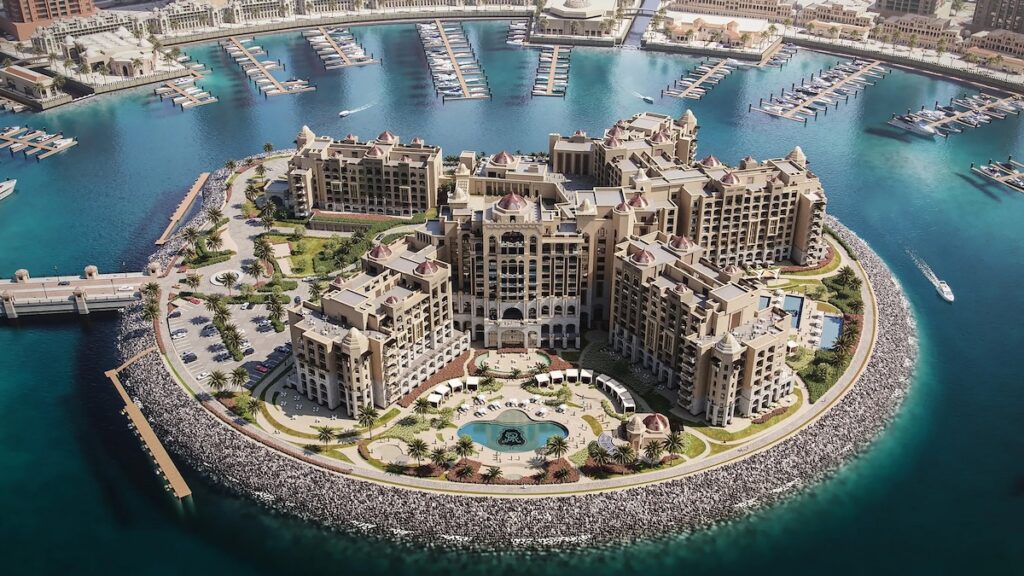
Family Attractions
Megapolis is an entertainment center in Medina Centrale that offers arcade games, car racing simulators, bowling, billiards, darts, an escape room, and karaoke. In Porto Arabia, Yippyland Entertainment City welcomes children aged two to 14, with more than 45 video and table games and a variety of rides.
Of the various beaches on The Pearl, Lido Venezia Beach, in the Qanat Quartier, is particularly family friendly. It is a private beach but you can buy a day pass at the Taliamare beach club and enjoy sun shades, towels, light food, cool drinks, and soft, white sand.
Shopping
The Medina Centrale district is home to numerous high-end international brands, from Ferrari, Porsche, and Bentley to fashion houses including Elie Saab, Hermès, Missoni, and Versace. Also worth a look is Harlienz, a contemporary fashion brand founded by Qatari designer Haya Al Adsani. Harlienz was the first Qatari label to feature at New York Fashion Week (in 2019). Adsani creates easy-to-wear, versatile abayas, which have been worn by renowned designer Diane von Furstenberg, among others.
Places to Eat
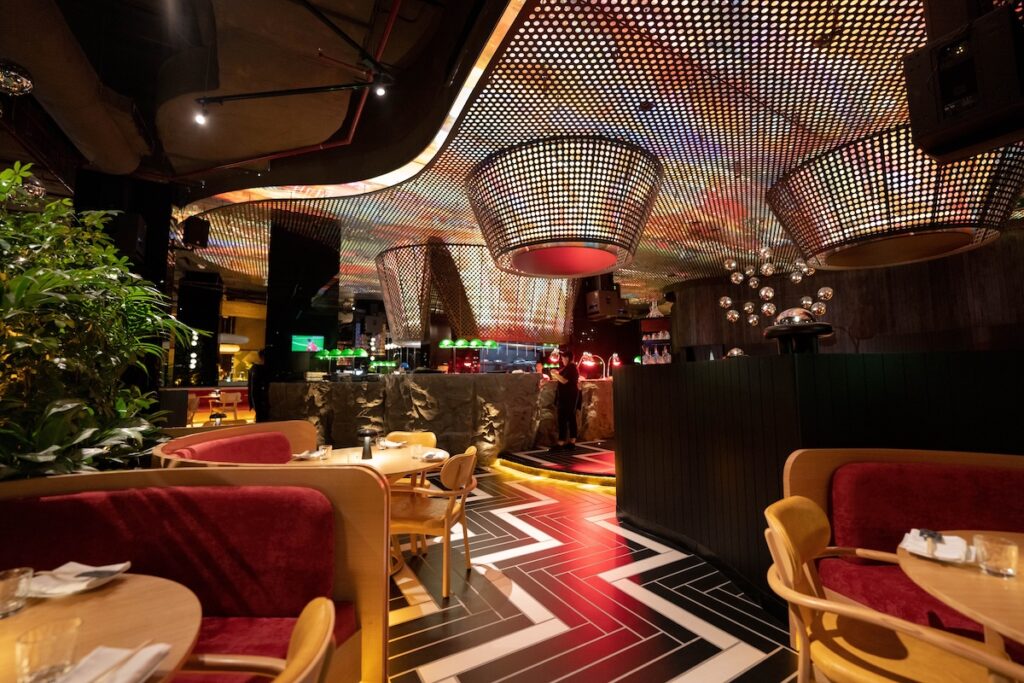
Pure Eats is an unpretentious neighborhood spot located next to one of the canals in the Qanat Quartier. It’s also Qatar’s first gluten- and dairy-free restaurant. Just along the quayside is a branch of Evergreen Organics.
For Qatari food, try Basta, a local chain that serves dishes such as lamb shank on rice or grilled local hamour fish, as well as biryanis. Baladna is a well-known dairy farming company in Qatar and it has a welcoming flagship Doha restaurant on Marbella Street in Medina Centrale. It opens early for breakfasts of salty cheeses, olives, eggs and Egyptian-style foul beans, switching up to shawarma and grilled meat dishes come lunchtime. You can also order Baladna trays that combine small portions of a variety of dishes from the menu.
Dazzling Chotto Matte specializes in Nikkei cuisine, that fusion between Japanese and Peruvian food cultures. It has branches in London and Miami, and in Doha you can find it at the St. Regis Marsa Arabia Island.
The coffee, cakes and brunches at Harvest are excellent. It is worth visiting Harvest for the location alone, facing out across the bay.
Lusail
Lusail is a new city, built almost entirely from scratch on the sands north of Doha in recent years. The city was originally conceived in 2005 but development properly took off in 2010, when Qatar was announced as the host of the FIFA World Cup 2022™. While still a work in progress, Lusail already stands as a showpiece for sustainable development. It has a range of eco-friendly features, from water-sensitive landscaping plans to sophisticated cooling systems designed to save millions of tons of CO2 a year.
Lusail has its own identity, reinforced by a series of unique landmark structures. The instantly recognizable twin-horned Katara Towers are an architectural translation of Qatar’s national seal, representing traditional scimitar swords. The Marina Twin Towers look like colorful Lego blocks and there are two stunning suspension bridges with circular central pylons, appearing like a pair of giant bicycle wheels hovering over the water.
Lusail’s prime attraction for visitors is its waterfront setting, which is utilized to great advantage by a lengthy marine promenade and the ongoing development of a series of causeway-linked islands as cultural and entertainment destinations.
Much of the city is already linked by Lusail’s own tram system, which currently runs between the Place Vendôme mall in the north and Legtaifiya station on the greater Doha Metro in the south. Later this year, the line should be extended to connect up with Lusail Boulevard.
Marine Promenade
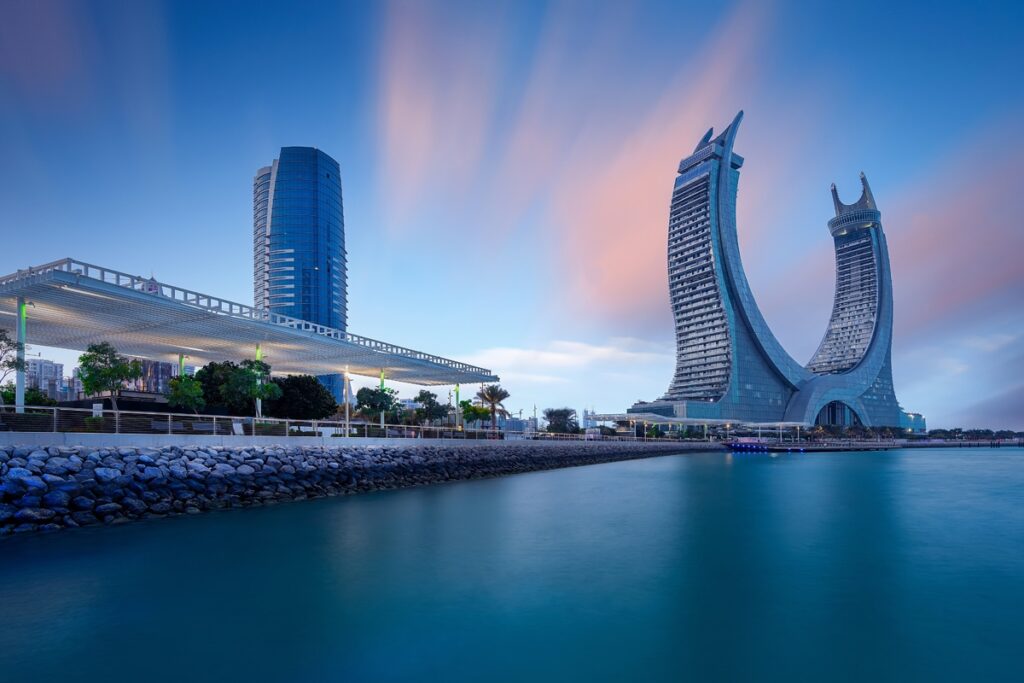
Lusail is fringed by a 3km-long waterfront promenade that runs from the southern edge of the city, near the Lusail Expressway, north up to Al Maha Island. It is attractively landscaped with planted sections, pavement fountains, viewing platforms, and public art, and the route is punctuated with pop-up coffee and snack stops. Everything is beautifully lit at night. Landmarks on the promenade include the now-iconic ‘I ¤ LUSAIL’ sign, which is just to the south of the Katara Towers (which houses Doha’s Raffles and Fairmont hotels), the food arena, and the clamshell-like structure of the Yacht Club. At its northern end, the promenade curves onto Al Maha Island, but the intention is to extend it a further 3km north to link up with Lusail Boulevard at Al Sa’ad Plaza.
Al Maha Island
Launched in late 2022, Al Maha Island features entertainment, high-end dining, and beaches. It is dominated by the Ferris wheel belonging to Lusail Winter Wonderland, a funfair with more than 50 attractions including thrill rides, which is open from November to March. A string of waterside pavilions houses a line-up of swish eateries including Zuma and cult international French restaurant LPM, while on the coast of the island is the elite Nammos Beach Club. The island is also set to be the home of the Lusail Museum, which, when it opens in 2029, will house the world’s largest collection of Orientalist art.
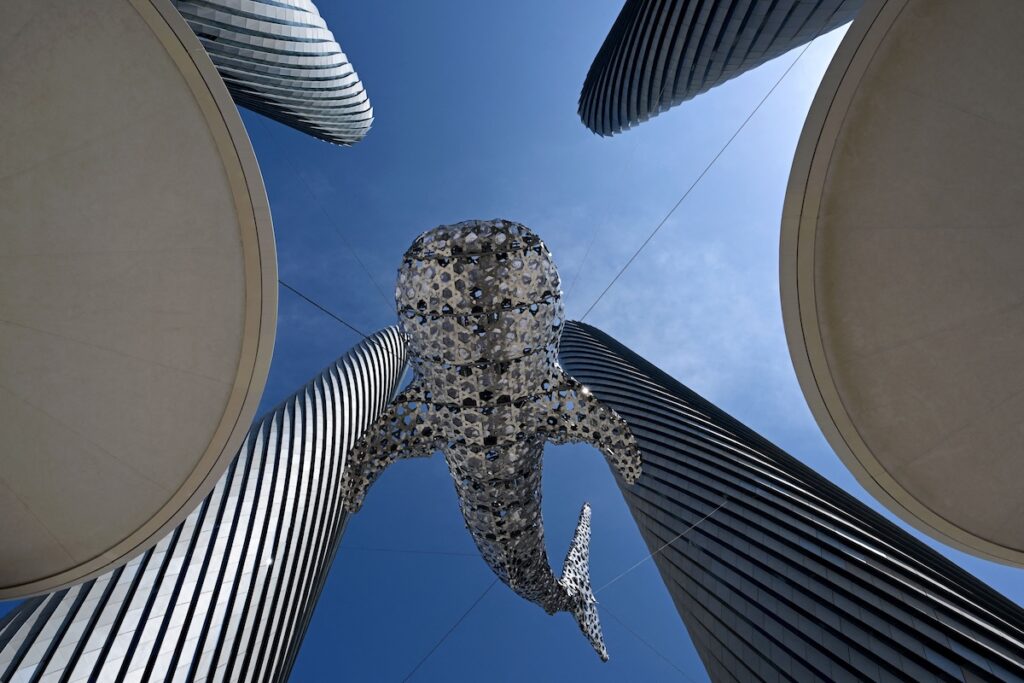
Stretching for more than 1km between Lusail Metro and the sea, the Boulevard is a vast, gleaming avenue modeled on the Champs-Élysées in Paris. It is lined by geometric buildings of uniform height, which are illuminated at night by a dazzling grid of lights. The Boulevard meets the sea at Al Sa’ad Plaza, which is dominated by Lusail Towers—a quartet of spiral-scored, aluminum-clad skyscrapers, designed by the UK’s Foster + Partners (who also designed Lusail Stadium, at the opposite end of the Boulevard, just north of the Metro).
Public Art
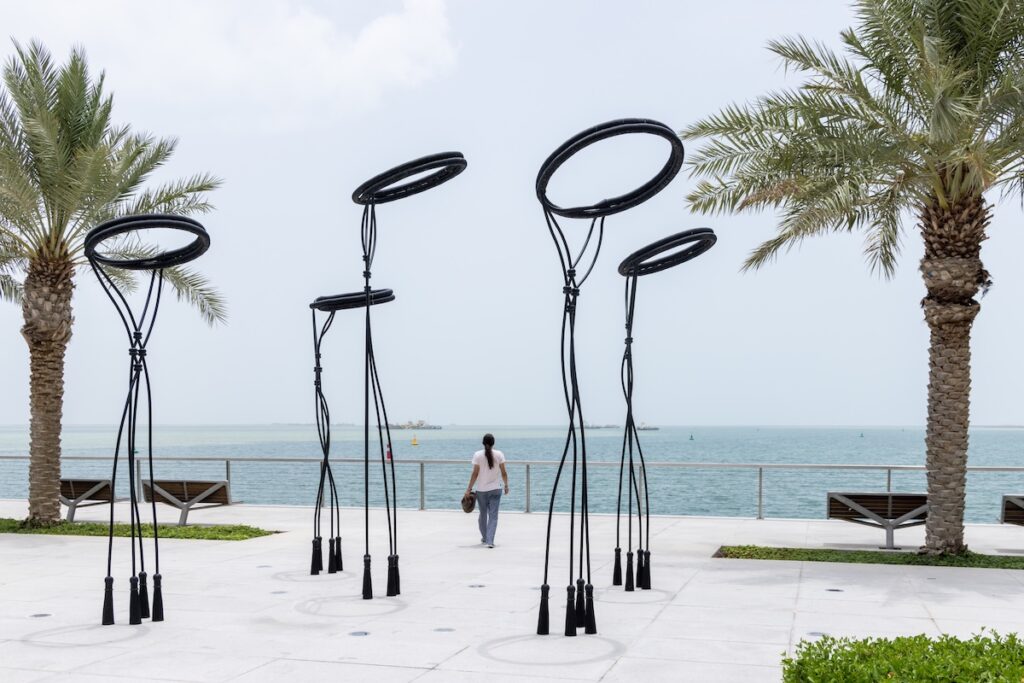
On the promenade beside Katara towers, Egal (2022) is a work by local artist Shouq Al Mana. The egal is traditionally worn by Qatari men as a headpiece and is part of their national attire. The subtle tilt of the egal is a symbol of respect and appreciation. Near to Crescent Park is Memory of the Arches by Lebanese artist Saloua Raouda Choucair, which is a large bronze piece that is inspired by architectural forms and tropes of Morocco, particularly the arches and doorways..
Family Attractions
Crescent Park is a lush green space with themed playgrounds, water features, bike paths, seated areas, tree zones, play lawns, sunken gardens, and a wide range of sports facilities, including a football pitch, three basketball courts, two volleyball courts, three tennis courts, four bocce areas, a lawn bowling green, and bike trails. Lusail has a Drive-in Cinema, with weekend screenings—check dohafilminstitute.com for schedules. On Al Maha Island, Winter Wonderland is a funfair with more than 50 rides for all ages, along with a games arcade, an ice skating rink and a circus show. It runs from November to March. Over on Qetaifan Island North is Meryal, a water park with 36 rides, including the tallest water slide in the world. The park’s Icon Tower stands at 85m – just 11m shy of London’s Big Ben.
Shopping
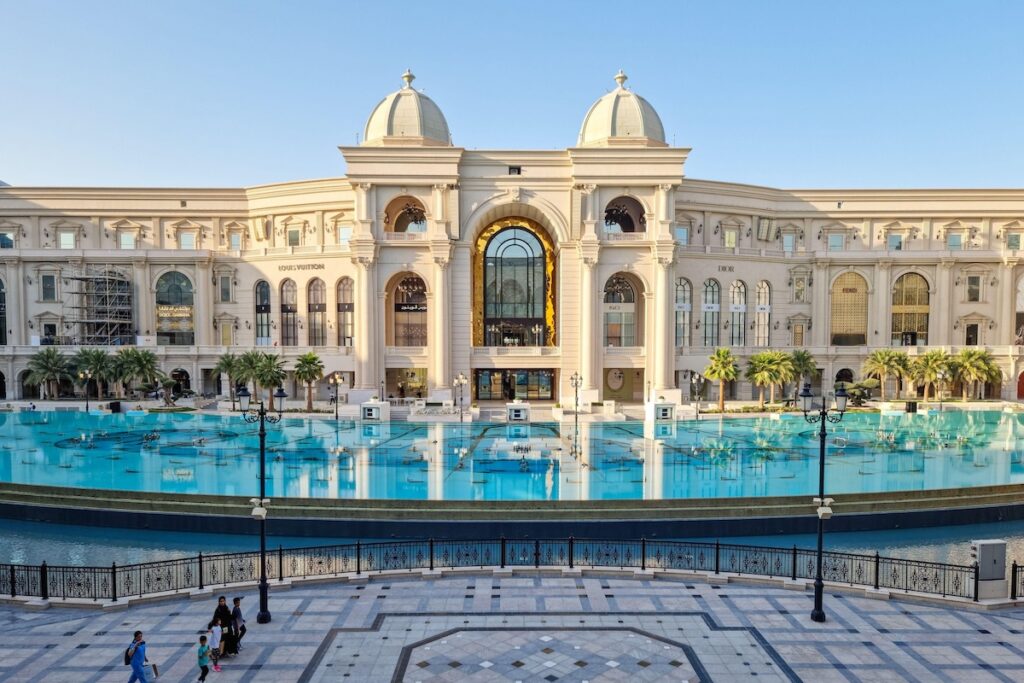
Opened in 2022, Lusail’s Place Vendôme is one of the most ostentatious malls in Qatar. Behind its super-sized Versailles-like facade are approximately 600 stores over four floors, ranging from Urban Outfitters and Levi’s to Manolo Blahnik, Bvlgari, Dior, Jimmy Choo, Tom Ford, and the biggest Louis Vuitton in the Middle East. A canal runs through the open-air plaza at the center of the complex, where there are also dancing water fountains and nightly 3D laser shows. For something more local and more boutique, there’s the My Space Café & Concept Store, which stocks items ranging from clothing to skincare. It’s at the Staybridge Suites on Marine Promenade Road.
Places to Eat
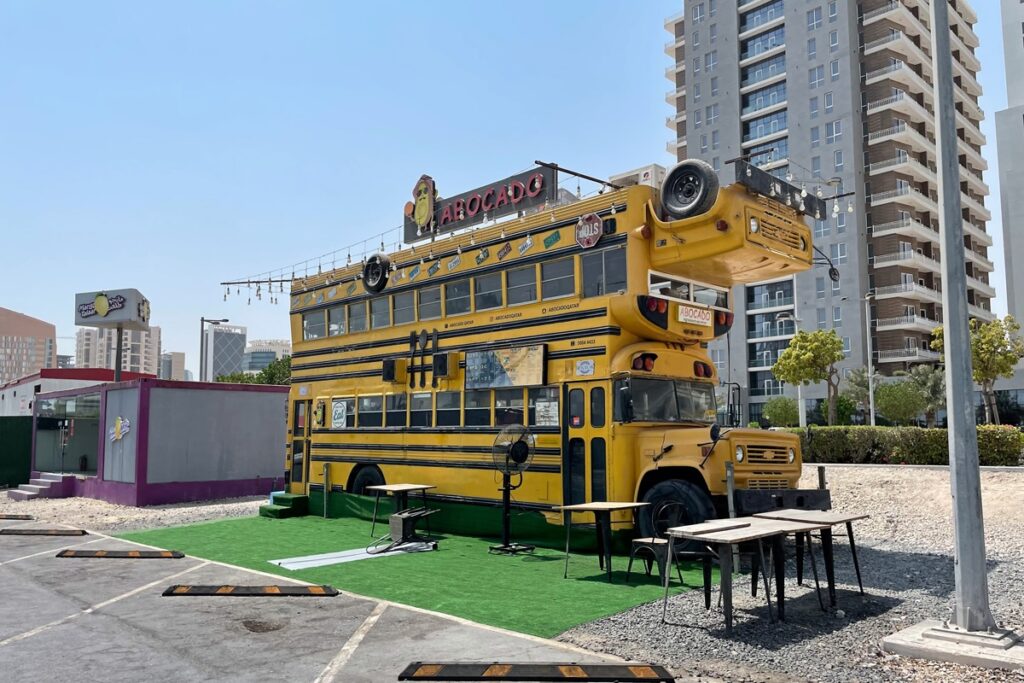
At the southern end of Lusail, on Street No.315, Calm Street is a cafe founded by a world-champion barista who used to work at Flat White. Not only is the coffee excellent, the cafe is a relaxing and architecturally interesting place to spend some time unwinding. Tea Time is a local chain specializing in karak, Qatar’s national drink; find it on the Marine Promenade. One of the most enjoyable places to eat is the Lusail Marina Food Arena, with nearly 70 food trucks selling everything from coffee and cake to burgers, Japanese savory soufflés, kebabs, mezze, and noodles. It is open 2pm–4am every day. The current dining hotspot is Al Maha Island, which has a string of stylish establishments, headlined by achingly cool fusion Japanese restaurant Zuma and LPM, the cult chain that brings the seafood-heavy cuisine, fruity cocktails, and heady lifestyle of the Côte d’Azur to Doha.
Education City
Education City was inaugurated in 2003 following the opening of the Virginia Commonwealth University School of the Arts in Qatar. In the years since, the ‘City’ has expanded to eight universities, including the homegrown Hamad Bin Khalifa University and branches of five major American universities. The landscape surrounding the academic buildings is designed to conjure thoughts of campus greens and courts. At the heart is the Ceremonial Court and the Ceremonial Green Spine, which are multipurpose, open-air spaces shaded by intricate lattice work screens and a system of pergolas linked to an amphitheater and stage.
The campus is also home to the spaceship-like Qatar National Library, designed by Rem Koolhaas’s Office for Metropolitan Architecture (OMA), which, as well as serving the local student population, is a popular visitor attraction in its own right. Visitors are also drawn by the Mathaf: Arab Museum of Modern Art and some striking public art installations.
Further architectural highlights include the imposing National Convention Centre, designed by Japan’s Arata Isozaki, who sadly passed away in December 2022, and the extraordinary Qatar Faculty of Islamic Studies and Minaretein mosque, with its horn-like towers thrusting skywards. Another OMA building is the headquarters of the Qatar Foundation, which takes the form of a large cube with a facade of precast white concrete punctured on all four sides by a grid of small windows.
Other facilities include a 33-hole golf course, a landscaped park, stables for the breeding of Arabian horses, and the Education City Stadium, which was one of the venues for the FIFA World Cup 2022™.
All of the major sites in Education City are connected by two air-conditioned tram routes, which also link up with the Doha Metro.
Mathaf: Arab Museum of Modern Art
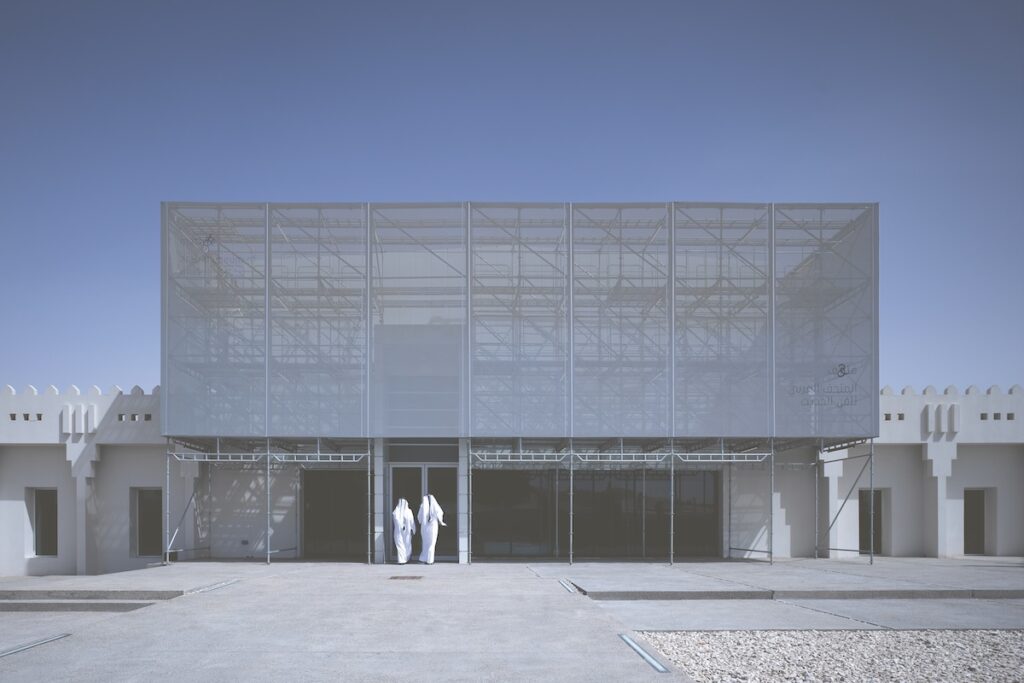
In 2010, Mathaf (Arabic for “museum”) became the first institution of its kind: a museum dedicated to modern and contemporary art from the Arabic-speaking world. Its main objective is to document and archive Arab artists and, in doing so, raise them to the same prominence as their global artistic counterparts.
The museum is housed in a former school building, adapted for its new use by French architect Jean-François Bodin. The facade has a large screen stretched over scaffolding on which imagery and videos can be projected at night. There are two floors of gallery spaces: upstairs is the permanent collection, assembled over three decades by His Excellency Sheikh Hassan bin Mohamed bin Ali Al Thani, a cousin of the Amir. It covers art from the Arab world, the wider Middle East, and parts of Africa and Asia that are historically connected to Qatar, such as India. Mathaf’s ground floor is used for temporary exhibitions, and the museum also has a research library, gift shop, and cafe.
Qatar National Library
A library might not be top of everyone’s sightseeing list but the Qatar National Library is something special. It looks spectacular from the outside and the inside is even more breathtaking: visitors enter via a vast, light-filled atrium, with the books arranged on stepped rows, like the audience in an amphitheater. Robots sweep along the rows, putting books back in their correct locations.
A sunken labyrinth below the main building holds historical documents from various worldwide institutions including, but not limited to, the British National Archives and the Ottoman Library. It is a vision of what a 21st-century library should be. The library also hosts regularly changing temporary exhibitions.
Education City Mosque
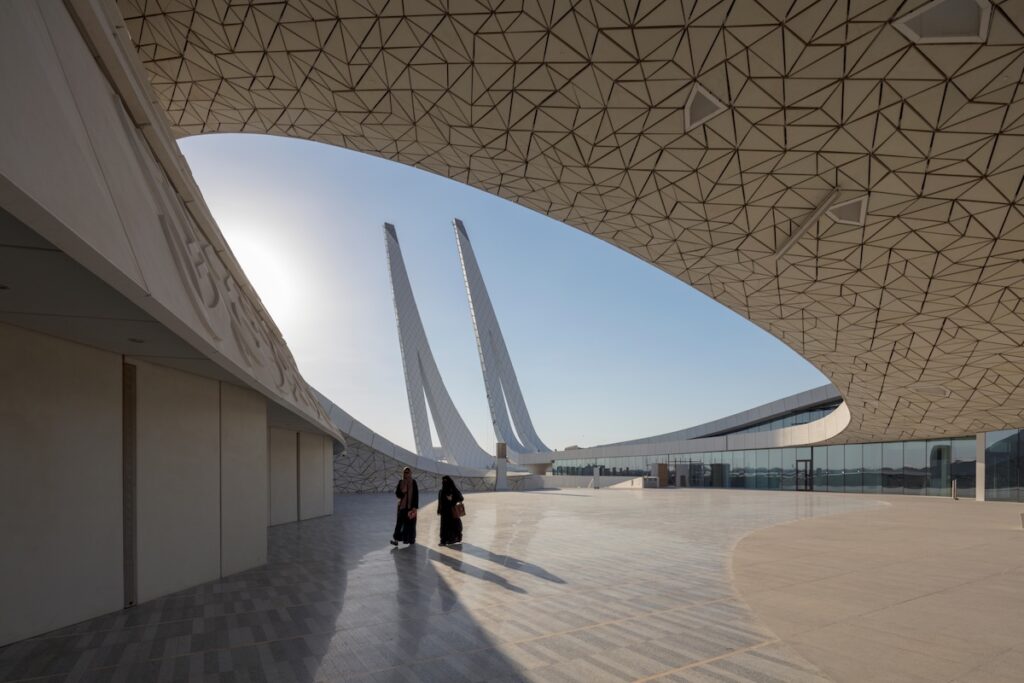
Located in the Minaretein building and part of Hamad Bin Khalifa University’s College of Islamic Studies, the Education City Mosque is a stunning revisualization of a modern center of Islamic worship. Designed by Iraqi architect and calligrapher Taha al-Hiti, the mosque’s twin minarets feature vertical calligraphy that sweeps upward, taking the viewer’s eye heavenward in a contemplation of faith. The mosque is supported by five pillars, each representing one of the pillars of Islam.
Four streams water a garden in the center of the building, representing the four rivers of Paradise promised in the Holy Qur’an. The complex also houses a Botanic Garden, which contains plants mentioned in the Qur’an. Individuals from all backgrounds are welcome to visit.
Oxygen Park
At this park, the temperature is always a few degrees cooler than elsewhere, thanks to its computer-modeled topography, which funnels the wind for natural air conditioning.
The park is divided into two zones, one for sports and one for recreation; the latter includes a children’s playground, an amphitheater, and gardens.
Al Shaqab
This is an equestrian center dedicated to promoting the Arabian horse and setting the highest standards in horse welfare and breeding. It offers public tours of its spectacular horseshoe-shaped complex. Whether you’re into horses or not, the setting—with its pretty waterfalls and canals, carefully pruned trees and gleaming spa facilities—is stunning. Visits must be booked in advance at alshaqab.com.
Public Art
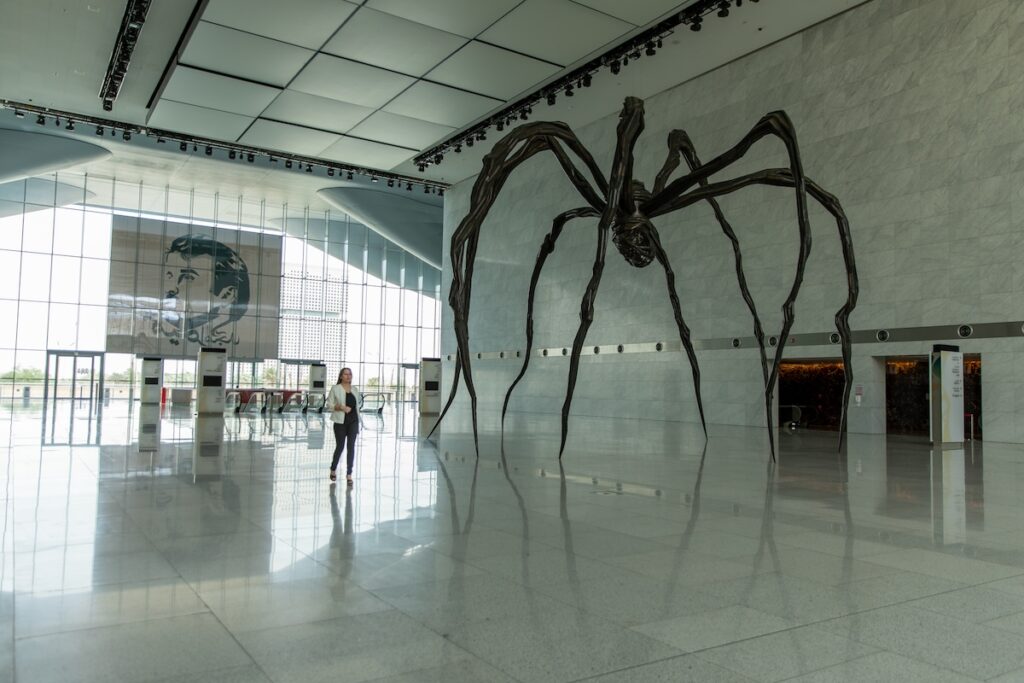
Education City is the venue for some of Doha’s most striking examples of public art, including M.F. Husain’s Seeroo fi al Ardh (Travel Through the Earth). Indian by birth, Husain was known as the “Picasso of India”. He spent his final years living in Doha, taking Qatari residency in 2010. His Seroo fi al Ardh tells the story of the progress of human civilization through the history of the Arab region. It is housed in its own permanent building, just a short walk from Mathaf.
The atrium of the National Convention Centre is menaced by Maman, a magnificent bronze giant spider by French-American artist Louise Bourgeois. The public is not allowed into the building without an event pass but if you ask security nicely, they should let you in.
Just along from the Convention Centre is The Miraculous Journey: a series of 14 monumental bronze sculptures by British artist Damien Hirst that chronicle the gestation of a fetus inside a uterus, from conception to birth. It ends with a statue of a 14m-tall baby boy. This extraordinary site-specific work sits in the median strip of the main road that passes in front of the Sidra Medicine hospital for women and children, and across from the Weill Cornell Medicine school.
Inside the foyer of the Georgetown University Qatar Campus is a large painted piece of the Berlin Wall, originating from 1975 to 1980.
Shopping
On Saturdays, Education City is host to Torba Farmers Market. Set outdoors in the majestic Ceremonial Court, the market is made up of small businesses that feature healthy or organic food, including vegan crepes, olive oil, sugar-free granola, and freshly made sourdough bread.
Places to Eat
Chef’s Garden is one of the few organic restaurants in Qatar. All dishes are made with nutritious, local ingredients, sourced directly from organic farms. It is open for breakfast, lunch, and dinner seven days a week. There is also the excellent Safahat Coffee Bar and Bakehouse at the Qatar National Library, along with a separate canteen.
The Aspire Zone
The Aspire Zone is a district west of central Doha, established in 2003 as a center of sporting excellence in preparation for the 2006 Asian Games, for which Qatar was host. At the heart of the district is the Aspire Tower— at 300m high, it was the tallest structure in Doha until 2023. It was built to house the 2006 Asian Games Flame and is now the luxurious Torch Hotel.
Adjacent is the Khalifa International Stadium, the home of football in Qatar, which was comprehensively upgraded for the FIFA World Cup 2022™. Part of the refurbishment included carving out 19,000 sq m of gallery and administration space for the 3-2-1 Qatar Olympic and Sports Museum.
Around the stadium are several world-class sporting venues, including the Hamad Aquatic Center, which has two Olympic-size swimming pools; the Aspire Dome, which is the world’s largest indoor multi-purpose sports hall and contains 13 different playing fields; the Aspire Academy, a sporting academy for youth; and Aspetar, a specialized sports medicine hospital.
Other amenities include the vast green spaces of Aspire Park, with its large lake, and the Villaggio Mall and Hyatt Plaza Mall, which offer entertainment, dining, and, of course, plenty of shopping opportunities.
3-2-1 Qatar Olympic and Sports Museum
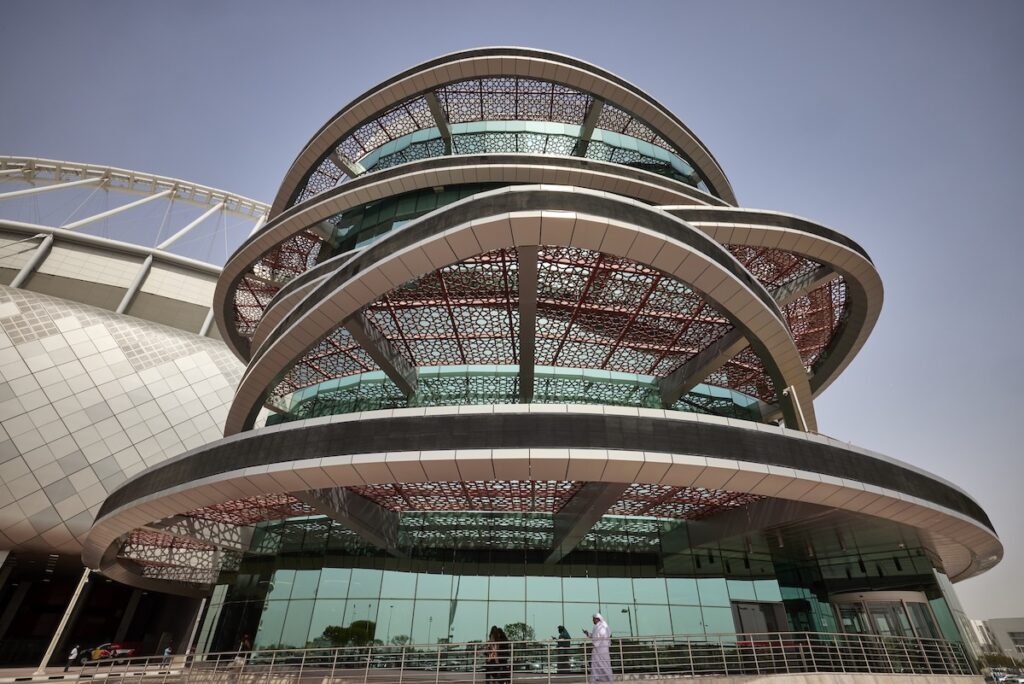
The museum is partially housed within the Khalifa International Stadium. The entrance is a five-story spiral designed by Spanish architect Joan Sibina. It sets a fun tone for visitors, with an approach ramp that looks like a running track and rings around the building that glow in the Olympic colors at night.
The galleries start on the top floor, tracing sport’s evolution from early hunting practices through to the invention of the rules-based games of today. The story then moves on to all things Olympic, where a highlight is the dramatically lit gallery displaying every torch from the Summer and Winter Olympics from 1936 onwards, when the torch was introduced at the Berlin Games.
The museum’s Hall of Athletes showcases some of the world’s greatest sporting stars, including household names such as Usain Bolt and Michael Jordan. Most are represented by autographed items—a baseball bat and ball signed by Babe Ruth; a cricket bat signed by Sachin Tendulkar; shirts worn and signed by Pelé and Roger Federer; the tennis racket Steffi Graf swung at the French Open in 1999, when she beat Monica Seles in the semi-finals; and the gloves worn by Cassius Clay (Muhammad Ali) in his first heavyweight title fight against Sonny Liston in 1964.
The final section of the museum is the Activation Zone: visitors collect a wristband then play 18 interactive games. Each of these is designed to test hand-eye coordination, strength, reactions, decision-making, and the participant’s ability to work in a team. At the end, visitors swipe their wristbands at a kiosk to find out how well they have done.
The museum has its own public art, including a site-specific installation by Daniel Arsham, made up of all the balls used in sports around the world.
Aspire Park
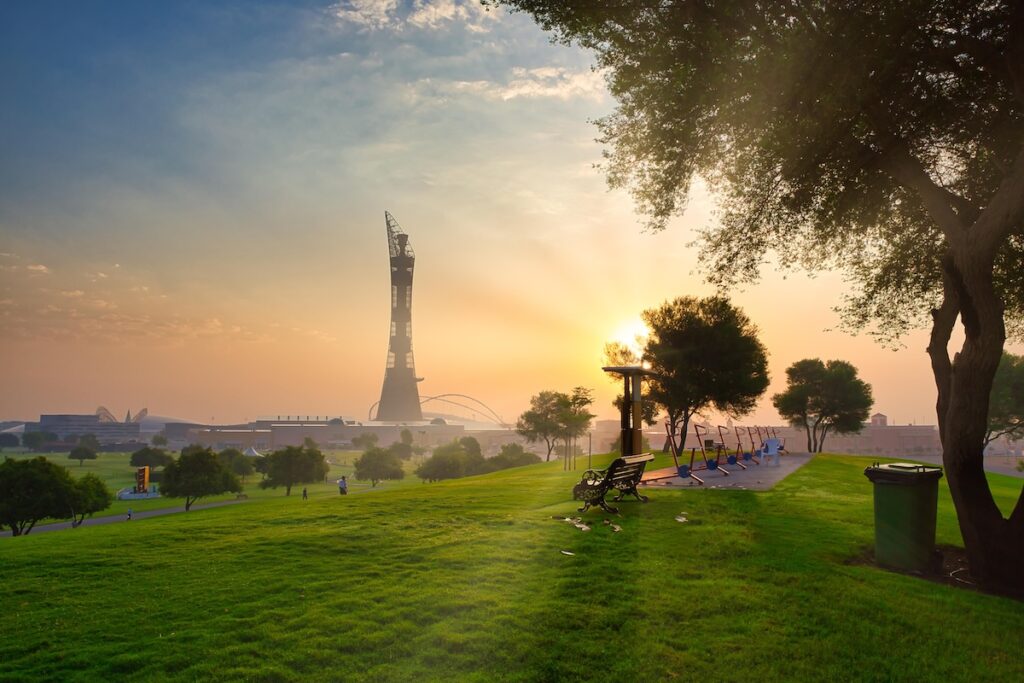
Doha’s largest green space, Aspire Park, contains running and walking tracks, football fields, playgrounds for children, a large lake, and several cafes and eateries. The lake is spanned by two bridges, one of which passes beneath arching fountains. For anyone who wants to get out on the water, there are pedal boats, kayaks, and water-walking balls for rent.
The park has a unique collection of exotic trees from all over the world, complementing local trees replanted here from all around Qatar. Also in the park is Perceval by British artist Sarah Lucas, a life-size bronze sculpture of a shire horse pulling a cart loaded with two oversized squashes. At night, the park is lit by solar-powered lighting.
The Touch
The distinctive 300m-high tower that rises above the Aspire Zone was constructed for the 2006 Asian Games, and was originally known as the Aspire Tower. It is currently occupied by the upscale Torch Hotel.
The hotel has a rotating restaurant on the top (47th) floor that offers a particularly spectacular view by night.
Family Attractions
Aspire Park has plenty of children’s playgrounds and play spaces for older kids, plus boating on the lake. There is also the Aspire Trampoline Park and the nearby Hamad Aquatic Center, where the Olympic-quality facilities are open to the paying public.
Gondolania, which is housed within the Villaggio Mall, is a family entertainment center with an Olympic-sized ice skating rink, Venetian-inspired gondola boat rides, a bowling alley, laser tag, roller glider, rollercoaster, go-kart track, and a 4D theater, with seats that respond to on-screen motion. There is also an IMAX cinema in the mall.
Shopping
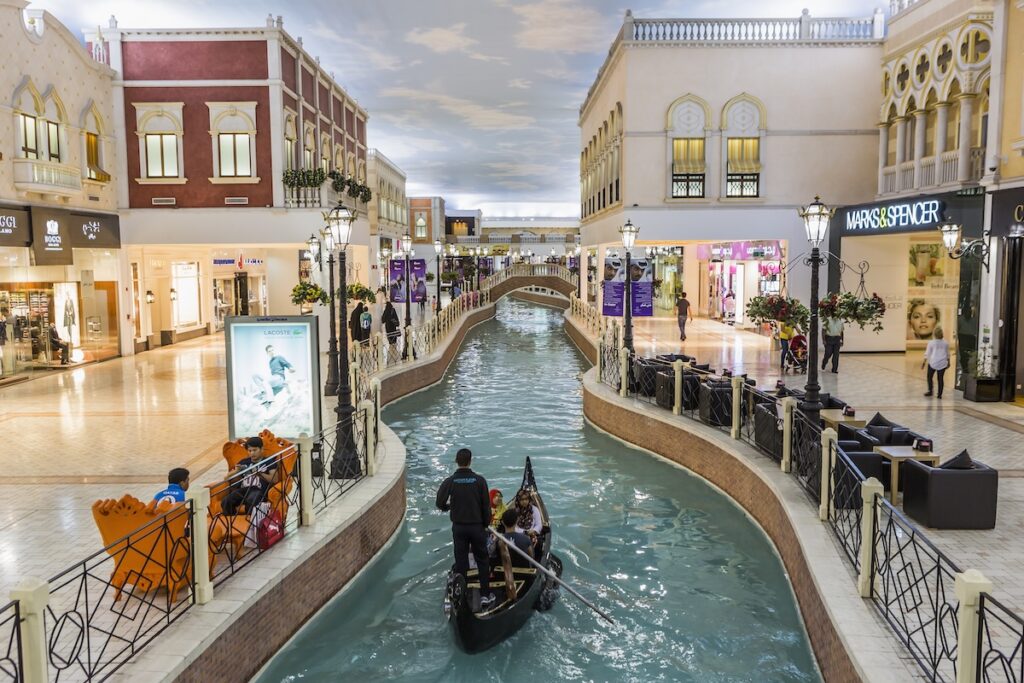
Villaggio Mall is designed to evoke Venice, complete with an indoor canal and gondola rides. The gondolas take shoppers along one wing of the mall, depositing them by Via Domo, which is a high-end “street” filled with luxury stores including Dior, Dolce & Gabbana, Fendi, Gucci, and Louis Vuitton. Elsewhere, Villaggio offers more mainstream shopping from the likes of Foot Locker, Gap, H&M, and Superdry.
Not far from Villaggio, the Hyatt Plaza Mall also offers more down-to-earth shopping.
Places to Eat
Much-loved Qatari brand Burgeri started as one of the country’s first food trucks, before expanding to a bricks-and-mortar location on the edge of Aspire Park—you can dine in or drive through. In 2021, Burgeri opened a London branch. Inside the Hyatt Plaza Mall, Canaan Gardens offers solid regional food, including Palestinian specialties. For dessert, try Sugar and Spice, but order carefully because one dessert here will easily feed three.
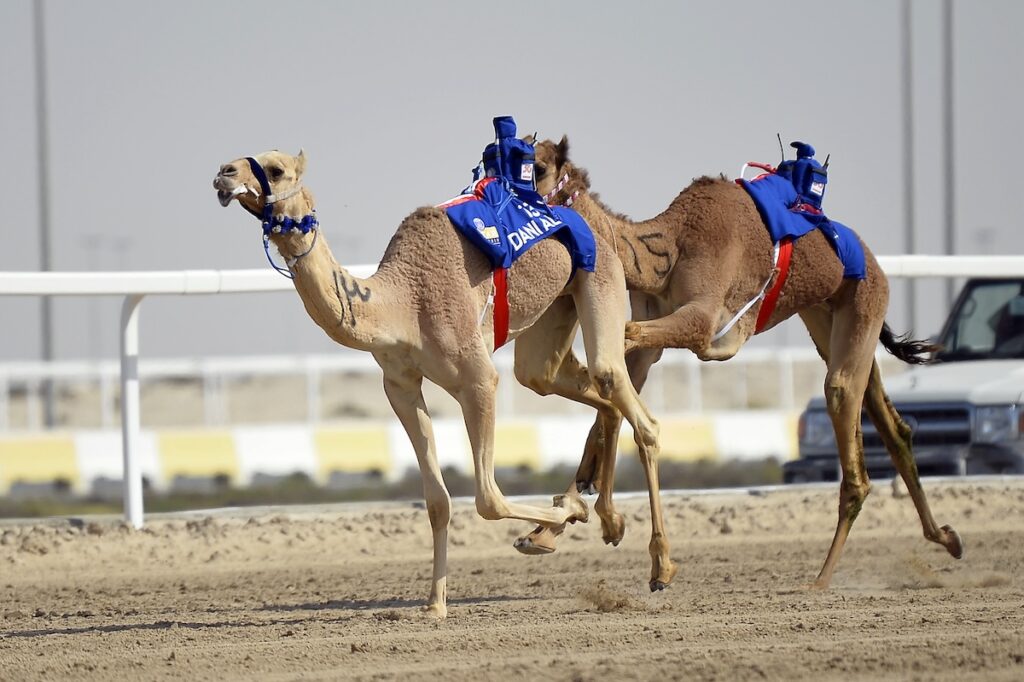
Al Rayyan
West of the current Doha city limits is the neighborhood of Ash Shahaniyah. The main reason many locals come here is to visit the Mall of Qatar—the country’s biggest shopping center, which resembles a small town. It is full of international franchises, with a few local brands, and is home to the excellent Eataly, a deli and eaterie that stocks produce from regions across Italy. It also has the largest IMAX cinema in the region. Another reason for many locals to visit is for Ash Shahaniyah Camel Race Track; races take place each winter, from November to March. The animals are ridden by remote-controlled, toddler-sized robot jockeys, clothed in colorful racing silks. The camel owners race alongside in their 4x4s on a separate car track. Even when there are no races, visitors are welcome to stop by any morning, to take a look around the stables and watch the camels training.
Sheikh Faisal Bin Qassim Al Thani Museum
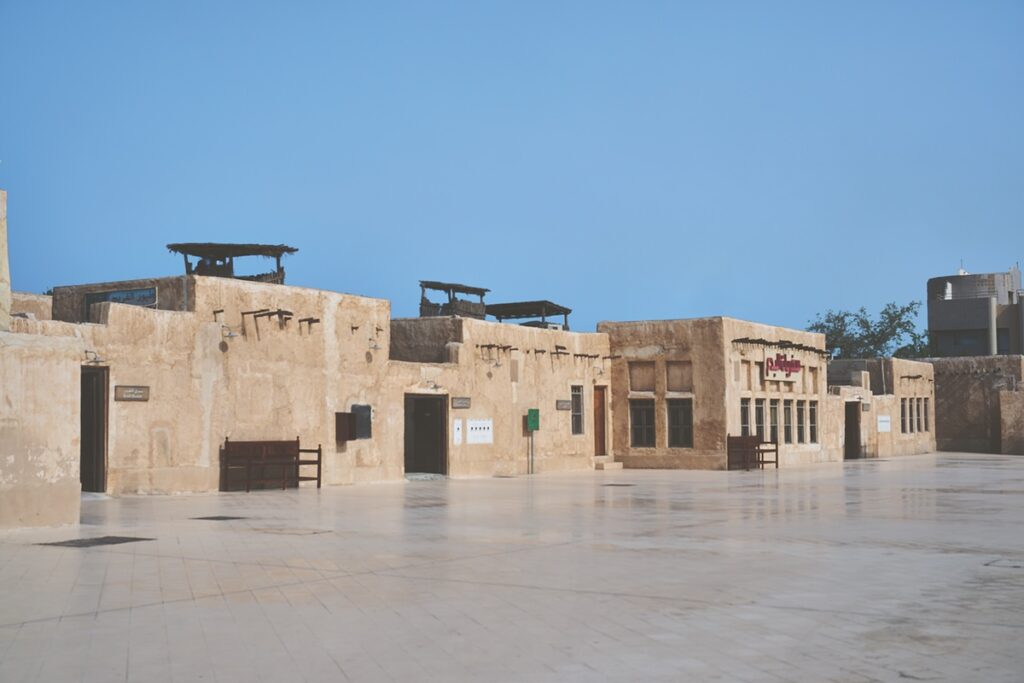
Signposted by a leaning mosque and minaret is the imposing stone complex that houses one of the world’s largest private museums. The main collection relates to Qatar and the Islamic world and ranges from Jurassic-era mineralogical relics to arms and armor, costumes, dhows, ceramics and metalwork, and even a twin-engined aircraft. Highlights include a traditional Syrian home from the Ottoman era, imported in pieces from Damascus and reconstructed on site, complete with a courtyard and two living spaces; a Qur’an room, which also has an example of a Liswa, the cloth which covers the Kaaba, Islam’s holiest site; and over 700 carpets. A second and no less impressive collection features more than 600 vehicles, with everything from steam cars and painted Pakistani buses to vintage American convertibles.
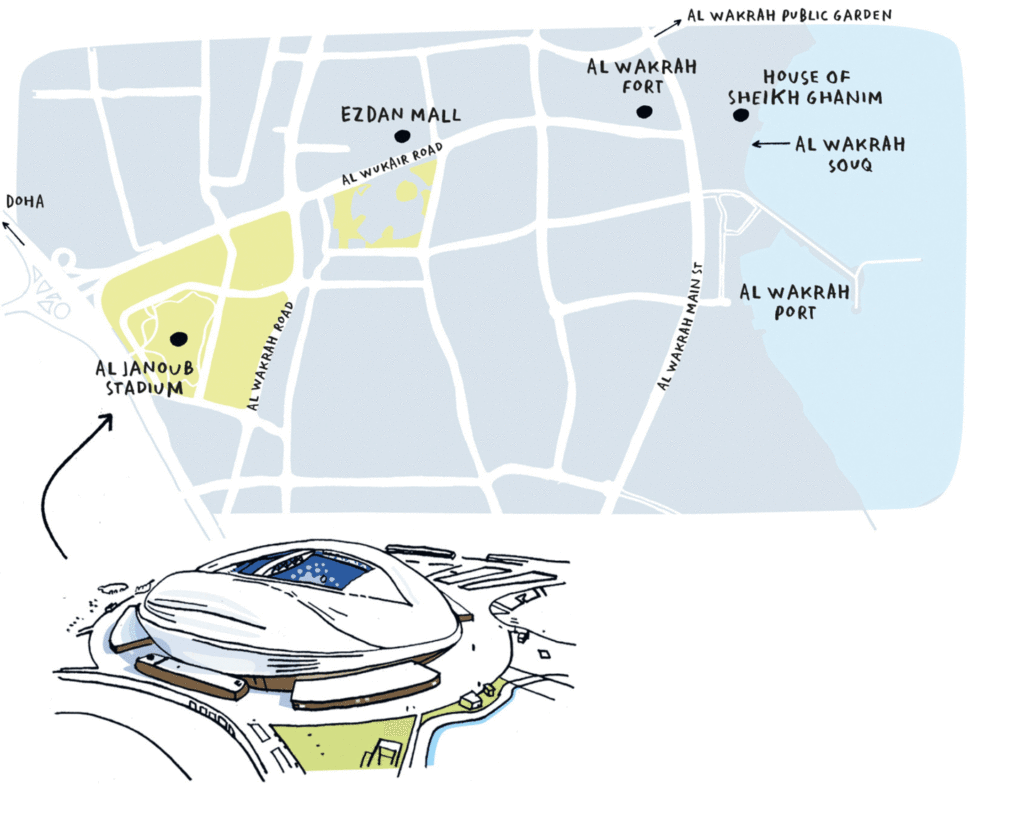
Al Wakrah
Al Wakrah is approximately 15km south of Hamad International Airport. It was originally a small fishing and pearling village that, at the start of the 20th century, had a fleet of around 300 dhows. In recent times, it has undergone extensive development and growth and is now the second largest urban center in Qatar—due to its proximity, it’s now almost a suburb of Doha.
However, Al Wakrah retains its own identity. What was the old heart of the town has been extensively rebuilt and rebranded as Al Wakrah Souq. It is a highly picturesque cluster of low-rise, traditionally-styled buildings, linked by a network of twisting alleys. Doors lead into courtyards that serve as open-air cafes and restaurants, or are the shared space for groupings of shops. It is like a smaller, calmer version of Doha’s Souq Waqif, with the added attraction of being beside the sea.
Al Wakrah’s beaches are the best within easy reach of Doha, while Sealine Beach—a short drive south—has some of the country’s most spectacular sand dune ranges.
Al Wakrah Souq

What was the old town—now Al Wakrah Souq—comprises more than 100 structures that mix residential, commercial, and retail. The Souq runs for more than a kilometer in a north-south strip bounded to the east by the beach and to the west by an expanse of car parks. The buildings are low-rise with mud-coated walls, palm-leaf ceilings, large wooden doors, and lantern lighting. It is a beautiful place to wander, particularly at dusk when the air cools and the street lamps come on. Among a handful of notable structures is the Abu Manaratain Mosque, which, despite its name—meaning the “mosque with two minarets”—only has one minaret. There is a fascinating fish market on the western edge of the Souq, with more than a dozen fishmongers.
The Souq is fringed by a 3km-long Corniche, which is a popular place for an evening stroll beside a broad beach of fine white sand. At the southern end of the Corniche, beyond the seashell roundabout, is the port and dhow harbor, where much of Qatar’s fishing fleet is based.
Housed in the Souq, Embrace Doha is dedicated to showcasing Qatari culture and heritage to non-locals. Guests are welcomed into a large, rug-covered space around which several small rooms serve as galleries of Qatari heritage and crafts. Embrace Doha offers sessions and courses covering coffee ceremonies, sadu weaving, mixing traditional fragrances, and Qatari cookery. There is also a small boutique that sells a range of locally made goods.
To find Embrace Doha from the car parks, start at the main plaza at Souq Al Wakrah and walk directly east—it is signposted on the right.
West of Souq Al Wakrah, the town’s old fort houses a small museum, displaying artifacts of marine life and local history.
Family Attractions

Just south of the port, Al Wakrah Beach is exclusively reserved for families. Note: swimmers must wear modest swimwear. Al Wakrah Park, which is north of the Souq, is a fine place to let the kids run around in a beautiful landscape of trees and lawns.
Places to Eat
The Corniche is lined with cafes and restaurants. Among them, Easair has a lovely, laid-back beachy feel and does an excellent all-day Qatari breakfast. Royal Tandoor, also on the Corniche, is a branch of a popular Qatari North Indian restaurant. Best of all though are the fish restaurants that fill two courtyards, close by the fish market. Choose your fish or seafood from a chiller cabinet, then have it spiced, grilled, and delivered to the table with bread and rice. Prices are all clearly displayed on boards. For dessert, there is a branch of the Arabic sweets and pastry specialist Al Aker back on the Corniche.
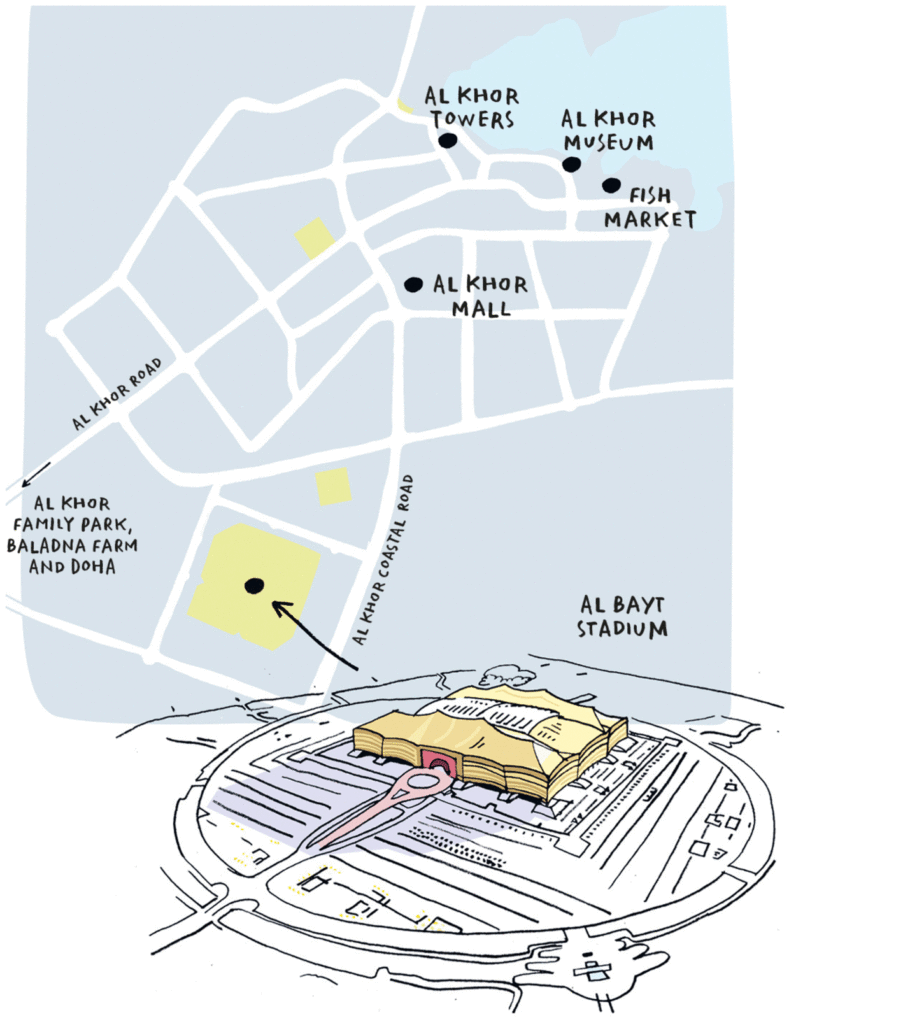
Al Khor
Al Khor is a city around 30 miles (50km) north of Doha. It has a pedestrian-friendly center with a pleasant corniche, a historic and lively souq, and a small dhow yard. It is also the location of Al Bayt Stadium, which was one of the venues for the FIFA World Cup 2022™.
The area around Al Khor is well worth exploring. Within the bay to the north of the city is Bin Ghannam Island. Recent excavations revealed millions of crushed sea snail shells, which produce a reddish-purple dye—the color of the Qatari flag, which is why Bin Ghannam is also known as “Purple Island”.
The island is fringed by mangroves, which can be explored by kayak. Its spectacular natural beauty makes it the ideal place to birdwatch, walk in nature, and spot a variety of marine animals. Al Khor is also a good area for cycling, off-road biking, and hiking. For the ambitious, a dedicated cycle route connects Al Khor and Doha, complete with 80 cycle-parking points, 100 benches, and 20 resting areas.
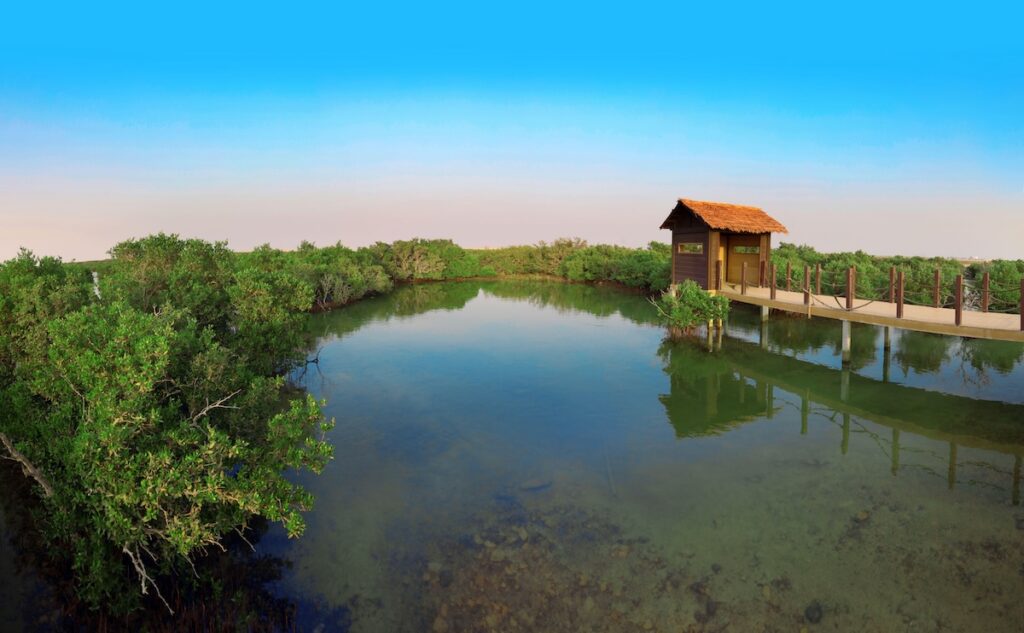
The Corniche
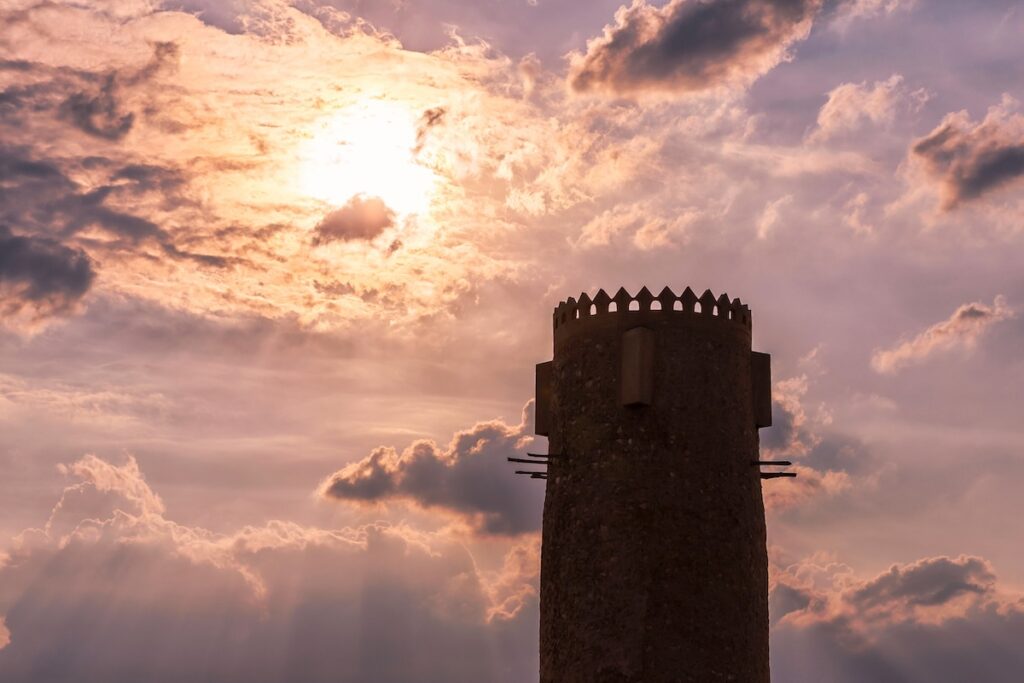
Al Khor has three stone towers, constructed around 1900, which were used to monitor ships and guard access to the well of Ain Hleetan, the main water source that sustained life in Al Khor. The towers are cylindrical in shape, with thick stone walls and an observation platform on top. Find out more about the towers and other aspects of local history at Al Khor Museum, a two-story restored building along the Corniche. The ground floor contains an anthropological section, a section on marine and land life, and a section covering the traditional fishing, pearling and shipbuilding, for which the town is renowned. The top floor offers good views of the harbor and bay. Entrance is free.
Baladna Farm
Baladna was originally a sheep and goat farm but during the Blockade (when Saudi Arabia, the United Arab Emirates, Bahrain, and Egypt severed diplomatic relations with Qatar from June 2017 to January 2021), imported milk supplies from Saudi Arabia were halted, so cows were imported to the desert to help Qatar become self-sufficient in dairy products. Today, visitors can experience life on a real working farm, where there is also an amusement park, petting zoo, horse riding, and a high-wire obstacle course. There is also a restaurant serving meat and rice dishes, plus all kinds of dairy produce.
Family Attractions
Al Khor Family Park is a fine place to let children run around in a beautiful landscape of flowers, trees, and lawns. There are play areas, water features, snack stalls, and also a zoo, with lions, tigers, bears, monkeys, and more. The park also has a dedicated Panda House, the first of its kind in the Middle East. Its residents are two giant pandas named Soraya and Suhail, who arrived from China in 2022.
Simaisma, to the south, has one of the best family beaches, with showers and parking spaces for visitors. Al Thakira beach, near Al Thakira Island, north of Al Khor, is set among the mangroves. These can be viewed from a scenic promenade.
Operating from a dropzone just west of Al Khor is Skydive Qatar, a world-class skydiving facility that caters for new (with tandem jumps) and experienced jumpers alike.
Shopping
From the outside, Al Khor Mall looks like an oversized take on a traditional Qatari fortress; inside, it has more than 100 international and regional budget-friendly stores, as well as a food court, cinema, and family entertainment center.
Places to Eat
As mentioned, Baladna Farm has an unmissable restaurant: try the shawarma platter, featuring tiny chicken wraps doused with pomegranate, molasses and garlic sauce. In town, Shaqab Bakery is the place for manouche (flatbreads), which come hot from the oven, served with a choice of toppings, including spices and salty cheese.
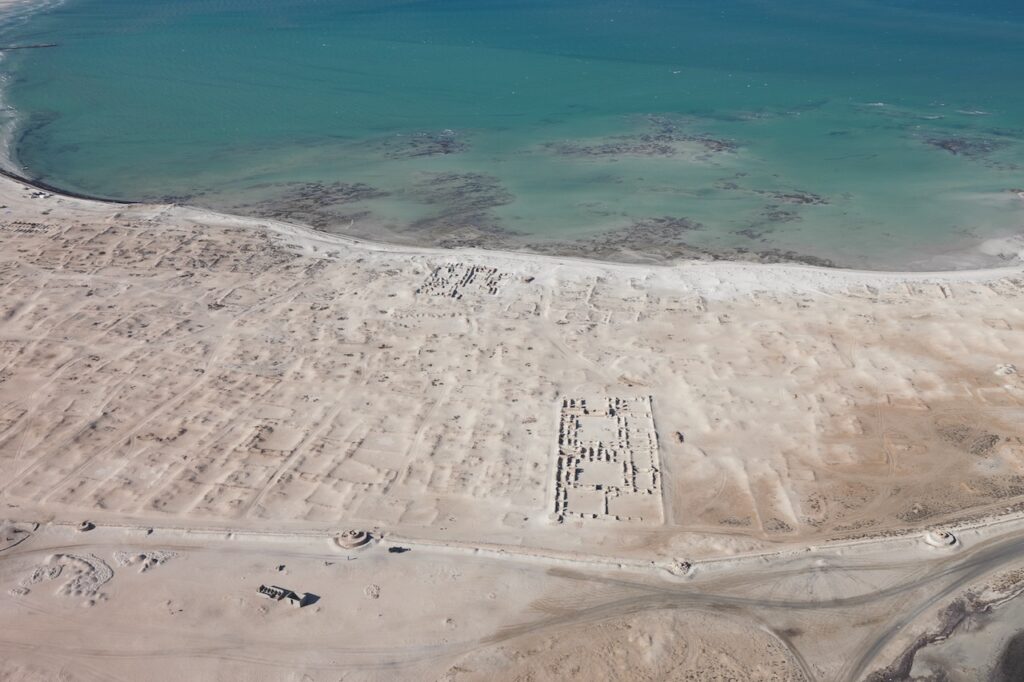
The North and West Coast
The north coast of Qatar has a particularly rich heritage. Evidence for this exists in the form of several fascinating archaeological sites and numerous heritage villages, houses, forts, and palaces. The north is one of the most rewarding parts of the country to visit. This can be done as a day trip, or there are plenty of options if you wish to stay overnight. As well as heritage sites, the north has several striking examples of public art—some installed in the run-up to the FIFA World Cup 2022™. There are also numerous options for outdoor activities, including kite surfing, kayaking, sailing, and paddle boarding.
Excavations in the country’s far-west have uncovered many significant archaeological artifacts, while places such as Ras Abrouq and Zekreet also have beautiful limestone rock formations.
Al Zubarah
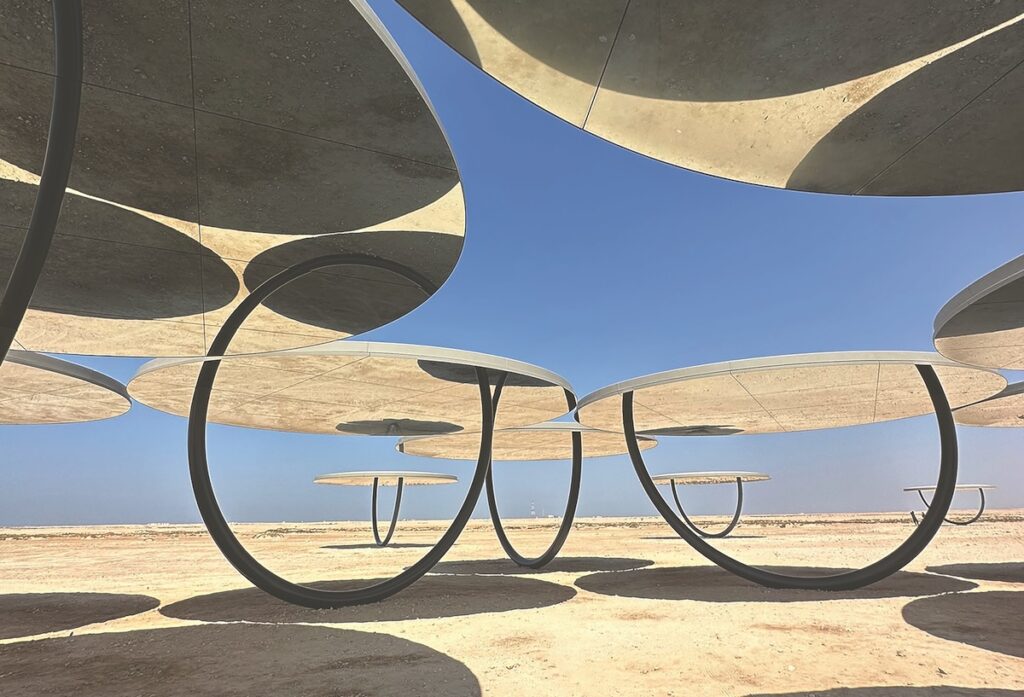
Al Zubarah is a UNESCO World Heritage Site in northern Qatar and one of the most significant heritage sites in the country. At its peak, the once-thriving 17th-century pearl trading port had an impressive city wall, residential palaces and houses, markets, mosques, and a fort. It was destroyed in 1811 and completely abandoned by the early 1900s.
Now, the ruin—which has been protected by a layer of sand—is in the process of being excavated and the town’s story is being told. The archaeological remains provide an invaluable insight into early urban planning and traditional Qatari building techniques. Digs here have also uncovered evidence of the harmonious coexistence of different cultures and ethnic groups. Recently, the whole Al Zubarah site has been upgraded with new boardwalks and viewing platforms, plus information signage and digital displays that give an interactive element, enhancing the visitor experience.
There is also a well-restored fort, which dates from 1938 and the reign of Sheikh Abdullah bin Jassim Al Thani. The fort was used as a coastguard station until the 1980s, before being transformed into a small but informative museum. However, later in 2024, a new visitors’ center will be inaugurated at nearby abandoned village Ain Mohammed, 3.5km north of the fort. It will have a new museum with three galleries, a multimedia hall, an education center, amphitheater, cafe, and gift shop.
Also at Ain Mohammed is a heritage village with tents for overnight stays, providing an immersion in Bedouin culture.
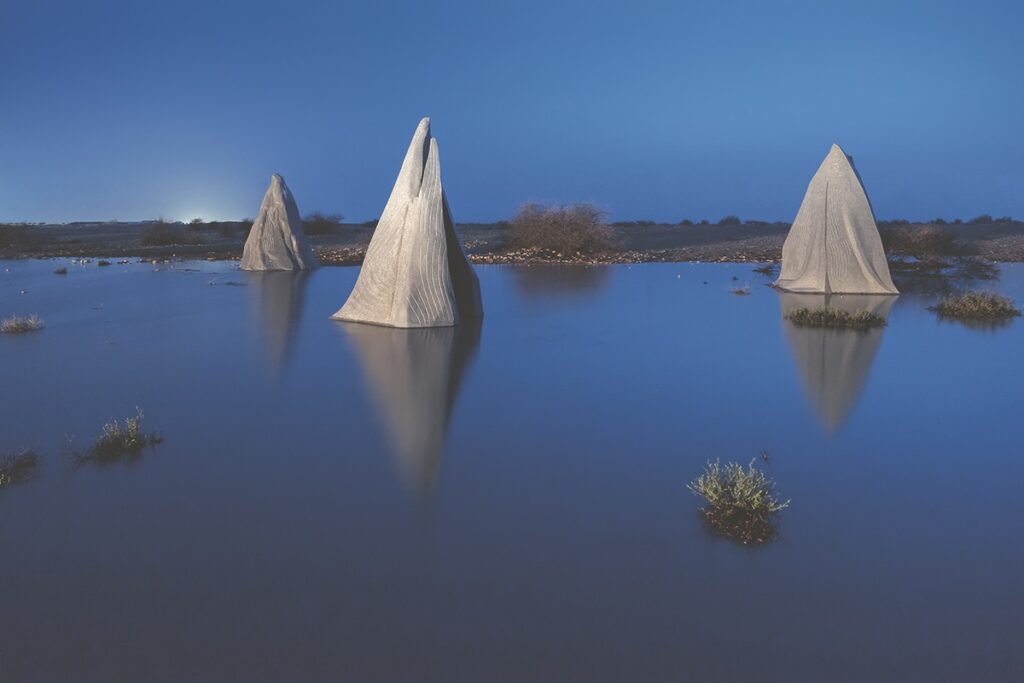
Just before Ain Mohammed, on the right if you are coming from Al Zubarah, are two pieces of public art: for Maqam I, Maqam II, Maqam III (2022) Lebanese artist Simone Fattal (b.1942) has created three monumental sculptures that appear to be geographical landmarks, or maybe tents. Close by is Slug Turtle, TemplEarth (2022) by Brazilian artist Ernesto Neto (b.1964), an immersive installation composed of eight football goal frames in an octagonal ring, centered on a ceramic earth globe sculpture and surrounded by a vast surface made of white crocheted netting.
like surface of the desert (best tackled in a 4×4) ending in a makeshift car park from where it is a five-minute walk to another installation, in this case by renowned Icelandic-Danish artist Olafur Eliasson (b.1967). Titled Shadows Travelling on the Sea of the Day (2022), it comprises 20 circular shelters with mirrored undersides reflecting the curved segment of pipe that supports the roof. This creates an illusion of the pipes as full rings, linking the real landscape with the reflected space. Visitors view themselves and their surroundings reflected in the roofs above.
Al Jassasiya
Fascinating rock carvings or petroglyphs can be found at around a dozen sites along Qatar’s coast, but the largest concentration (almost 900) are on a low limestone ridge at Al Jassasiya, north of Doha. Discovered in 1957, experts believe they are thousands of years old. The most common motifs are round holes, but what they represent is unknown. Some are carved in a seemingly random order, while others are cut in rows and feature rosettes and stars. There are also carvings of boats, fish, scorpions, ostriches, and footprints.
Zekreet and Ras Abrouq
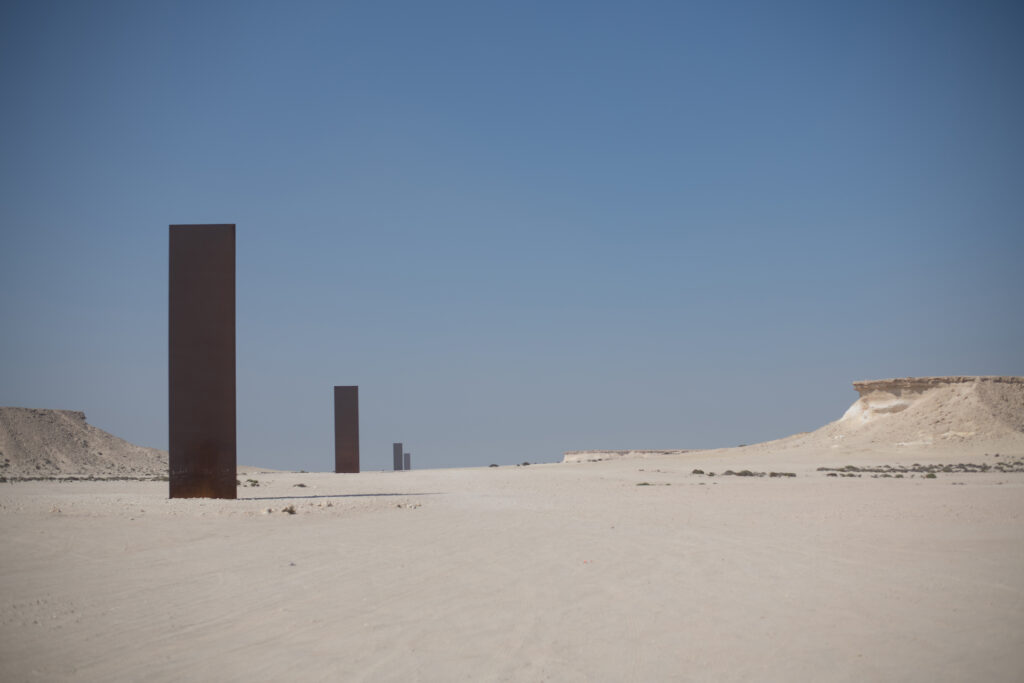
Zekreet is a village on the west coast of Qatar, approximately 90km from Doha. It has the remains of Zekreet Fort: only the lower courses of the walls remain, but the rectangular plan of the fort can clearly be made out, as can the outlines of the corner towers. Back in the village, Zekreet Mosque dates back to 1940 and is built in a traditional, simple fashion with a rectangular prayer hall fronted by an arcade and a large open courtyard.
North of Zekreet is Ras Abrouq, with its landscapes of sandy canyons fringed by white cliffs, and strange mushroom-shaped rock formations. This is the setting for one of Qatar’s most other-worldly pieces of public art. Created by American artist Richard Serra (b.1938), East-West/West-East takes the form of four monumental vertical steel plates, each more than 14m in height, spaced at irregular intervals in a straight line over a kilometer of empty desert landscape.
